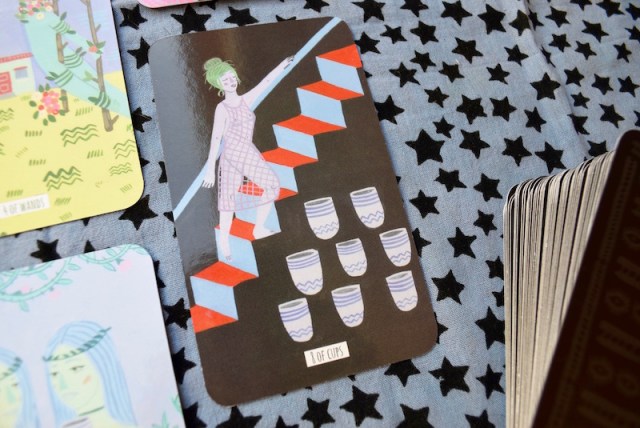Fool’s Journey: Same Card, Different Decks
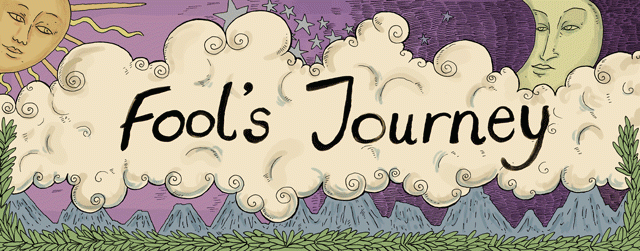
Header by Rory Midhani
Here’s a simple exercise that can help you to go deeper into the meaning of a tarot card: comparing the same card from two different decks. Checking out the diverse ways that artists interpret and represent your chosen card provides interesting new angles and ideas, and helps you to develop your own personal meaning for the card.
When I first started learning tarot, I had my trusty, classic Rider Waite Smith deck and that was it. I hadn’t really clocked that there were other decks out there. It wasn’t until, a year later, I picked up Stephanie Piu-Mun Law’s Shadowscapes Tarot that I realised that you could interpret cards in different ways, that there wasn’t just ‘one set meaning’ for each card (i.e. the one I found in Joan Bunnings’ Learning the Tarot, and/or on Biddy Tarot.)
What a revelation! Law’s illustrations — so completely different to Pamela Colman Smiths’ — blew my mind with their deviance from my accepted ideas of each cards’ meaning. Just working with that one additional deck developed my understanding of the cards’ meanings in huge and important ways. Essentially, it taught me that each tarot card is open for interpretation, that it can mean different things at different times, to different people, in different contexts. Okay, that can be a little confusing when you’re starting out, but for me this was outweighed by the journalling possibilities and the opportunity to explore a card from different visual and symbolic angles. Thus, I feel that this is a great exercise for both tarot learners and more experienced readers…especially when you feel like you’ve hit a bit of a rut in your tarot practice, or have become complacent about your studies and think you ‘know’ the cards! It provides useful fodder for tarot journallers and bloggers, providing plenty of those wonderful “OMG, I never thought of this card that way before!” moments.
Below, I’ve compared and contrasted a few of my favourite tarot cards to give you an idea of just how different these depictions can be.
(By the way, you don’t have to go out and buy a new tarot deck to do this comparison exercise. Instead, you can use a Google image search to check out how other artists depict different cards.)
Cards shown are from the Rider Waite Smith Tarot, the Wild Unknown Tarot, the Circo Tarot, the Kitty Kahane Tarot, the Delta Enduring Tarot and Charissa Drengsen’s Steampunk Tarot.
Ten of Cups
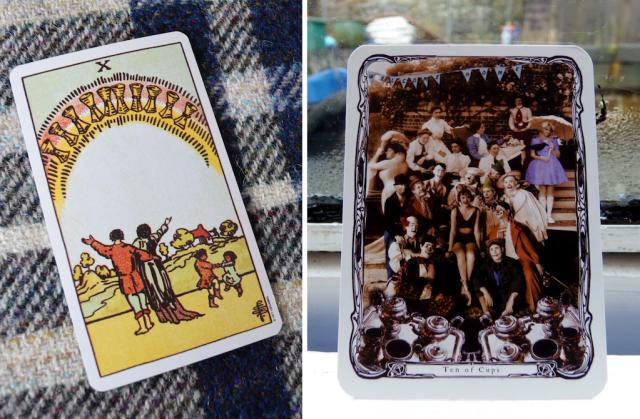
Nowadays, the Ten of Cups is one of the key cards in a deck for me, but I didn’t always feel this way. The Rider Waite Smith Tarot’s illustration of a happy heterosexual family, two kids dancing in front of a pretty red-roofed house wasn’t my idea of ’emotional fulfillment’, though I did my best to read it this way. The revelation, for me, came when I saw Clarissa Drengsen’s beautiful collage of circus freaks sitting beneath a ‘Welcome Home!’ banner in her Steampunk Tarot. That idea of homecoming came to form my strongest interpretation of this card: for me, it’s about a sense of coming home, emotionally, or spiritually. And when I see more conventional, heteronormative versions of this card appearing in my readings, I tend to interpret them more along the lines of ‘what society wants for you’ — family expectations for your happiness, for example.
Three of Pentacles

This is classically interpreted as a card for teamwork and community effort, which I really like. In many versions of the Three of Pentacles, we see a group of three people, working together on a joint project. However, I was able to take these ideas a little further by looking at other versions of this card. In the Circo Tarot, for example, an aerialist does her thing, whilst two others look on. I read this card as more focused on the individual discovering their unique talents and skills, then looking for ways to bring this to a greater whole. So it’s still about teamwork (here, that might be the circus as a whole show with many parts), but it’s a celebration of how each of us brings something special to that team. It’s about finding your niche, then using it together with others. By the same token, then, it can be about appreciating difference, and understanding that others are bringing their unique skills to your group project, too.
Strength
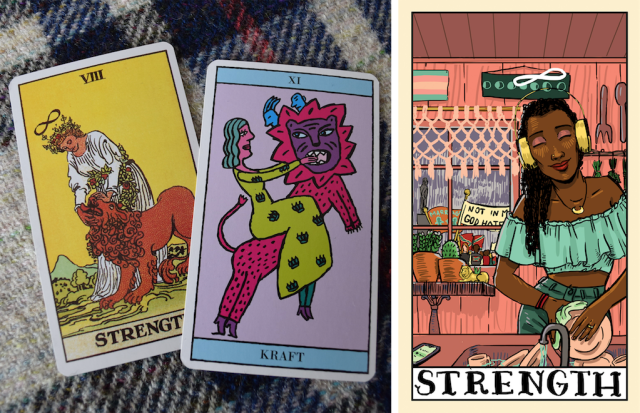
Strength is one of those cards that nearly always seems to bear the same kind of illustration no matter the deck: a lion, usually being ‘tamed’ by a young woman. The implication here, for me, has usually been about being in control of our reactions — the fierce, wild lion and the ‘gentle maiden’ both being present with in each of us, but we usually have a choice about the way we react to the world around us. We can react with anger, violence, or fear, or we can react with love and compassion, even in the face of oppressive and harmful shit.
Whilst I definitely feel there’s a place for this interpretation (I’ve learned so much from practicing this very thing of responding to hate and fear with love, rather than fuelling the fight with my own fear and anger) I was relieved to see an image from the forthcoming Delta Enduring Tarot created by Egan, which features a Black trans woman peacefully ignoring the haters outside her window and getting on with her life. I doubt that she is as blissfully unaware of the fear and hatred that surrounds her as her expression suggests, but Strength is major archetype: this is not so much about the moment, but about responding to hate with self-love and self-compassion. In this sense, it’s about the strength in boundaries. Again, this woman — and the community she represents — is not responding with fear or anger (at least, not in this moment). She’s not responding at all, except to put on her headphones, listen to music that lifts her up and strengthens her confidence, and get on with being her beautiful self.
Nine of Wands

Often, when I see this card, I see a person approaching burnout. A tired person, who may feel they have little left to give. The Nine of Wands is the card directly before the Ten of Wands, which really does indicate burnout, and as such it carries an implicit warning: take care of yourself right now, you’re at capacity, and maybe you need a break.
The Wild Unknown Tarot‘s version of this card feels different. There’s still a strong message of hard work, still a steep climb ahead — that ladder of branches doesn’t exactly look like a comfortable journey. But at the top, we see a crescent moon; a symbol of intuition. So here, this card has come to represent soul work, to me. It’s about that work and that tough journey being worth it. Where in the first card, we don’t know whether that tired person should quit now, go to bed, take a break, or battle on, here, it feels clear: keep going, it’s worth it. The goal at the end is more than the glory of a completed project, deeper than a battle won: that moon tells me that it’s about personal growth, too.
Seven of Swords

It’s hard to put a ‘positive’ spin on the Rider-Waite-Smith version of this card, which shows a shady-looking character sneaking away from a military camp at dawn, having stolen all of their comrades’ swords. Not that it’s necessary to put a positive spin on every card! It’s totally okay for this to simply mean ‘you’re being dishonest right now’ or ‘someone stole something from you’. However, there are other interpretations. Again, for me it was the Wild Unknown Tarot that really opened up my ideas about the Seven of Swords. I didn’t feel as though the little fox here was doing something dishonest, it was more that the image raised questions, like “why does she feel she has to hide that part of herself?” and “what does that hidden sword represent?”
In this way, the card becomes more complex in its meaning. It can be about whether you feel safe being yourself at this moment, or it might draw attention to a part of yourself or your personal truth that you’re not yet ready to share with the world. I can point to dishonest behaviour that is a survival tactic, or essential self-care, or a kindness to someone you love.
As you can see, comparing cards from different decks can provide a whole new set of symbols and ideas to reach back to when reading tarot — regardless of the specific deck you are using. For me, this exercise enriches my understanding of tarot and how it can represent our diverse lived experiences.
How about you? Is there a deck or artist that opened up the way you interpreted your cards? Let us know in the comments!
Follow Your Arrow: Queer Hairdresser Klara Vanova on Trust and Community
Here’s a frustrating cycle I go through about once a year: I decide it’s time to stop with the drink-a-bottle-of-wine-and-hack-my-hair-off thing, make like a real adult and find a hairdresser who will make me look — at least vaguely — like I have my shit together. I make an appointment at some trendy salon and turn up full of hope excitement that I’m finally going to get the alternative lifestyle haircut of my dreams and announce my queerness to the world. One hour later I leave the joint a precious 50 quid lighter and feeling frumpy, crestfallen and misunderstood. So I head home, grab the wine and the scissors, and start hacking away at that expensive ‘do until I feel a bit more like me again.
My guess is that at least, hmm, 75% of you will relate? So I’m ridiculously excited to introduce you to Klara Vanova, a London-based barber who serves the queer community with ridiculously stylish and affordable haircuts that make clients feel supported and understood. Her gender-neutral salon, Barberette, is a radical space indeed: it has the look and feel of a queer/DIY space, but is staffed by professional barbers who are passionate about giving you the haircut you actually want.
I took a trip to London last month, and my visit to Barberette was without doubt the highlight. After years of crushing hairdresser experiences, it was revolutionary to feel heard and understood in a hair salon. My barber, Rose, didn’t try to ‘feminise’ my request, or hold back in the places where I wanted a really close shave. I was so happy with my do I wanted to freeze time so it would remain that way forever!

In this month’s Follow Your Arrow, Klara shares the story of her gender-neutral barbershop business, how she made the leap from office-worker to sole-trader, and the importance of building trust in the community she serves.
Klara Vanova, barber and founder of Barberette
Age 37, London
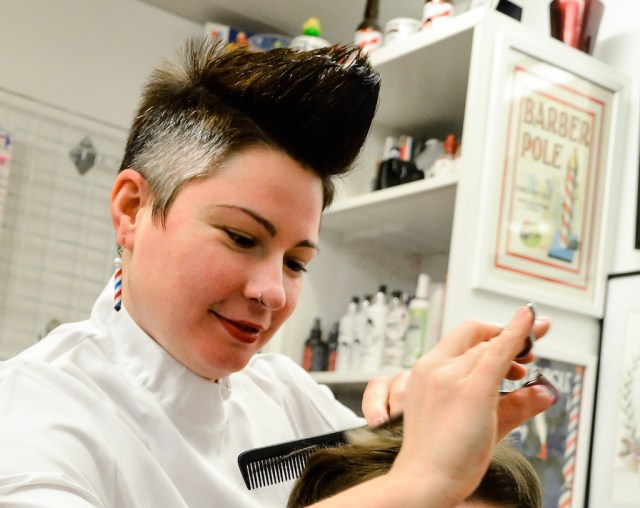
Barber Klara Vanova at work. Photo by Paula Harrowing.
Hi Klara! Can you introduce us to your business? What’s your mission? Who do you serve?
At Barberette we offer distinctive hair styles, cuts, colours and cut-throat shaves, specialising in sharp, sculpted shapes. Our pricing is gender-neutral: we charge on the basis of the work we do for you, not on your gender. We cover everything from quiffs to long hair, pin ups, flat-tops to razor shaves, decorative clipper work to colouring. Most importantly, we give you the cut you want: we have no boundaries or pre-set ideas about what is best for you.
Barberette is constantly working to challenge sexist pricing structures and this attitude of some salons who impose their own stereotypical ideas of what their clients want. We actively campaign for change across mainstream media (including the BBC, Modern Barber and Marie Claire) and we are in discussion with national hairdressing organisations and educational establishments to ensure that people of all genders, races and sexualities be made welcome, safe, equal and listened to, side by side in salons.
Barberette also has an active role in the Hackney community running pop-ups and sponsored cuts and shaves for charities such as Indigo, Opening Doors, Stonewall, Scope, Little Princess Trust, Moorfields Eye Hospital, Kith and Kids, Breast Cancer Awareness and homeless charities.
How would you describe your approach to self-employment or business? What personal qualities inform your approach?
I follow my heart, instinct and passion. But behind everything it’s hard work, organising, planning, trying to find the best way possible to achieve things. Also collaboration, guidance and lots and lots of time and dedication. Not only from me but the team behind Barberette — our barbers and colourist Mako and Rose, our social media person, plus creative partners and friends.
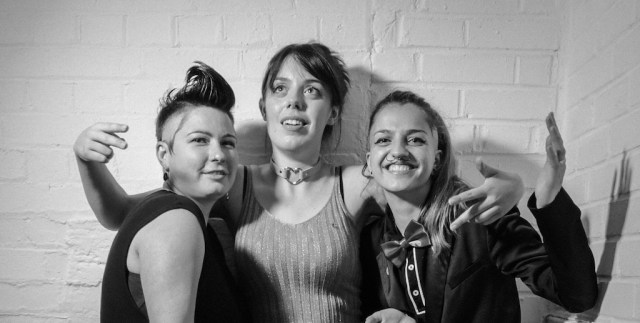
Rhe Barberette team: Klara, Rose and Mako. Photo by Niamh Murray.
What does a typical day look like for you?
I work most days. When you have your own business, there is no 9-to-5. I cut hair four days a week, 10 hours in the shop and two days are admin, organising, guiding, planning. Some weeks more, some less, depending on our extra projects.
How about your workspace? Barberette is such a lovely space to visit! How did you find your premises?
I spent a year and a half renting a chair in a barbershop with Barberette ethos in Camden Town before I found (online) a little studio tucked away in a Hackney warehouse. The space is small in size but has a huge community impact. We’re surrounded by various artists, hat makers, fashion designers, photographers, theatre and holistic spaces, coffee makers, a gin distillery and lovely cafe.
It’s also off-road which makes it a safe space for people who wanting more privacy or just a bit more quirkiness. I love the space because everyone contributes to how it looks by bringing flyers, artwork to exhibit (our exhibition changes every month), barbering tools as presents, painted portraits of us, you name it.
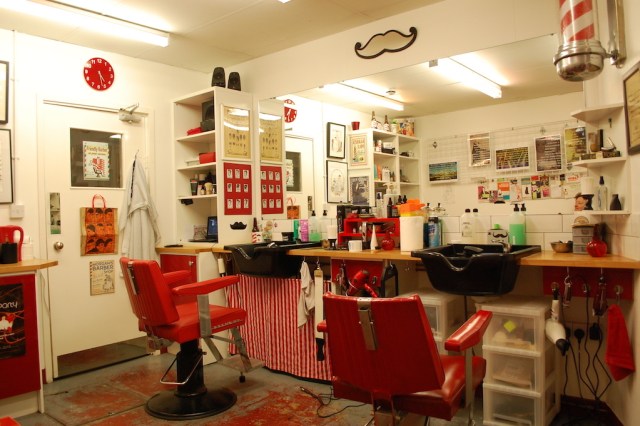
“Barberette is a safe space for everyone.” Inside the Barberette shop. Photo by Vibeke Venema.
When did you know that this was what you wanted to do? And what were your early goals, your first steps?
I grew up under my mum’s hairdressing legs. I loved the atmosphere, the smells, the community and the bond between the clients and their hairdressers. At the same time, I knew that it wouldn’t be for me the way it was for her — very gendered. I wanted to focus on short hair whatever the gender. I remember thinking about it when I was young, but I thought it would be impossible. I remind myself of this when I feel exhausted nowadays: to never give up your dreams and what you believe in.
What’s the best thing about the work you do?
Our clients’ smiles, their happiness, hugs after the haircuts, the trust in us and the stories shared. The feeling I have such a wonderful team around me. And the feeling you get when you do a great haircut.
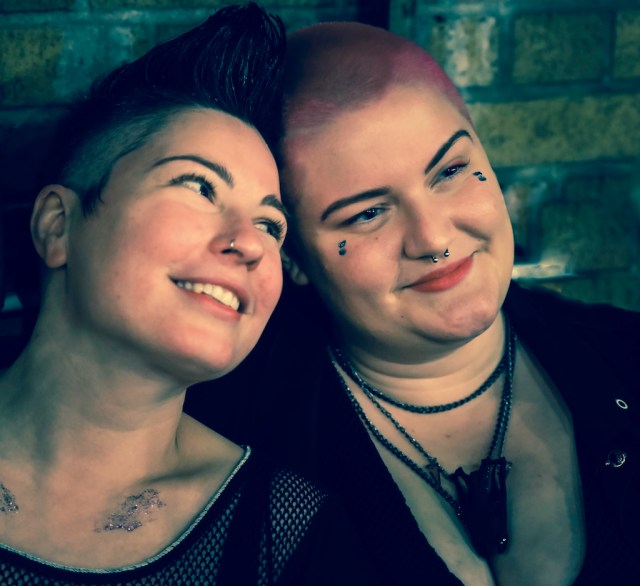
Klara with Barberette client Izzy.
And the worst?
Paperwork, no question.
What are the key challenges you face in your work? What are your tactics for overcoming these?
The greatest challenge is time management. There is never enough time in a day. So many ideas, projects and plans… it’s hard to make all of them happen. On a positive note, the beauty of having your own business is that there is always something new and exciting to do. Barberette is a life for me.
How do you approach time management?
Lots of notes, being very focused and regimented at work. I cannot say “I will do it tomorrow” because tomorrow there will be another task to complete. I think this makes a successful business owner: you have to be a doer.
And what about work-life balance? Has your social life been impacted?
I love what I do completely and my hobby is my business. I also have a wonderful and supportive girlfriend. But it didn’t just happen overnight. Sometimes I say to myself that business is like a computer game: when you complete one level, the next one opens up and you have to gather all your strength and do it again. I love it. It gives me a purpose in life. When I worked in an office, as a foreign person in the UK, I always wanted to prove something to someone. Now I’ve found my peace. I’m grateful for every day.
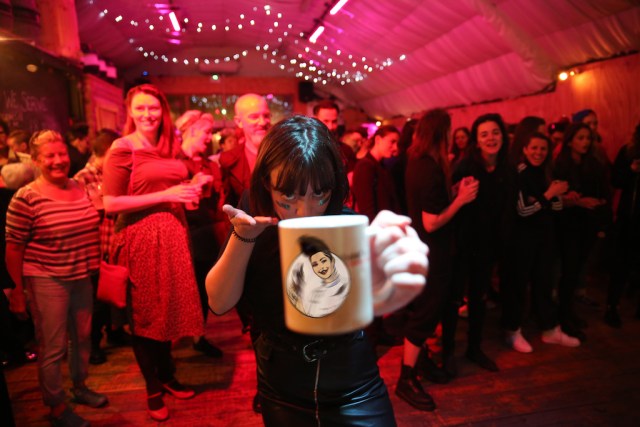
Barber Rose at a clients’ party Clients party earlier this year. Photo by Niamh Murray.
Can you tell us about your financial situation when you started out?
I started small and grew the business organically step by step. It’s a self-funded business and I’m very proud of that. I worked full-time in the office while renting a chair at weekends to build up my client base. After a while I worked part time in the office for three months. Then I had to jump, so I did. Risk is something that makes you appreciate your ability to push yourself harder.
Is your business sustainable now? How do you feel about the money side of ‘following your arrow’?
Yes it is and I’m happy that it benefits everyone. I’m proud that all the team are paid more then the London living wage. For me it’s important to look after and check on everyone’s well being. From clients to the staff. I call myself the socialists-capitalist. It works.
Where would you like to see yourself in five, ten years’ time?
Be healthy and working.
How do you market your business?
Word of mouth mostly. Which means we have to deliver 100% every single time. It keeps our skills up to scratch.
What’s the most valuable tool in your kit?
My hands.
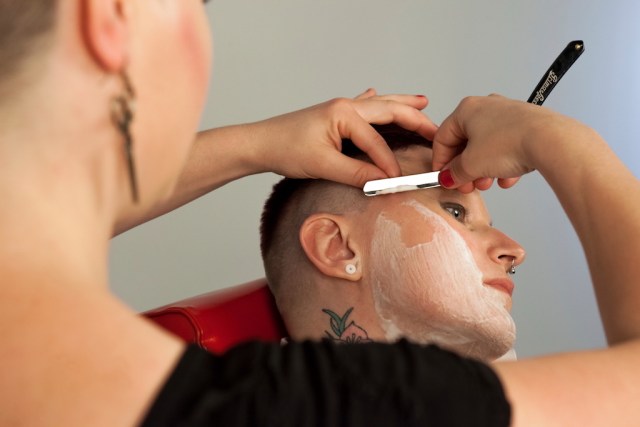
Klara and client Johanna. Photo by Zbigniew Tomasz Kotkiewicz.
How does being LGBTQ impact on your business (if at all)?
Our LGBTQ clients are very faithful and supportive. I’m proud being a lesbian but mostly being a person. I wouldn’t change it for anything. We are such a wonderful community.
What three websites, blogs, books or people do you rate for business advice or ideas about your work?
Lou Palmer from Sit Up Design is the back-bone behind much of Barberette, one of the most wonderful, humble and talented advisors/people I’ve ever met. Most of our graphic design and web work is from her. Haircut-wise, Mikey Henger.
What’s your hot tip for queer women who want to start their own business?
Follow your dreams and don’t give up.
Fancy a new look? Visit barberette.co.uk to find out more about Klara and her team, or get some gender-neutral hair inspiration on Instagram! You can also keep up with Barberette via Facebook.
Are you a queer-identified business owner? Or do you know someone who’d be perfect for Follow Your Arrow? Let me know by emailing beth at autostraddle dot com.
Emilie Wapnick’s How To Be Everything
Have you ever wondered if it’s possible to live a life centred on more than one interest? Or fretted about the idea that you’re supposed to have a thing, a passion, a calling; one thing for which you’re known? Does the question “what do you want to be when you grow up” make you feel anxious? Do you want to get by simply by doing the things you like?
In How to be Everything: A Guide for Those Who (Still) Don’t Know What They Want to Be When They Grow Up, Puttylike founder Emilie Wapnick argues that it’s possible to build a sustainable life and career that brings all of your different passions together. It’s possible to have more than one calling or no calling at all, to do what you love for a living or on the side, to switch careers like underwear, and to fulfil your widely varied interests.
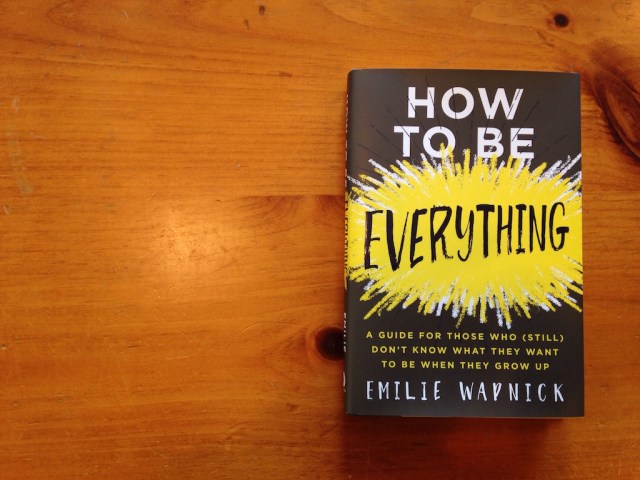
As someone who strongly identifies with Wapnick’s multipotentialite philosophy (and yet is riddled with anxiety that I’m supposed to “pick a thing and stick with it” and that maybe folks think I’m flaky because I get bored easily), I devoured her hard-won advice. She’s a powerful advocate for not compromising yourself or squashing yourself into boxes, and How to Be Everything is a source of warm encouragement and sound advice.
Though it focuses on how multiple passions play out in your work life and there’s plenty here about smart career moves and starting/running small business/es, How to Be Everything isn’t a career book per se. It’s a “lifestyle design” book. Eye-rolling term aside, there’s plenty to be gained from knowing yourself, knowing what makes you tick, and making conscious decisions and tweaks that will make your lifestyle more sustainable and more enjoyable — something that is particularly important for multipotentialites. Wapnick’s definition of lifestyle design runs along the lines of “know what makes you happy, then intentionally build a life that celebrates all of it”:
“To lead with your multipotentiality is to build a sustainable life around your plurality. It means figuring out, in practical terms, how to get the money, meaning and variety you require so that you can flourish, put your brilliance out into the world, and make it a better place.”
Sounds perfect, right? But where to begin? First, Wapnick breaks down the notion of having “one true calling,” arguing that it’s a construct imposed by a society that likes things in neat and tidy boxes. Speaking from her experience, she talks about the anxiety that the question “what do you want to be when you grow up?” and the insistence on early self-definition create. She writes, “It’s subtle, but we can translate ‘What do you want to be when you grow up?’ to, ‘You are allowed one identity in this life, so which is it?’ How terrifying is that? When phrased that way, it’s no wonder the question stresses us out.”
As a solopreneur who wonders about walking away from my business and trying something completely different (maybe!), it’s helpful to hear that I don’t have to limit myself to a niche or field, but instead can build a sustainable and meaningful life around many and changing passions. I can do something now, and I can do something else later. Right now, I’m a tarot reader who also runs an online shop. I teach tarot, too. Plus, I’m a writer. Oh, and I do a little ad-hoc web design on the side. And while I’m really happy with the variety of roles that make up my working week now, it’s more than likely that I’ll want to switch direction later. Maybe I’ll bring my interest in botany to the forefront of my work, or perhaps my enjoyment of textile crafts will turn into a new career, who knows? The thing is, I’m already stressed out by the thought of what friends and family will say to me. “But I thought tarot was your thing!” or the humiliating “maybe that tarot business just didn’t work out.” Wapnick consistently emphasises that multipotentiality is a superpower, not a failing, and that mutipotentialites are adaptable and great problem-solvers, innovators and learners. Meanwhile, reading about famous career-hoppers including Maya Angelou, Steve Jobs, Patti Smith and Beatrix Potter is very validating. The world needs folks with broad-ranging skills and interests just as much as it needs focused specialists.
In terms of practical lifestyle design, How to Be Everything focuses on three pursuits: money, meaning and variety. All are essential components of a successful life, though we each need these in different quantities. Though I feel like I get the variety and meaning parts of this equation, I especially appreciated the frank discussion around money. To a greater or lesser extent, money is a cornerstone in most of our lives; it’s not much fun pursuing your hobbies if you can’t afford a home or decent food. Seeing income on the table here alongside the less tangible (loftier, yet equal) pursuits of meaning and variety feels really grounding. It makes the passion part feel more real, and more possible.
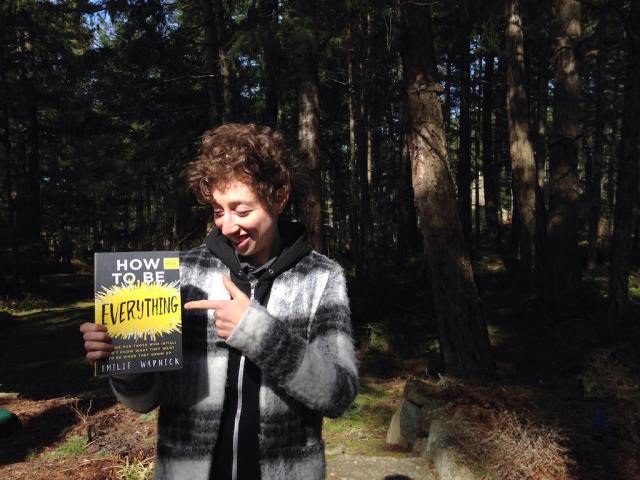
Emilie Wapnick outside her home on Salt Spring Island, BC.
How to Be Everything presents four different approaches to following your passion/s. A “slash careerist” presents many different work identities at once (like a web designer slash mountain guide slash artist slash blogger). A “group hug” combines all passions into one project. A “phoenix” pours all of energy into one single business or project for years, then quits and starts afresh on something new. An “Einstein” has a day job that provides financial stability, and then pursues multiple passions on the side. (Einstein developed his theory of relativity while working a full-time day job as a civil servant. There’s hope for everyone.)
You can build a life however you please. You can do everything. You don’t have to be an expert, you don’t have to choose, you don’t have to have a calling. You do you. As Wapnick writes:
“The truth is that you aren’t lacking a destiny or purpose. There is a very good reason for your insatiable curiosity: you’re someone who’s going to shake things up, create something novel, solve complex, multidimensional problems, make people’s lives better in your own unique way. Whatever your destinies are, you can’t step into them while stifling your multipotentiality. You must embrace it and use it.”
In terms of practical guidance, there’s plenty here. Wapnick counsels each of the above types, providing models for total reinvention, exploring on the side, discovering different common threads that could lead to a career or business that combines the lot (“to smoosh or not to smoosh, that is the question”), and loads more. Via Puttylike, she has established a large and enthusiastic community of folks who feel the same, and she’s bringing years of observations and experience into this book. It’s filled with inspiring examples of regular people who’ve built careers and lifestyles by combining their passions in different ways. There’s advice for introverts, for folks who need a safety net, for avoiding overwhelm and burnout, for dealing with people who just don’t get it. There’s also a whole big chapter on productivity, focus, time management, and y’know, getting out of your own way. Personally, I’m obsessed with finding out how other people structure their days/weeks, and I loved the varied approaches, tactics, challenges and solutions presented here.
The book also addresses the touchy subject of knowing when to quit — a decision multipotentialites are likely to face regularly. As Wapnick explains, “to most people, finishing means hitting an external end point. Multipotentialites, on the other hand, are finished once we get what we came for.” It’s refreshing to hear that getting bored of or done with something and deciding to quit isn’t something to be ashamed of, it’s simply freeing space for a new interest to develop and that’s just fine.
I finished How to Be Everything feeling heard and understood, excited about my current projects (and finally ready to ditch one or two without shame), fired up about my life, and excited to use a load of new life-planning tools to get my chaotic work/life situation in order. If you’re pulled in many directions, uncertain how to answer “so what do you do?,” or living a multi-passionate life but could use a few tools to help create structure and sustainability, How to Be Everything is an inspiring and validating read. You’re awesome just as you are, so crack on with doing all the things in your own way.
How to Be Everything: A Guide for Those Who (Still) Don’t Know What They Want to Be When They Grow Up came out May 2. You can also read a great interview with Emilie in Autostraddle’s Follow Your Arrow series, and catch her brilliant Ted Talk, “Why Some of Us Don’t Have One True Calling.”
Fool’s Journey: Which Queen is Your Mentor?

Header by Rory Midhani
Each of the tarot’s 16 court cards (those are the Kings, Queens, Knights and Pages) express an aspect of our ‘self.’ Whilst no single character is intended to be a complete summary of a person — they’re really too one-dimensional for this — these cards can highlight certain qualities, traits or behaviours that are relevant to your life.
Because they are the ‘people’ of the tarot, a diverse cast of characters covering different ages and areas of our lives, we tend to form relationships with the court cards, identifying with them, or calling on them for guidance at particular times. I like to think that court cards can act as mentors or spiritual guides when we need them. So you might place the Knight of Wands on your altar to inspire boldness and action, or keep the Page of Swords in your wallet to remind you to study hard.
By far the best-loved of the court cards (at least according to my own research) are the queens. Whether it’s the tough-as-nails Queen of Swords who’s seen more than her fair share of shit, or the practical, down-to-earth Queen of Pentacles cooking up a feast for family and friends, tarot folks really seem to relate to these four powerful femmes and the qualities they represent. So let’s get to know them!

All cards shown in this post are from the Shadowscapes Tarot by Stephanie Piu-Mun Law.
In Seventy-Eight Degrees of Wisdom, Rachel Pollack writes that each queen “represents an appreciation of [her suit’s] element rather than the King’s social use of it. This does not mean that the Queens indicate weakness, or even inaction, but rather the element translated into feelings and understanding.”
Pollack’s classic text helped to form the way I interpret tarot cards, but over the years I’ve come to see the four queens slightly differently. Rather than an ‘appreciation’ of the suit’s qualities, I see them as having really mastered their element. These are people who have ‘done the work’. Where a King might use their suit’s qualities externally (e.g. to lead, manage, control or build), a queen has taken these qualities within, reflected internally, grown stronger on a very personal level through working with the themes of her suit. If we look at the stories told throughout the Ace-to-Ten cards in that suit, we can see the various trials and tribulations she has faced, and can imagine how she overcame each one, gradually becoming stronger and wiser, gradually ‘becoming’ the queen. In this way, understanding the suit as a whole is key to understanding its queen.
By the way, I’m referring to these cards as ‘queens’ in this article because this is by far the most common title used in tarot. However, many tarot decks rename their court cards, sidestepping what many (including me) feel is a hierarchical and gendered binary. I’m also using ‘she’ and ‘they’ pronouns interchangeably here because this is Autostraddle, but please remember that it’s absolutely fine to play with gender in the tarot, a queen can easily be a ‘he’, a king or a knight might be a ‘she’, and so on.
Queen of Wands

The Queen of Wands is someone who has learned to deal with her own ego. She is confident and bold, characterised by self-belief and a passion for life, and although she knows how to assert herself without compromise, she’s never annoying about it. The Queen of Wands encourages you to be unashamedly yourself, to love yourself, your body, your life. She expects success to come from her projects, and because she expects it, success is usually what happens! At the same time, she knows how to deal with failure too — when things go wrong, she’s able to learn and grow, rather than feeling knocked back.
If we look at the Wands suit, we see how she reached this point. It’s a suit filled with petty conflict, conceiving, communicating and acting on bold ideas, success and failure, overwhelm, burnout, and the trappings of ego. The Queen of Wands has worked her way through all of this and found her sweet-spot: the ability to simply be yourself, to give zero fucks, and to follow your passions through to joyful results.
I’m going through a really full-on time right now — over the past year I feel like I’ve been kinda ‘broken down’ and am now putting myself back together again, learning how I’ve changed and deciding big things like who I want to be in this next chapter of my life. The Queen of Wands came up very prominently in a recent reading, and it was really clear to me that they were there to tell me not to be scared of myself, not to be scared to really be myself. They told me that I had changed, and that I had something different to offer the world, which made me feel excited about delving into all that, experimenting and exploring.
Queen of Swords

They say what doesn’t kill you makes you stronger, and that could be the Queen of Swords’ motto. The suit of swords is where we find some of life’s toughest lessons: heartbreak, insecurity, fear, jealousy and more besides. Because humans are humans, and one thing we’re great at is being harsh to ourselves and the people we love, right?
The Queen of Swords has seen it all. She’s been there with the heartbreak, she’s been broken and she’s gotten back on her horse more times than you can know. She represents your best self in the face of a tough situation, able to get a clear perspective, to stand up and speak the truth. She’s tough because she’s had to be, but she’s deeply compassionate, too, because she’s been there herself. Let’s say someone in your circle of friends has had a hard time lately, and is taking it out the rest of you. The Queen of Swords is the one who’ll actually talk to her and give her that tough kind of love, telling her that this behaviour isn’t okay, but that they’re there to support her when she’s ready to sort herself out.
Swords are about truth, justice and clear perception, and the Queen of Swords is a person who can see a bigger picture. Not just witnessing injustice as it manifests around them, but also the root causes of that injustice. As an activist, this is someone who ‘gets it’, who understands how the system works. They’re wry, because they know how this shit works, but they’re not cynical. There’s the willingness to call stuff out, but it’s underpinned by love and compassion, the determination to support people to be the best they can be, not just knock them down.
Queen of Pentacles
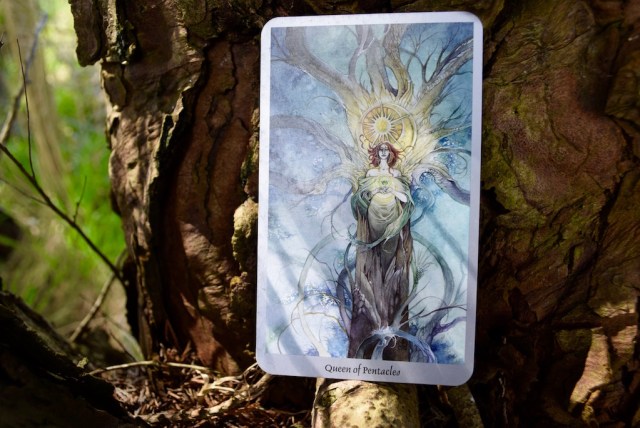
We hear so much about ‘self-care’ and getting our needs met. The Queen of Pentacles shows us what these things look like in action. Grounded, down-to-earth, this is a person who really knows how to create solid foundations for themself, who puts a high value on the ‘little things’ in life, spending time in nature, eating good food, community, home, making stuff, doing work you love, and so on. And because they know how to practice self care, they’re great at providing community care, too! This queen is the one who’s always got the kettle on, who’ll offer you a bed for the night or bring a big tin of flapjacks to the protest to keep everyone going.
The suit of Pentacles teaches us to find magic in the everyday, to take pleasure in using our hands, the joy of hard work, dedication and practice. Alongside the loftier themes of self-actualisation, justice and passion found in the other suits, Pentacles remind us that our material lives need attention too, and that we all have finite resources, or capacity, or spoons. One big lesson that this suit teaches, for me at least, is that it’s an act of compassion to ensure I have my own needs met, as it is only then that I can be of service to others. The Queen of Pentacles is an expert at this: they know how to say ‘no’ when they need to conserve energy for themselves, and so at other times they’re able to be generous and share their resources with others. Because of this, the Queen of Pentacles seems to have an abundant, comfortable life and appears to have a great capacity for nurturing others. Their secret? Genuine self-care. They’ve learned to listen to their body and their heart and hear what is needed, meeting those needs before seeing to others.
(By the way, if you’re interested in exploring the concept of ‘grounding’ and what that looks like in practice, we talked about it in this community roundtable!)
Queen of Cups
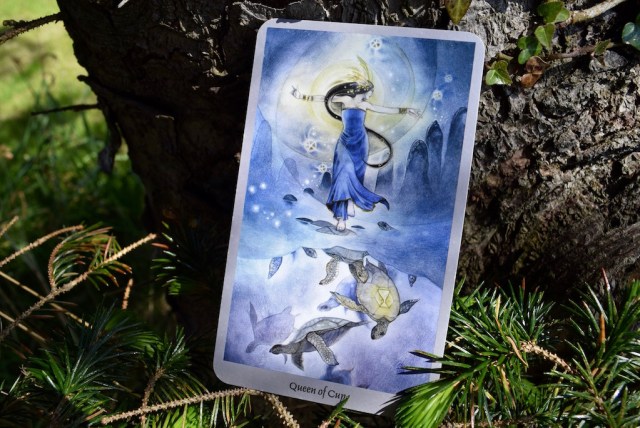
The cups suit is the realm of spirituality and emotion, it’s where we cultivate our intuition and (hopefully) learn to truly feel our feelings, whatever they are. There’s both ecstatic joy and deep sadness here, and everything in between. The suit of cups teaches us that light and shadow are of equal importance in our lives, and that real strength is not about being happy all the time, but learning to navigate through the whole maze whilst remaining true to ourselves.
That’s the Queen of Cups. Every situation is viewed through the prism of how it feels, what it means on a deeper level. The Queen of Cups is strong in herself because she’s able to express herself truthfully in each moment. She’s about authenticity, prizing emotional integrity over any idea of ‘right and wrong’. She’s the journaller, the diarist, the free-spirited artist, the person who understands that all things are connected, who explores her spirituality, values therapy and personal development.
Cups’ element is water, so it’s energy flowing, shape-shifting, hard to pin down or express in words. The Queen of Cups has learned to be comfortable with change — specifically internal change — and sees shifting emotions as an opportunity to learn more about ourselves, to dig deeper into our subconscious, to explore themes of fulfillment and wholeness not as prescribed goals with a start and end point, but as an ever-evolving journey. And, because she’s done so much of this work on herself, she’s able to offer this wisdom to others, too. Where the Queen of Pentacles is able to hold physical space and offer a comfortable, nurturing physical environment, the Queen of Cups can do this emotionally and psychically. She’s the kind of person who will comfort and reassure you, and accompany you on the toughest emotional journey.
The above are simple and one-dimensional interpretations. Depending on where these cards appear in your readings, they may mean very different things, not all of them so blatantly positive (I’ve seen the Queen of Pentacles represent someone who mollycoddled a partner, the Queen of Swords as being too sharp, for example.) But as mentors and symbols of qualities we need to call into our lives, each of these cards brings us powerful lessons to help us ‘do the work’. For me, I have the Queen of Wands on my desk as I write, she’s reminding me that right now I’m transitioning, and that it doesn’t matter one bit what anyone else thinks about it. I’m grateful for her confident posture, her sunflowers and her knowing smile, and I feel like she’s cheering me on during this often-fraught process of ‘becoming’.
How about you? Do you have a favourite queen, or one who feels especially important to you right now? Tell me all about it!
Follow Your Arrow: Astrologer Chani Nicholas on Working With Your Gifts
For those of us who like to follow the stars, regular horoscopes can provide structure and a sense of continuity in a chaotic world. Maybe you check out your stars each day in the newspaper, or follow an astrologer on Facebook for weekly forecast? There’s something incredibly soothing about knowing not only the phase of the moon and the movement of the planets, but what impact these might be having on our own lives here on earth. And whilst I always check in with Corina’s monthly horoscopes on Autostraddle, on a weekly basis I look to Chani Nicholas’s Monday emails for interstellar information to help guide my days.
Chani is not ‘just’ an astrologer; she’s also a talented writer and a passionate activist and LGBTQ and feminist advocate. Her horoscopes and full and new moon musings draw thoughtful parallels between the political and spiritual spheres, bearing witness to the pain and injustice many of us face and consistently offering positive, practical advice for change. Her words encourage us to look critically and compassionately at both our inner lives and the world around us, and how all of these ride on the ever-changing energy of the moon and stars. This bridging of the astrological, the personal and the political — via truly beautiful writing — means that Chani is a unique voice in the self-help field.
In this month’s Follow Your Arrow, Chani gives us a peek into the day-to-day life of her business, explaining how, no matter how she tried to avoid astrology (thinking it was too left-field for a career), eventually it claimed her. Chani also touches on the challenges of time management as a solopreneur, and the incredible leap of faith it takes to channel your gifts and start your own business.
Chani Nicholas, Astrologer
Los Angeles, CA

Hi Chani! Can you tell us a little about your business?
I write weekly horoscopes and other astrological musings. I teach online courses that help people make use of the potential of each new moon as well as courses on other significant current astrological transits (e.g., Venus retrograde) and broader courses that help folks unlock the power of their astrological chart.
How would you describe your approach to self-employment? What personal qualities inform your approach?
I was definitely winging it for a very long time but I trusted that if I found what I was good at and really passionate about, and then did it all day, every day, something would eventually happen. I am a perfectionist and, as painful as that can be when you are putting out weekly content online, it has served me really well.
When did you know that this was what you wanted to do? And what were your early goals, your first steps?
Astrology chose me. I didn’t want to do it professionally. I always loved it. I always understood it, almost like it was my first language. It was a total relief when I was introduced to it, but I wanted to do something that had more ‘credibility’, whatever that means. I had an idea of a successful person and an astrologer was not really it. I wanted to do something that was more recognizable to the public, like activism, education or the arts. I didn’t want to be in the esoteric outskirts. I grew up in a very alternative type of environment and because of that I never romanticized healing work. Being an astrologer was the norm in my family, in a way.
I tried to ignore astrology for many years but nothing else ever really seemed to work out and the astrology wouldn’t let me go. I have always dreamt about the planets, they speak to me, teach me and instruct me. They also harass me when I don’t pay attention to them, they don’t like it when I ignore them and have no problem letting me know about it. It’s not a fun experience. Working with them is easier than not so I finally gave in and gave astrology what I had to give it. When I did that, everything started to unfold.
There is nothing as satisfying as working on what we’ve been gifted by the gods. We all have some talent, some gift, some thing we are meant to develop. When we do, the energetic rush is unparalleled.
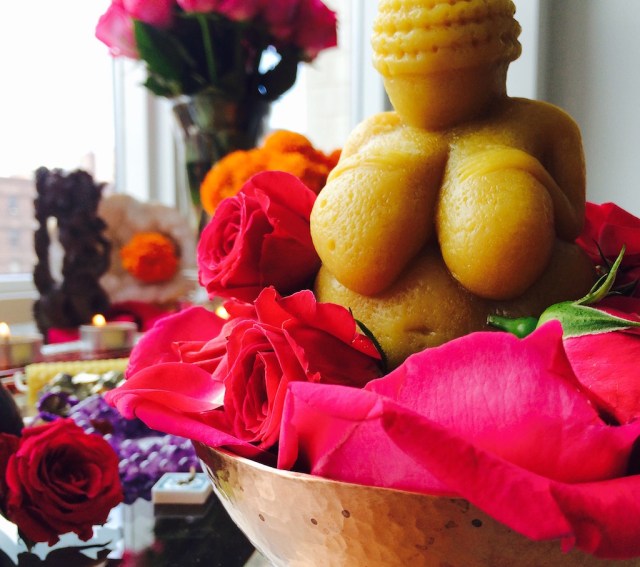
What’s the best thing about the work you do?
The best thing about what I do is that I use every single ounce of myself, everyday, all day and hopefully it helps someone, somewhere. I get to put every hurt, hope and healing experience into everything that I create.
And the worst?
I’ve had to develop a very thick skin. Lots of folks get angry with me for many different reasons and I’ve learned to be totally OK with that.
What’s the biggest challenge you face in your work?
My work is constantly expiring. I write 3,000-5,000 words a week and once the week is gone, those words are irrelevant for the most part.
How do you approach time management?
I suck at it. My assistant has to constantly badger me for things.
And what about work-life balance?
I work Monday-Friday, 8-5 on a good week. On a busy week I’ll work 7 days from 8 til goddess knows when.
My wife and I both work from home. We both run my business, plus she has a national non-profit, FreeFrom, which helps survivors of domestic violence gain financial independence and stability. Needless to say, we could easily work 24/7 if we didn’t stop ourselves. Our social life has, at times, suffered greatly but we make a concerted effort to make time for each other, friends and family regularly.
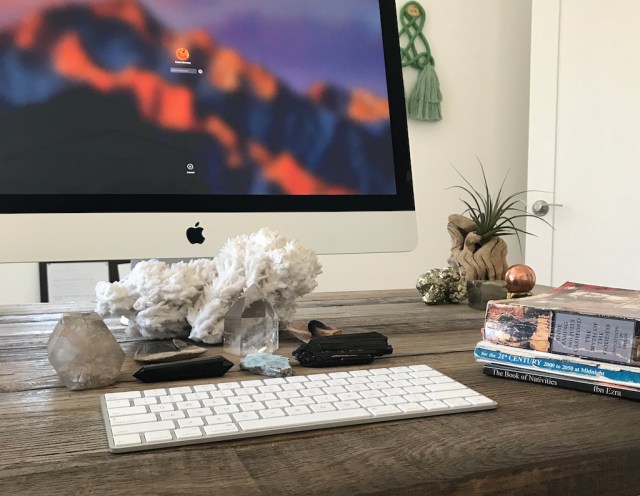
Can you tell us about your financial situation when you started out?
I started with nothing. Less than nothing. I started with a lot of debt and no idea how to make this a business or that it would ever be a business. My only start up cost was my time and energy.
Is your business sustainable now? And how do you feel in general about the money side of ‘following your arrow’?
If you want to make money doing your own thing you have to be prepared to think long-term, work overtime, and get nothing in return save for your own satisfaction for as long as it takes to make your business work. Having your own business isn’t for everyone. There is no stability in it. You have to love risk. You have to thrive in adversity. You have to be willing to dig deep time and time again with no promise of success. You have to be OK with being exhausted, alone, unsure and unpaid at points.
My business is sustainable now. It took a long time to get it here though. There was a lot of unpaid work for many, many years. A lot of doubt and fear. But I wouldn’t change it for the world because it is the absolute right fit for me.
Where would you like to see yourself in five, ten years’ time?
Doing what I love with those that I love: co-creating spaces in the world that facilitate more love.
How do you market your business?
I market the classes that I teach on Facebook, Instagram and in my newsletter. I don’t do any other outside marketing.
What’s the most valuable tool in your kit?
Critical thinking.
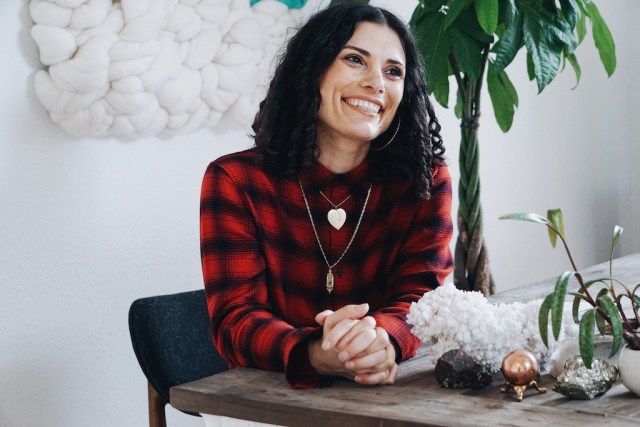
How does being LGBTQ impact on your business (if at all)?
I do not seek to, nor is it possible for me to, hide any aspect of myself from any part of my business, relationships or life. Being queer isn’t something that I can separate out from being a writer, astrologer, artist or entrepreneur and I would never want to.
Are there any websites, blogs, books or people you rate for business advice or ideas about your work?
I get all the business advice I need from my wife, Sonya Passi. She’s the CEO of my heart and my business.
What’s your hot tip for queer women who want to start their own business?
Do you. The more specific your work, the more you’ll attract your people. The more specific your work, the more loyal your people will be to you. The more sincere your work, the more longevity and success it will have.
Read more about Chani on her website, or follow her astrological (and activist) musings on Facebook, Twitter and Instagram.
Fool’s Journey: Reading the Bottom Card of a Deck

Header by Rory Midhani
I recently started doing something different in my tarot practice. I’ve been drawing daily cards for most of this year (usually but not strictly in the morning) and lately, I’ve been adding a second card into the mix. Not simply the next card in the pile, or even a shuffle-again-draw-again card, but instead, turning my deck over to check out the card on the bottom of the pile.
It’s a well-established practice, and tarot readers check out the card on the bottom or back of their deck for various reasons. Some call it the ‘shadow card’, others call it the ‘base’ or ‘foundation card’. For some, it’s a way to begin a tarot reading, setting the tone or establishing the focus of the reading. For others, the card on the bottom of the deck provides a ’secret message’, an additional and invaluable piece of advice, often something that is hidden. Bridget at Biddy Tarot explains that “the bottom card alludes to the hidden aspects that are influencing the situation at hand and gives deep insight into the subconscious mind of the client.” Another idea is to use the bottom card to round off the reading with a final word.
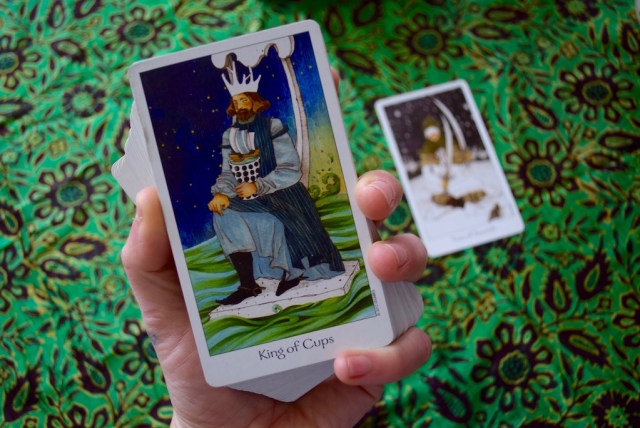
From the Dreaming Way Tarot by Rome Choi and Kwon Shina
I read it differently. When a friend and I were first learning tarot, we’d lay out the Celtic Cross spread, then peek at the card on the bottom of the remaining deck, saying “it’s not about this…”. I forget whether this was a practice my friend made up, something from a book, or picked up elsewhere, but it’s stuck, and lately, I’ve been bringing it into my daily draw.
I’m finding that this ‘not about’ approach really helps me to dig deeper into those daily cards. It’s so tempting — especially as an experienced reader — to merely glance at the card, briefly summarising it with a known reading, a few keywords. But the card on the bottom of the deck nudges me to think more carefully and often challenges my preconceptions.
To demonstrate:
This morning, I drew the Two of Swords. I sat there frowning for a few moments, taking in the incredibly defensive image of a woman, blindfolded, holding aloft two freshly-sharpened swords. “Holding something back,” I quickly thought to myself. I’m used to seeing cards about withdrawal, having spent much of my winter alone. I have a nagging sense of overdue ‘shadow work’, the weight of a few unresolved issues that I’m repeatedly putting off.
I picked up my deck and turned it over: the King of Cups.
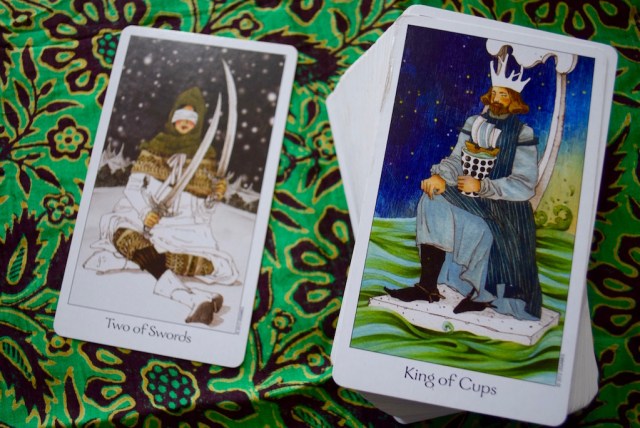
What does this add to my reading? I see this King as someone who is emotionally aloof, in control of their feelings, someone who’s done a lot of work on themselves, and who processes their emotions with a lot of logic, within carefully-created structures.
I notice the subtle visual symmetries in the cards: both are night-time scenes, both characters seem withdrawn. The upward sweep of the King’s throne seems to reflect one of the first cards curving swords.
Maybe I need to stop overthinking this ‘shadow work’ of mine. This King, in negative, is making me think that it’s time to relax a little and to be at peace with my emotional blindfold. Thinking so much about ‘doing the work’ and endlessly trying to figure out ways of structuring and dealing with my unfinished business is probably not doing me any favours. Knowing that this reading is ‘not about’ the King of Cups gives me a sense of relief — like the card removes a deadline, lifts the pressure I feel to deal with my shit and get everything sorted out.
Now I can come back to the Two of Swords with a feeling of trust. I can trust that change is happening behind the scenes, behind that blindfold, and that it’s safe to gradually lower those swords of logic and really allow myself to feel what I feel, with honesty, and without pressure to achieve any particular stage or goal.
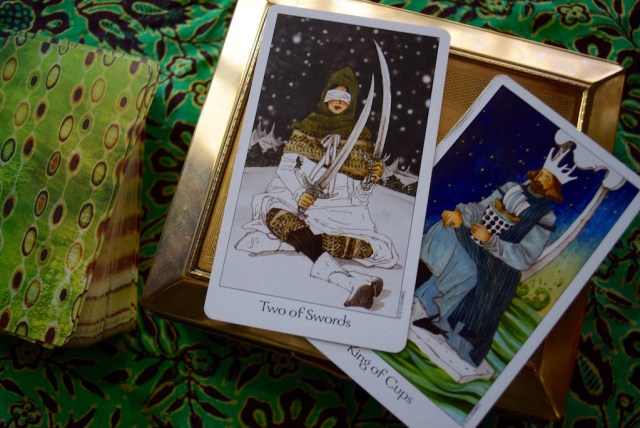
I love how the ‘bottom card’ — whether read according to my ‘not about’ approach or using any of the ideas suggested above — prods me out of my comfort zone and challenges me to look at my daily cards in new ways. So now I’m curious: does anyone else read ‘bottom cards’? If so, what’s your approach? How and when do you use these cards? Let us know in the comments!
Follow Your Arrow: Graphic Designer Soof Andry on Punk-Rock Freelancing
There are freelance creatives who will take every job that comes their way, enjoying the challenge of turning their hand to an infinite range of projects. Then there are those who carve out a niche to suit themselves – an ideal client, a field, a genre that lights them up, and in which they have something really special to contribute.
Soof Andry is the second kind. As a graphic designer and illustrator, they didn’t spend long working in a corporate environment before deciding to break free and follow their own path. Now an established freelance designer, Soof specialises in social justice projects, often with a queer, feminist and/or radical focus. Their bold yet tender and accessible illustrations have given depth and life to diverse projects from radical community initiatives to magazines. A punk at heart, Soof also publishes zines and poetry (check out the brilliant ‘Bloody Hell‘, a forthright zine on experiences of menstruation) and – most excitingly for me – a tarot deck!
In this interview for Follow Your Arrow, Soof shares their journey from newly-qualified graphic designer to anarcho-punk freelance creative, exploring the paradox that is ‘niching without borders’: focusing the kind of work you most love to do without getting boxed in or typecast. We also discuss productive mornings, the inevitability of burnout when you’re finding your groove, and the creative freedom a second income can provide.
Soof Andry, graphic designer and illustrator
Age 25, London
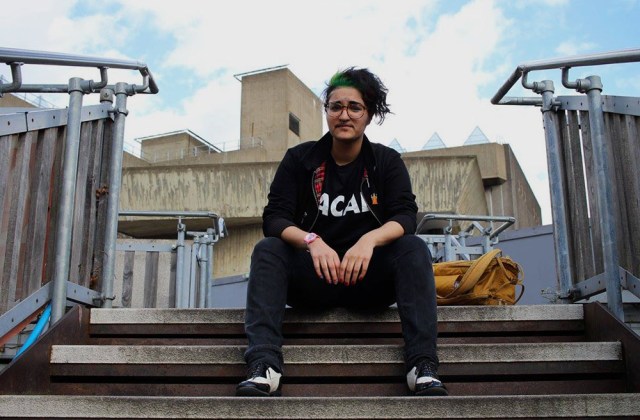
Photograph by Krishanthi Jeyakumar
Hi Soof! Can you introduce your work? What’s your mission? Who do you serve?
I do a handful of things, its really hard to sum up in an umbrella terms sometimes. I design, I teach, I lecture, run workshops, do writing, I organise events, I’m into radical self-publishing, activism and so much more. First and foremost, though, I’m a graphic designer by trade.
I’ve been freelancing since I left uni years ago. I generally work with clients from the cultural, arts and activist sector. That could be anything from branding and visual identity work, or book and editorial design to illustrations and consultation stuff. I like to mix up things with writing, activism, and teaching too, I’ve been teaching at a university in London for about three years now, I find that feeds into practice really well and visa versa.
Generally in life all I want to do is: good work for good causes with good people. I want to be a good designer, I mean truly, deeply good at my craft; everything else is semantics, I guess?
How would you describe your approach to self-employment or business? What personal qualities inform your approach?
Professional Anarchist? Executive Anarchist? Something along those lines.
I’m winging it on the whole and that approach has worked out well for me. Although to wing it, and wing it well there’s a lot of hard work, commitment, perseverance, resistance and enthusiasm needed. I always tended to do my own thing and crave my own path both personally and professionally, so this has really set up me up for being freelancer, designer and creative of all sorts. It worked out to my favour.
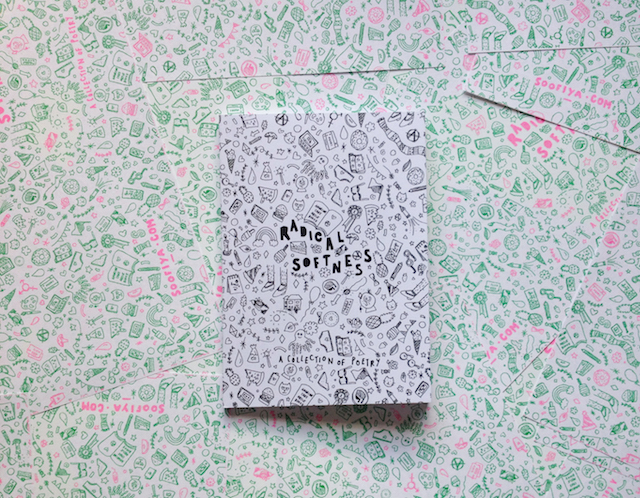
A personal project, Radical Softness is a poetry zine exploring self-love, PTSD and resistance.
What does a typical day look like for you? Do you have a routine? What is your workspace like?
Typical workday varies depending on what I’m doing. If I’m lecturing, its an early start and a commute into London. I teach at a design school in North Greenwich; I specialise in graphic design there. It’s interesting, fast-paced, keeps me on my toes. You really have to be able to think on your feet, connect dots quickly and genuinely know what you’re talking about and your industry to do that well.
If I’m working on client work or working on my own stuff, I work from home. It took me a while to get the set-up just right – it slowly fell into place and now I can be pretty productive and really work to my flow. My usual day kicks off around 8.30. I’m an early morning person and get a lot more done early on in the day than I do later on, so try to set up days up to work with this. I go through my emails, answer or avoiding answering stuff. Have breakfast and browse Twitter and Instagram. These have proven to be invaluable tools for my work, both in terms on input and output, and makes the lonely freelancer life much softer.
I normally plan a week ahead with work, so I’ll crack on with whatever I’ve got booked in. During the morning I’ll have a podcast on the background, this really helps me focus. I tend to jump between my room, and living room in terms of spaces to work. The living room has lots of natural light in the morning and its normally quiet and cleaner than my desk. I rarely work at desk.
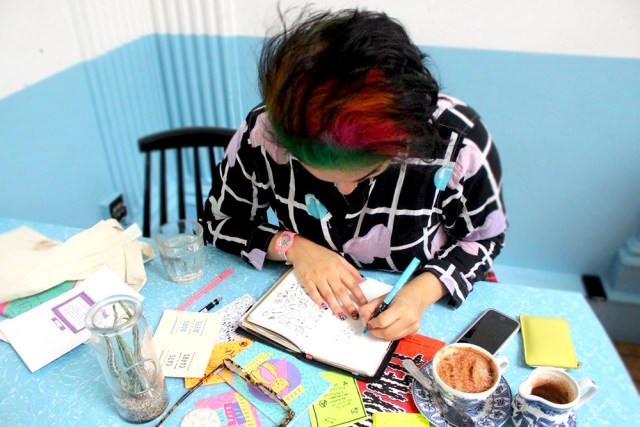
Photograph by Krishanthi Jeyakumar
When did you know that this was what you wanted to do?
For ever and ever! I’ve always been a ‘maker’ and constantly producing content. As a kid I was the most content sat on sofa with an entire 500-sheet ream of print paper drawing and sketching cartoons from the TV. When I wasn’t drawing I’d be rallying my siblings and organising ‘protests’ and ‘petitions’ for pizza for dinner. 20-odd years later it feels like mirror of the things I’m doing now.
What were your early goals, your first steps?
When I first started out I wanted to work for the ‘biggest and best’ design agency in the world. It wasn’t till about a few years I realised how toxic that idea was. Design is very corporate. I’ve worked in agencies and ad agencies and found that it wasn’t for me. The more corporate it got, the more overwhelming I found it; for me, design lost it soul.
I wanted to make good work, and channel as much activism into it as possible, and those sorts of environments weren’t the space. So I thought fuck it, I started working for smaller agencies and studios, taking on my clients and not being afraid to do the stuff I love. I was lucky that I had the steady income from teaching graphic design, that let me be a bit more critical and self-serving with some of the work I took on. It worked out in the end, I’m getting more of the type of clients I want and not just boxing myself in.
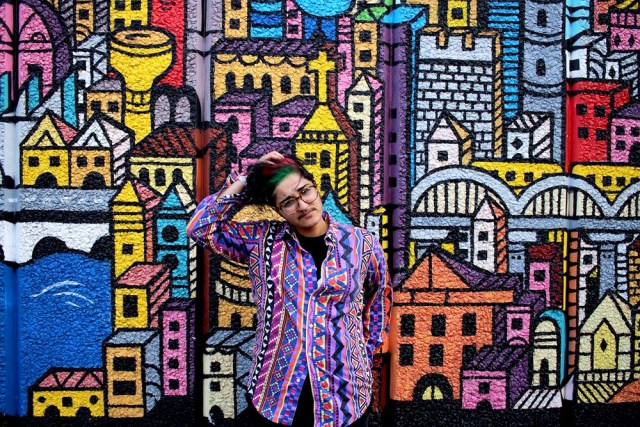
Photograph by Krishanthi Jeyakumar
Why do you do this?
A lot of this happened because I was keen to push myself out of ‘just being a designer’. I love it, I’m great at it, but I’m also good at other things. Being freelance, having multiple side-hustles, and being an anarchist in approach and thought all really feed into this. I do lots of things like speaking at universities across the country, self-publishing multiple books and zines (which have sold hundreds of copies), writing for magazines and newspapers on stuff I care about and channelling activism into a multitude of things. Working with people and clients and organisation that are doing incredible work is really fulfilling.
What makes you spring out of bed in the morning?
The thought of fully automated luxury communism and avocado on toast.
What’s the best thing about the work you do?
Doing it all yourself. I have a lot autonomy and control of the things I do, my hours and type of work I take on. It’s a real privilege to be able to work like that, and I’m lucky to have find that flow and equilibrium on in my career. I’m sure there’ll be things and opportunities which disrupt it, but in the best of ways in the future, but for now I value the agency I have over my practice.
And the worst?
Doing it all yourself. Being an one-person-all-singing-all-dancing-all glitter riot can be really exhausting and overwhelming at times. So I’m being trying to be really self-aware and not take on to much, sticking to my anarcho-punk ethos as much as I can.

Soof worked on the Comics In Schools project which helped young people find a voice through comics and illustration.
What are the key challenges you face in your work? What are your tactics for overcoming these?
Early on in my career I took on a lot of work and said to yes everything, was was great and opened a lot of doors but I ended up working on things I didn’t care about and weren’t my vibe. I worked for corporate companies and ended up making bland work. But over the years I’ve learnt to be more critical, saying no is just as important as saying yes. I have a checklist; to get on my books, you have to check off at least two of the following: Is its meaningful work? Is it an area I want to go into or work on more? Is it paid well? Occasionally a project will check all three, and I know I’m onto a winner.
How do you approach time management?
Planning! I have a Midori planner which I love more than anything, inside it I have a week by week view plus a month by month which lets me plan out work, clients, bookings and social stuff. There’s something really satisfying about giving yourself life-admin days once a month to sort your shit out. Coloured coded highlighters and post notes are where its at, mate.
And what about work-life balance?
I burnt out a quite a lot. Work can end up coming in weird waves of all or nothing, occasionally steady flows but I tend to take on a lot more than I shout; say yes now and try to find the time later.
I’ve found my cycle of productivity after a lot of trial and error. I work extensively for a few weeks solid and ride the wave of productivity until I’m exhausted, then give myself a week and bit off from everything. Everything. I just take a break. I’ve found this is working well for me at the moment. Having said that, I’m always mixing up and changing my approach to working managing the burnout.
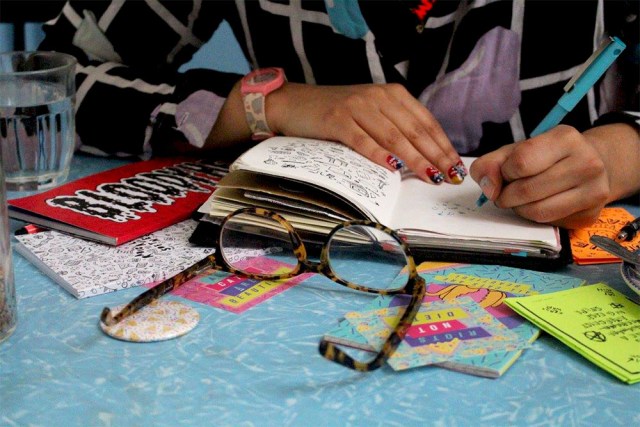
Photograph by Krishanthi Jeyakumar
Does your work feel financially sustainable? And how do you feel generally about the money side of ‘following your arrow’?
I’m not a millionaire. Logistically, I’ve found having a part-time job or client or something in the background helps. A steady income enables me to take on risker, more creative and often more rewarding work. I lecture one (maybe two) days a week, this is my steady income. So I know that if worst comes to worst I have that money coming in.
Other work, like side-hustles, tend to flow in and out, some pay shit, some pay well, but that’s a judgement I make based on the client, work, project and potential to take on. As a general rule, I don’t work for free (and you shouldn’t either: you labour is of value and you should be treated as such). The only time I do work for free is for activist, underfunded, do-good types that are doing brilliant work that I want to support and be a part of; I normally approach them or we have an existing relationship.
Where would you like to see yourself in five, ten years’ time?
You sound like my Mum. I don’t know. Loosely I’d like to still be designing, and doing what I am now. I want to start taking on some installation design work; I’ve only dabbled but it’d be nice to work on it properly. I really enjoy lecturing on everything about feminism, gender, anarchism and more. Last year I lectured all over the country which was great; more of that would nice to sandwich in.
I’d like to keep self-publishing. I’ve done a few zines, a poetry book, and I want to put of a few more (I’ve some in the works already!) I’d also like to collaborate more outside of my discipline. I’ve started working with a few designers and collectives with friends and its a really nurturing and enlightening experience, so I’d like more of that!
How do you market your business?
I use social media a lot but not to actively ‘promote’ or ‘market’ myself, but more to be part of a community of designers, creatives and activists. I’ve gotten work through that but more as a nice by product rather than the end goal. Marketing isn’t my thing; for me, self-promotion, sharing, building communities through work and social media is far more powerful.
What’s the most valuable tool in your kit?
My laptop. This isn’t unique or special but hands down my Mac is most my important tool. Teamed with Adobe Creative Suite, wifi and a decent text editor (I like writing in iAWriter) I’m unstoppable: I have my entire life, work and everything that I do. If it wasn’t for my laptop I wouldn’t be able to produce anything with the speed, efficiency, level and platform that I do.

Illustration work for Base Publication
How does being LGBTQ impact on your business (if at all)?
A lot of my work tends to be in cultural, arts and activist sector, so a lot it naturally addresses that. I try to make my work as inclusive and representative as possible, for example I’m working on a tarot deck at the moment which is all-femme, all-POC, all-80s vibes deck; its all about representation. I’ve also been really luck to work on projects and clients who are doing good work and social change with LGBTQIA+ communities. For example I worked on a project within University College London’s Urban Laboratory, by Nightlife Spaces. Their aim is to build an evidence base to document the presence of existing and past LGBTQI spaces in order to understand the value of these spaces for LGBTQI and wider communities, and to the cultures and heritage of London. It was so amazing, there was so much research put into this project; I worked on the visual identity and thought it was a really good process, for fantastic clients.
What three websites, blogs, books or people do you rate for business advice or ideas about your work?
My best pal Sarah lent me a book called The Life-Changing Magic of Not Giving a F**k and it came at such a good time: I’d taken on a massive new role with my teaching, was feeling really stressed and overwhelmed, and Sarah passed me this hardback over a hot a chocolate and it really resonated.
Podcasts, I love podcasts. I listen to them while I work (listening to one right now as I type this) and just before I go to bed. One I find that helps me focus and get in the flow is Beautiful Stories From Anonymous People. It’s so intimate, it’s like an hour of listening in to a phone call with an anonymous person, and they share such depth and important parts of their lives, relationships, work and so much more. It helps me keep perspective when work gets too much.
Inclusive Mosque gets a shout. We’re currently working on a rebrand, and they’re an amazing space, they’ve achieved so much in the few years they’ve been running and are so inspiring. Inclusive Mosque is an inclusive spiritual space, actively welcoming women, LGBTQIA+ people, disabled people, and many others with marginalised identities.
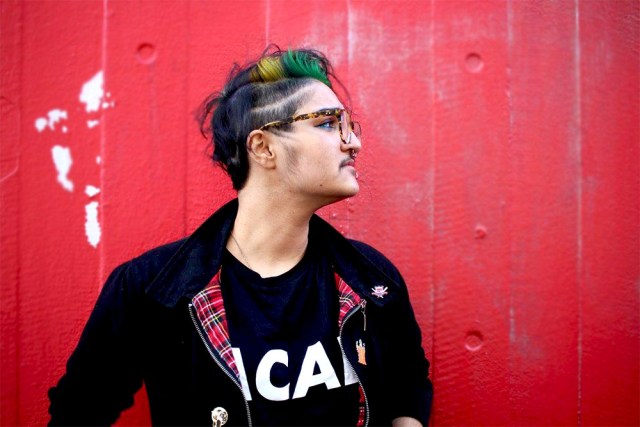
Photograph by Krishanthi Jeyakumar
What’s your hot tip for queer folks who want to start their own business?
Do it your way. It’s a really liberating experience: you can finally make your own rules and hours and type of work. Enjoy that! If you love early mornings, work early mornings. If you can’t get out bed till 10am, only have meetings and calls scheduled for post-lunch. Do it your way, do it for yourself, and be as punk rock about this as you can.
You can view Soof’s gorgeous portfolio at soofiya.com, and keep up with them on Twitter and Instagram!
Fool’s Journey: Beyond Kings and Queens, Renaming Court Cards

Header by Rory Midhani
Announcements! Yes, more, because the world of queer tarot just keeps gettin’ better. These are all rad projects that are happening or have recently happened on Kickstarter:
- Tarot veteran extraordinaire Rachel Pollack will be writing the book for Emi Brady’s forthcoming Brady Tarot, which has somehow managed to make a perfect deck even more perfect. I guess this is what happens when your Kickstarter triples its goal.
- TABULA IDEM is a queer tarot comic anthology with an accompanying majors-only deck, which tells queer stories through tarot cards. You can support the project here!
- The Slutist Tarot is a mystical celebration of sex positivity that centers femmes, sexual deviants, divine whores and curious maidens, from the online magazine of the same name. It’s Kickstarting now!
So here’s a question: What do you call your court cards? By this I mean the 16 ‘people’ of the tarot, usually named the Page, Knight, Queen and King; a royal family for each of the four suits. They tend to represent people or elements of people, rather than situations (though that’s a general rule, not a hard-and-fast one!) and we usually think of them as having the characteristics of actual humans.
To my mind, the King/Queen binary hierarchy is just another way tarot can reinforce gender nonsense, but the good news is, as with all things tarot, you don’t have to follow the rules! Many deck creators choose to rename these cards, for various reasons. Some wish to sidestep the royal hierarchy inherent in this system, others to strip out the gendered elements. Another reason is to find better ways to express the qualities of the card.
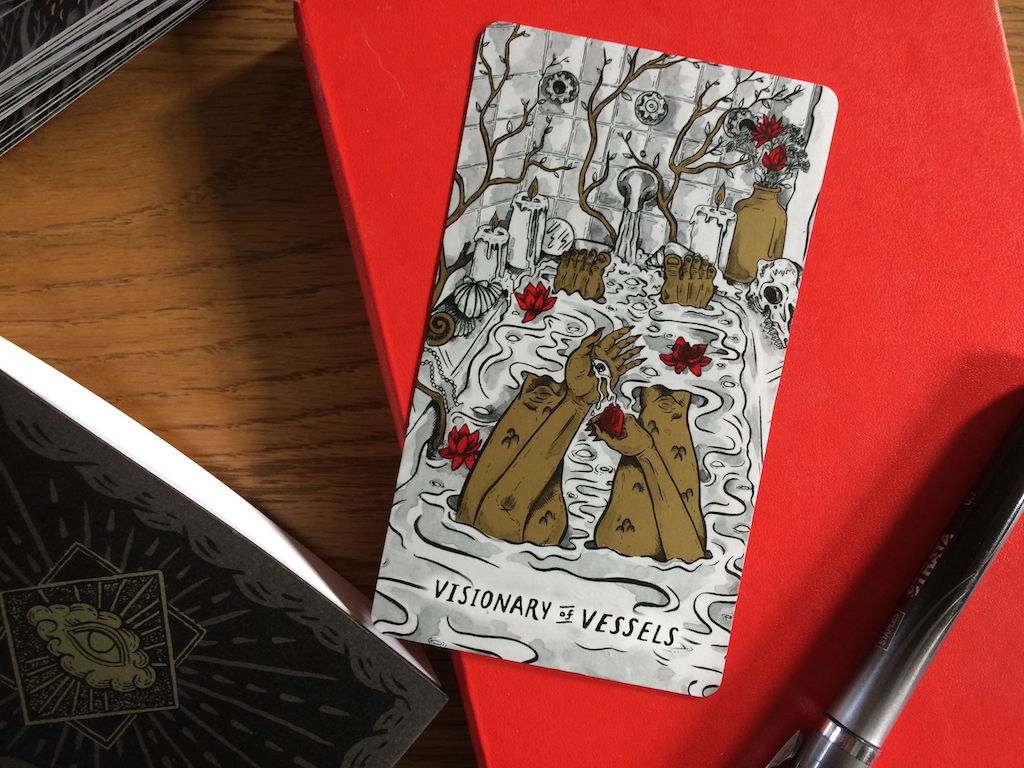
Visionary of Vessels, the Slow Holler Tarot’s answer to the Queen of Cups
I’m down with all three of those adaptations! Any approach to tarot that opens space for alternative interpretations or the challenging of gender perceptions is a-ok with me. (I also like the way that some artists choose to refer to these cards as ‘face cards’ rather than ‘court’, again moving away from that hierarchy. I’m trying to make this my habit, too.)
The creators of the decks below have each chosen to name their face cards in a pattern different to the traditional Page, Knight, Queen, King. I love that each style of renaming brings something different to the way we perceive these characters. Let me know which approach works best for you in the comments!
The Collective Tarot
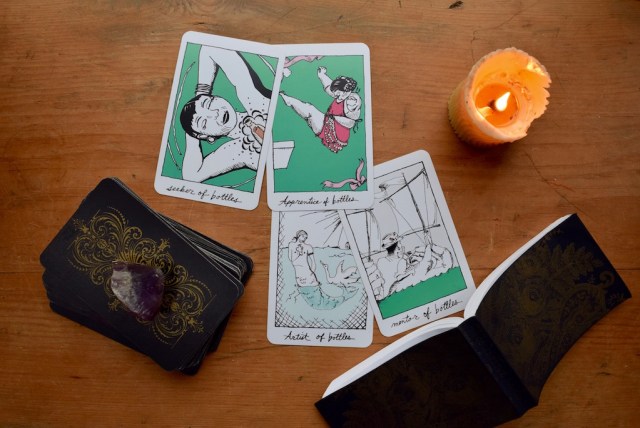
Seeker / Apprentice / Artist / Mentor
The Collective Tarot was the first I encountered in which the face cards had been renamed, and it was a huge breath of fresh air. The curiosity imbued in the ‘Seeker’ delighted me, whereas the active commitment of the ‘Apprentice’ gave me a new appreciation of the traditional Knight. Meanwhile the inner world of the ‘Artist’, discovering and expressing inner landscapes, and the ‘Mentor’, using skills honed over a lifetime to leach and empower others, felt like exciting and radical re-visionings of the traditional Queen and King.
The Tarot of the Crone
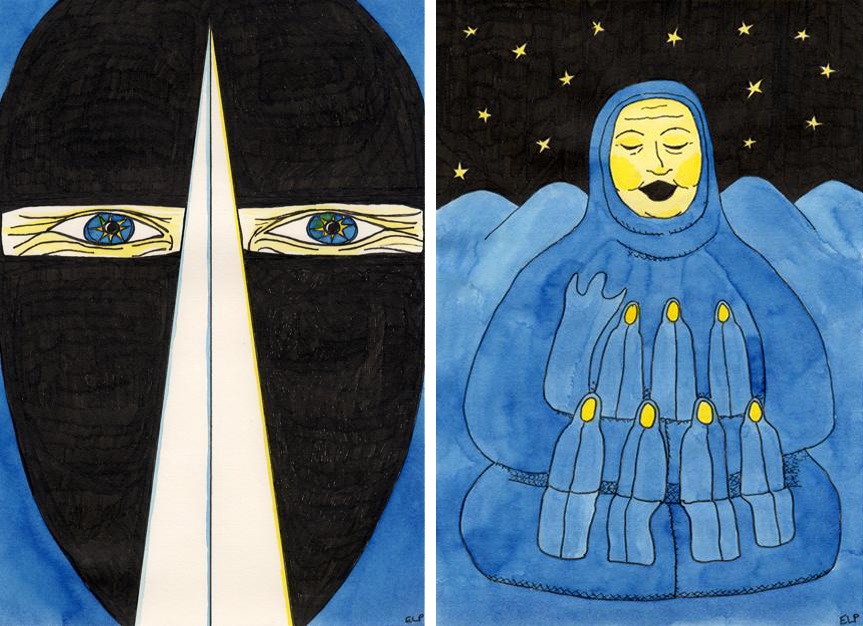
Witch of Swords and Grandmother of Swords © Ellen Lorenzi-Prince, via darkgoddesstarot.com
Beast / Witch / Grandmother / Shadow
Another feminist deck, Ellen Lorenzi Prince’s Tarot of the Crone (soon to be back in print – hurrah!) names its cards after four faces of an older woman. Beginning with beast and ending with shadow, I freakin’ love the way this deck overturns any notion of an ‘old crone’ as someone meek or decrepit, but uses these four faces to express different approaches to the awesome power of the crone:
Beast: The primal instinct of the power. The wild and whole expression of the element.
Witch: The focused use of the power concerned with fulfillment and expression of self.
Grandmother: The mature expression of the power concerned with family and community.
Shadow: The element’s overdone, destructive and transformative powers.From the Tarot of the Crone booklet by Ellen Lorenzi Prince, via Aeclectic.
Thea’s Tarot

Child / Amazon / Daughter / Mother
As a feminist, lesbian deck, all characters in Ruth West’s Thea’s Tarot are female-presenting. I love the openness of the ‘Child’ (Page), the wild, strong, determined ‘Amazon’ (Knight) who really feels like she’ll fight for what she believes in (even if she’s sometimes misguided). I also appreciate the alternative partnership of ‘Mother’ and ‘Daughter’ in place of King and Queen, to me, this celebrates the strength in what is for many women an incredibly important and formative relationship.
The Slow Holler Tarot

Student / Traveller / Visionary / Architect
I think the collectively-created Slow Holler Tarot’s are my favourite renamings of court cards. I love the simplicity of ‘Student’, which is just exactly how I begin interpreting Page cards. I love the dynamism in ‘Traveller’ (Knight), and the authority and strength of the ‘Architect’ (King). And ‘Visionary’? Wow. What an incredible way to convey the way a Queen communicates from a place of real inner strength and understanding.
Aside from the ‘degrees of experience’ conveyed by the Slow Holler’s renaming, I also love that they choose to place the Queen-equivalent as the final card in the face card sequence (as in, it would come ‘above’ the King in a standard hierarchy, or would be the last card in a gradual maturation, as in many of the decks in this article.) I always felt that the queen’s tendency to go deep within and use the qualities of their suit for personal growth and transformation felt like a step onwards from the king’s typical ability to express their suit outwardly and lead others.
The World Spirit Tarot

Seer / Seeker / Sybil / Sage
Again, tarot creator Lauren O’Leary has chosen to consciously avoid the old European hierarchies of traditional tarot, and names her court cards after life stages and uses gender-neutral language. I especially love ‘Sybil’ — the oracular wise women of ancient Greece — in place of queen, which O’Leary describes as “governing their realms with ease.”
The Wild Unknown Tarot

Daughter / Son / Mother / Father
Not the most radical renaming, these face cards make up a ‘standard’ family unit — the four in each suit are all from the same animal family (snakes for wands, for example, or swans for cups). Though Kim Krans’ Wild Unknown Tarot is the deck I use most often in my work, I still find that I struggle with neutralising gender and queering these renamed cards. Still, I feel like this can a more accessible approach than the regal court, and I find that my querents really relate to this simple system.
There are plenty of other decks out there that rename the court cards! Which ones have I missed? Which of these reinventions works best for you?
Sara Quin, Ruby Tandoh and Others Share Their Mental Health Stories in “Do What You Want” Zine
Food writer Ruby Tandoh‘s latest project isn’t a recipe book or a new cookery column, it’s a zine. Specifically, a zine — Do What You Want — about mental health and self-care, stigma and support, co-created with her partner Leah Pritchard.
The project addresses mental health issues via the direction from which many of us arrive at them: as deeply personal and isolating experiences, and (hopefully) slow and difficult journeys towards management or recovery. Do What You Want doesn’t offer professional or medical advice, but in sharing stories and strategies, its creators aim to increase understanding of mental health and provide a range of accessible self-care tools to anyone who needs them. As Ruby puts it, “although we have grown up in a generation that is more aware of mental health (and illness) than ever, we still felt that social pressure to ‘just cheer up’ acutely. There is a real lack of understanding about the many different ways that mental illness can manifest, the things that trigger it, and what can be done to help.”
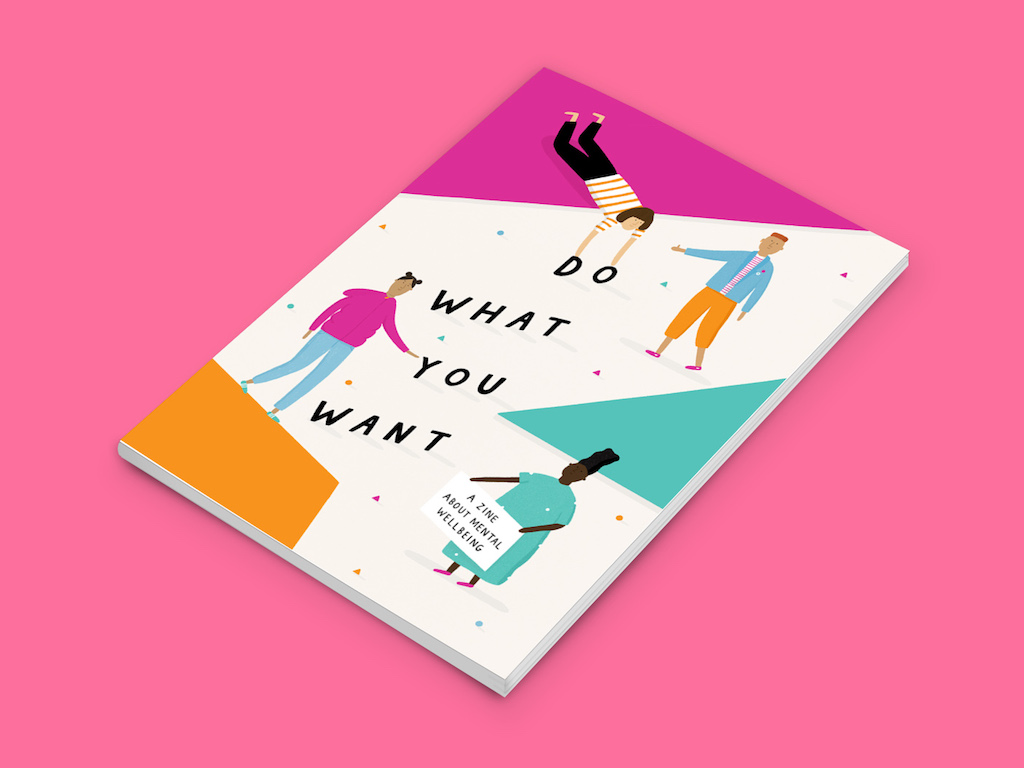
The zine is a labour of love for the two women, who share their own experiences with eating disorders, anxiety and depression, as well as collating stories from a wide range of contributors, including Sara Quin, Tajal Rao, Mara Wilson, Bridget Minamore and Ruby Snapes. Every writer and illustrator featured in Do What You Want has had first-hand experience of the mental health issues they’re discussing.
We didn’t want to just send money, we wanted to talk to people who had experiences like ours, and give a platform to those stories that perhaps we don’t hear as much as we should. That’s why a magazine made perfect sense.
Articles cover a wide variety of perspectives and topics, from ‘Why Should I Go to Therapy?’ by Heather Havrilesky (the writer behind The Cut’s ‘Ask Polly’), to ‘On The Realities of Being a Black Woman With Borderline Personality Disorder’ by Christine Pungong (available to read on Fader). Also included are a personal essay about mental wellbeing as a Somali refugee woman; an article about seeking treatment as a non-binary person; a look at being mentally ill and on benefits; a portrait of social anxiety; a comic about mental health and compulsive spending and a collection of favourite recipes for taking care of yourself. The zine is an intersectional collection of diverse stories showing how mental health (and stigma) affects people across society.
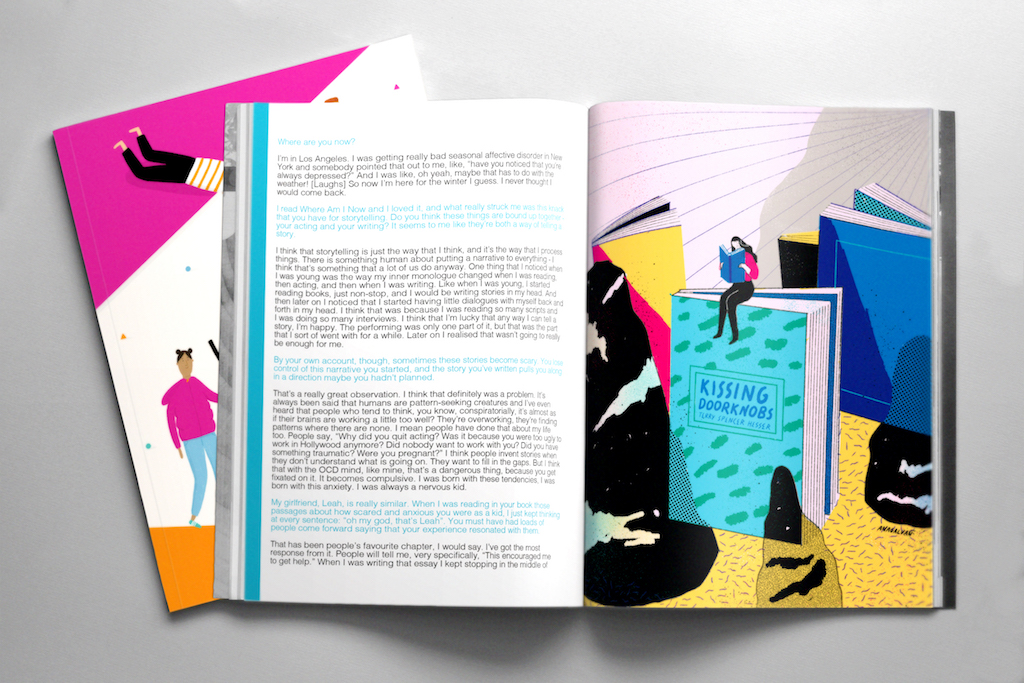
Tegan and Sara’s Sara Quin has also contributed to the zine, writing about how mental health challenges for both sisters plays out in their music, and the importance of community support within the LGBTQ community:
So much of what we wrote for The Con, Tegan was going through intense relationship stuff and I was thinking “I’m in a great place!” and then my grandmother died and someone who was working with the band who we were really close to died and all of a sudden my relationship died, and I thought, “Fuck”. All of the music that I had been writing during what I thought was a really good time, I think seemed appropriately in line with the next couple of years, that were so bad and so hard.
We live in a world where we are expected to advocate for ourselves and get the things that we need. What if you can’t? What if you don’t have those skills? What if you didn’t have a mom who kicked down your door and demanded to know what was going on with you? What if you are isolated socially and emotionally and physically from getting the help that you need? I think that by servicing our own LGBTQ community we can help with that.
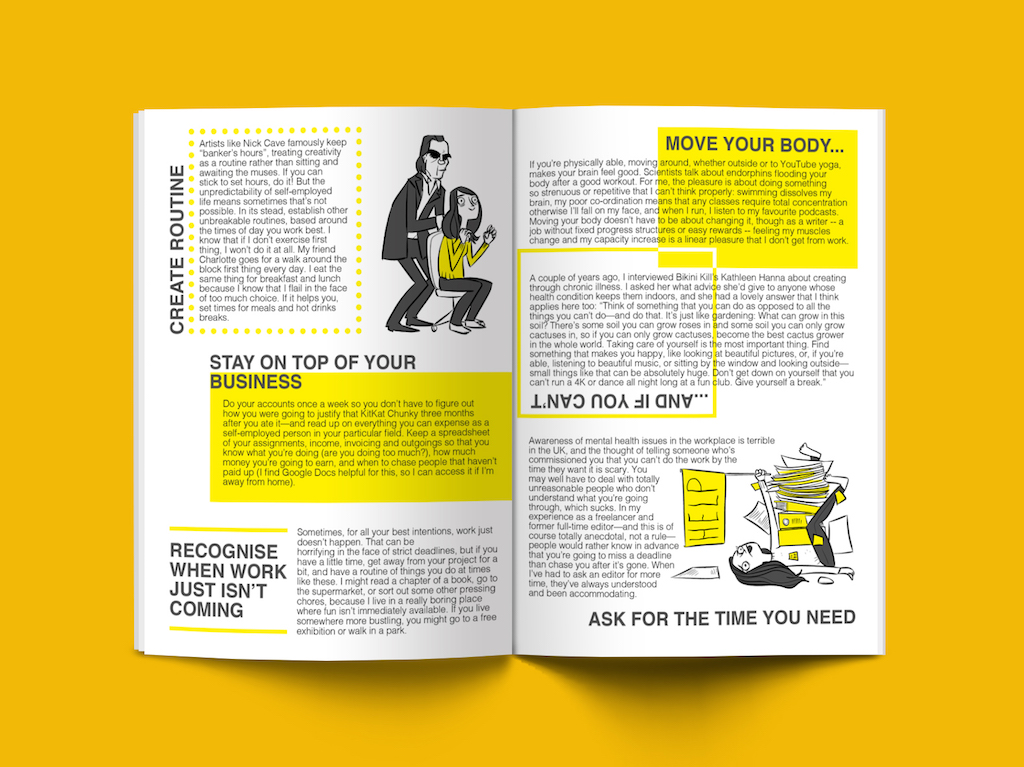
It’s also worth mentioning that this is not your average copy-shop zine. Sleek, colourful and beautifully designed, it looks and feels like an arty magazine, not only making reading these stories something of a pleasure, but challenging mental health stigma with its very format. It mainstreams these stories, declares them worth telling, brings them into the open in an attractive and accessible format, which feels radical. I can imagine feeling confident about leaving this zine on the coffee table, and that others might casually pick it up, read a story or two, and either find themselves reflected there, or learn something new about mental health.
Do What You Want is available for pre-order now, with all proceeds donated to mental health -focused charities including Mind, Beat, and Sisters Uncut.
Follow Your Arrow: “Great British Bake Off” Star Ruby Tandoh Shares Her Love of Food
Confession: I’ve never actually seen The Great British Bake Off. Nope, my deep and growing love for food writer Ruby Tandoh stems almost entirely from her scathing condemnation of the ‘clean eating’ movement …though her brilliant columns in The Guardian and ever-acerbic Twitter posts may also have something to do with it. Ruby’s love of food and its place in our lives, relationships and rituals shines through in her recipes, and her advocacy of normal eating in the face of a world that wants to sell us a deeply disordered version of ‘wellness’ is refreshing and important.
Recently voted the UK’s favourite ever Bake Off contestant, Ruby stole hearts when she appeared on the show in 2013, at the same time as studying for her degree. Shortly after, she came out publicly, giving the finger to critics who suggested she had flirted with presenter Paul Hollywood to ‘get ahead’. Since then, Ruby has gone on to become a freelance food writer and the author of two recipe books: Crumb: The Baking Book and the newly-published Flavour: Eat What You Love.
In this month’s Follow Your Arrow, Ruby tells the story of how her work has developed from that initial moment in the spotlight, offering a window into the life of a freelance food writer who never quite intended to become one but has found a calling in sharing her love of food.
Ruby Tandoh, food writer
Age 24, Sheffield, UK

Hi Ruby! Can you introduce your work in a paragraph?
I’m a freelance food writer, so I write a mixture of recipes and articles for various media outlets, including the Guardian, Vice and ELLE UK. I’ve written two cookbooks, both published by Chatto and Windus, an imprint of Penguin Random House.
How would you describe your approach to self-employment or business?
I used to be a real chancer, just taking commissions as and when, and working all night to meet deadlines that I’d forgotten I had. As time goes on, though, I’ve got much better at keeping on top of work, logging my assignments as they come in and taking control of my work-life balance.
What personal qualities inform your approach?
Obviously cooking is a really creative, tactile thing, and I love that way of working. I think that pushes me towards visual approaches to my work — drawing sketches of foods, making recipe mind maps, colour coding literally everything. I like my work to feel colourful and woven through with my personality.

What does a typical day look like for you? Do you have a routine?
I’m terrible at keeping a routine, but I’ve been trying harder recently. I have to get up and get showered before my fiancee leaves the house, or I just can’t muster the energy. The days when I try to work in my pyjamas are the days that I end up rolling back into bed by midday. I’m really bad at taking breaks once I get working, though, and I can get kind of stuck in my head. But in the evening is have dedicated down time, which helps.
Most of my work is writing – whether that’s recipes, books, columns or one-off commissions for newspapers and magazines. I spend a lot of time on the laptop, either writing or doing admin. What I love most is researching food though. I love going to restaurants and cafes and bakeries and tasting whatever I can, I love trying recipes, I even love going grocery shopping.
What is your workspace like?
I have a desk in the living room but I rarely use it. It’s beneath this massive poster of Serena Williams, which is pretty cool. Most of the time I work at the kitchen table — it means I can be close to the food I’m writing about.
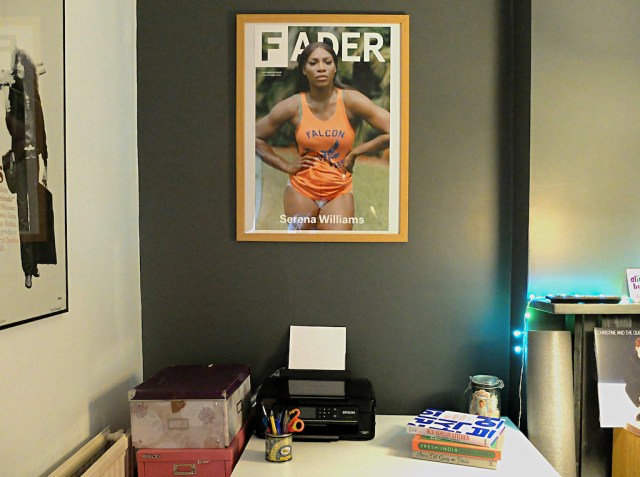
When did you know that this was what you wanted to do? And what were your early goals, your first steps?
I’ve always loved reading cookbooks. I read them like novels, cover to cover. When I was younger, I thought this was just because I was fascinated by food and flavour, but as I grew older I realised that I also immersed myself in these books for the words themselves. Whether that was Nigel Slater’s odes to garlic or Claudia Roden’s luxuriant descriptions of middle eastern food, I loved it all. I knew that I wanted to be able to do something similar. I wrote a little food blog for a while, but I seldom updated it and the writing was silly and overblown. I look back at it and cringe. It all started in earnest when I started a baking column at the Guardian, in the wake of the Great British Bake Off. Every week I relished writing that column — I never wanted to stop basking in the glory of food and words and cooking.
As you said, Bake Off opened some exciting doors for you. Do you think you would have pursued the same career if you hadn’t been on that show?
I doubt it. As I’ve mentioned, I have long loved food writing, but I doubt I would ever have had the confidence, the stamina or even the talent, to be honest, to make it in that world if I hadn’t had the launch pad of the Bake Off. The truth is, food writing is terribly elitist and classist. It’s tough finding people in that world who aren’t privately educated, well travelled, comfortably off. As a working class girl from Essex, that wasn’t really a world I would have fitted in to. I might have ended up writing in some other field, though. It was always a dream to write things that demystified a topic, stripped it of intellectualism and made it accessible to people — maybe I would have done that for philosophy or for art history (my degree subjects). I was really lucky to be able to take that path within food.
From the outside, it looks like your work straddles two worlds. There’s the one where you write for the Guardian and publish lovely, quite mainstream-looking cookbooks, and then there’s the Ruby I see on Twitter, Vice and other websites with a counter-culture message about normal eating, critiquing the current obsession with ‘clean eating’ and so on. Does it feel to you like two separate worlds?
It definitely does feel a bit weird sometimes. You’re right that there’s a gap between the mainstream, kind of traditional aspects of my recipe writing and the more polemic things that I write about eating disorders, wellness, classism and bodies. Food media is really insular and tries hard to be apolitical, but I don’t think it should be that way. I want the two strands of my approach to food — personal/practical and political — to come together in what I write.
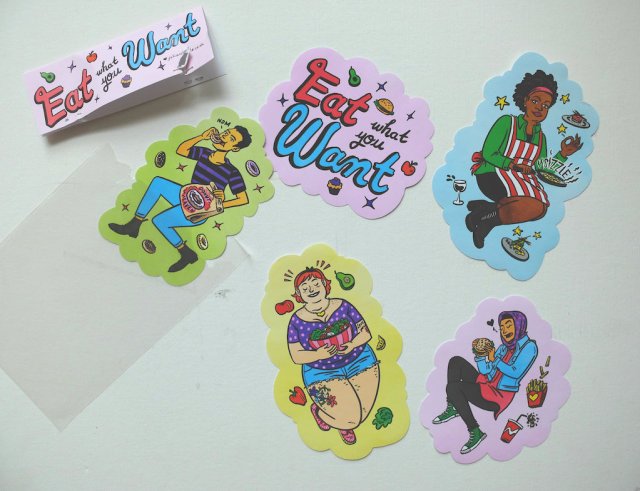
Ruby and her girlfriend Leah created a sticker set to promote their ‘eat what you want’ message and raise funds for eating disorder and mental health charities.
What makes you spring out of bed in the morning? What’s the best thing about the work you do?
Eating! I just love eating. I keep this food diary — a little mustard yellow book where I write down everything that I eat. All of these things are precious to me, they are milestones and memories. I live for it.
And the worst?
The bittiness of it all. Chasing invoices, emailing pitches, replying to editors, proofreading, testing recipes, shopping for ingredients, reading around the subject, filing tax returns… sometimes I feel a bit all over the place, although of course I feel lucky to even have the luxury of variety in my job.
What are the key challenges you face in your work? What are your tactics for overcoming these?
I personally find it really difficult navigating the world of publicity. I come across really outspoken and confident on social media, but in person I’m really, really shy. I get sweaty and shivery and sick before interviews; I hate groups of people; I feel ill with stress in a crowd. So standing up tall and promoting myself can be really tough for me. I’m working on it, by practising being assertive and by attending therapy sessions, but it’s a really stressful thing for me.
How do you approach time management?
I actually thrive when I’m given a last minute deadline. I think I need that pressure in order to be able to deliver the goods. If I’m given too much time to complete a job, I begin to overthink and second-guess, and I get so stressed about just the prospect of the work (not matter how straightforward it turns out to be) that I use up a ton of emotional energy just being anxious. I’m trying to manage this better by entering all my jobs in a diary/calendar so I can compartmentalise a bit better.
And what about work-life balance? Has your social life been impacted?
Because I don’t have a boss keeping an eye on me, I can be guilty of letting my work sprawl over the weekend and seep into all the cracks of my life. I need to get better at having set work and leisure times! I have plenty of time for friends and for my partner, but I get so tangled with the work that this time often passses me by.
Can you tell us about your financial situation when you started out? And did you have start up costs?
I was a student when I started, so really had no money to spare. Luckily there were no startup costs — all I need was my laptop to get going. I feel fortunate about that.
Is your work/business sustainable now? How do you feel about the money side of ‘following your arrow’?
It’s more or less sustainable, at the moment, but I’m always hyper aware of how much money I have left, and I’m definitely considering getting a supplementary job (in a cafe or bakery, I hope) to help make ends meet if ever I begin to run low on cash. I have some savings, which I’m really proud of, but nothing too impressive. I have this budget spreadsheet that my fiancee helped me set up! I try to be careful with money.
Where would you like to see yourself in five, ten years’ time?
Ideally, I’d love to be writing cookbooks and food books, still, but that might not be realistic! It’s a market driven by trends, and there’s no predicting whether my style of cooking will still be relevant then. I’d also be really happy working as a cook or baker, so that’s an exciting option too.

How do you market your work?
A lot of the marketing for my books is done by the marketing team at my publishers, and when it comes to my freelance writing jobs, they don’t really need any marketing. I guess to a degree I market myself as a personality, too, but that idea feels really uncomfortable to be honest! I mainly just use my social media platforms to share my ideas, chat to people, get a sense of what’s going on in the food world around me.
What’s the most valuable tool in your kit?
My editors! They are the ones who pull my sometimes sloppy prose into shape, and correct my awful grammar.
How does being LGBTQ — and in particular how did your public coming out — impact on your work (if at all)?
It hasn’t really had an impact to be honest. Or at least, it hasn’t had an impact that I’m aware of. Maybe if I’d been pushing for a job in the more commercial, glitzy world of TV cooking then things might have been different, but to be honest in food writing it isn’t really a big deal. I wish there were more LGBTQ food writers, though — it can be a pretty stiflingly traditional (read: heteronormative, and very white) world.
What’s your hot tip for queer women who want to work for themselves?
Find a network of like-minded queer women to work with, seek advice from and befriend! We gotta stick together.
Ruby’s latest book is Flavour: Eat What You Love, and you can check out a whole load of Ruby’s recipes at Flavour (make mine those gorgeous carrot and feta bites…). She tweets at @rubytandoh and you can also catch her and many beautiful food photos on Instagram @ruby.tandoh.
Are you a queer woman working for yourself? Wanna share your story with Autostraddle? Brilliant! Drop me an email! beth at autostraddle dot com.
Fool’s Journey: Wands Show Us That Actions Speak Louder Than Words

Header by Rory Midhani
The tarot’s fiery suit of wands is the realm of action, passion and inspiration. This is where we find our dearly-held ideals reflected back to us, where we gaze into the flames that burn deep inside us and discover what makes us feel fired up and excited. The cards here encourage you to push at your boundaries, go deeper into your principles, get out of your comfort zone and really challenge yourself. A journey through the deeply creative suit of wands sees the development of inspiration into something tangible, showing how we take that spark or fire within us, and make it manifest, as activism, projects, art and more.

From Thea’s Tarot by Ruth West
The flip side of this is, of course, frustration, burnout and failure. It’s here that we also find the overwhelm that comes from taking on too many things and broaching our capacity, and the necessary experience of failure. Not every exciting project can be a roaring success and the suit of Wands reflects this without judgement.
Naturally, these are often cards of ego, arrogance and conflict. Where passions run high so too does our delicate self-esteem, as well as the defences we create to protect ourselves and our egos. Whilst Wands cards can make us feel invincible, they can also remind us of our fallibility. Whilst they encourage us to Act! Begin! Do! they also show us that our capacity is not unlimited. Welcome to the rollercoaster.
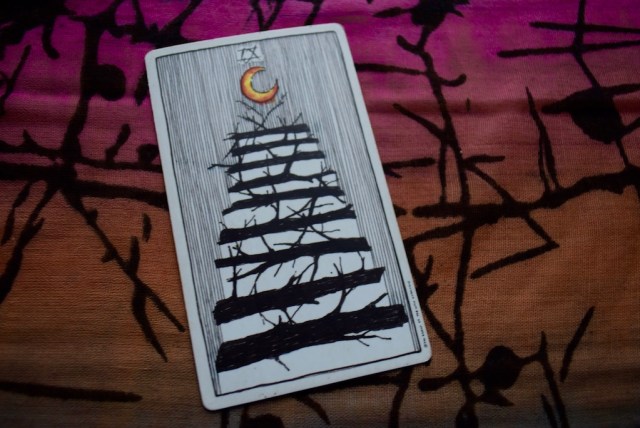
From the Wild Unknown Tarot by Kim Krans
I feel like the wands cards are always challenging me to think deeply about my commitments, the way I use and focus my energy. They call me out when I’m directing it in all the wrong places (whether that’s from procrastination or plain fear) and encourage me when I’m on the right track. Most importantly, the wands cards bring me back to what I really believe in, what matters to me in my soul and in the realm of the wands: my wise old gut.
Today, I’m feeling like I need a big injection of that fiery, activist energy. I want to get all of my Wands cards out and play with them, let them inspire me. So I’m gonna take a whirlwind tour through the suit of Wands and follow that gutsy, fiery energy as it burns high and bright, or low and smouldering. Grab your cards and join me!
As always, these interpretations are brief, general and are my own. Please add your own ideas and interpretations in the comments!
The Ace, Two and Three of Wands take us through the initial stages of starting a project, from inspiration, through planning, to your first steps. The Ace is where you have your Big Idea. This is where the Universe says YES! YOU MUST DO THIS THING! (You might not actually know what that thing is right now, but that’s not important.) Right now, we’re all about positivity, a burst of energy and a sense of real possibility in your gut. Focus on your ideals, your principles, the stuff that gets you all fired up. If you’re gripped by the urge to start something new, take this card as a massive thumbs up. If you’re feeling stuck and bored, change direction. It’s time to up the energy!
When you feel this way, it’s likely that you want to get started right away. However, the Three of Wands is where the action comes in and you can take your first real steps; before that, you gotta spend some time thinking it all through.
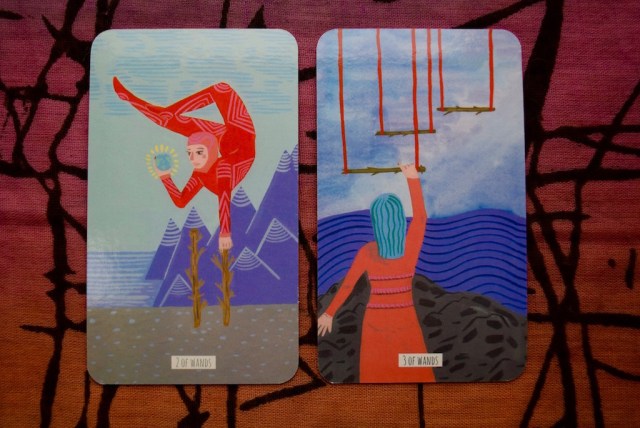
From the Circo Tarot by Marisa de la Peña
The Two of Wands is a card of stillness, I think. There’s frustration here, a sense of being pulled in two directions at once as you fight the urge to leap straight in, and instead allow your idea to crystallise. You quiet your ego, which craves the glamour of action. There’s an ebb and flow of throughs as your mind wanders through your idea — if there’s a ‘planning’ card in the wands suit, this is it.
Then, when you’re done thinking, you’re reading for that first step! When you see this card in your readings, it’s time to be bold, to step into what may feel like the unknown, in pursuit of success. It’s a card for self-belief and for committing to make your dreams a reality — even if it’s possible you may fail.
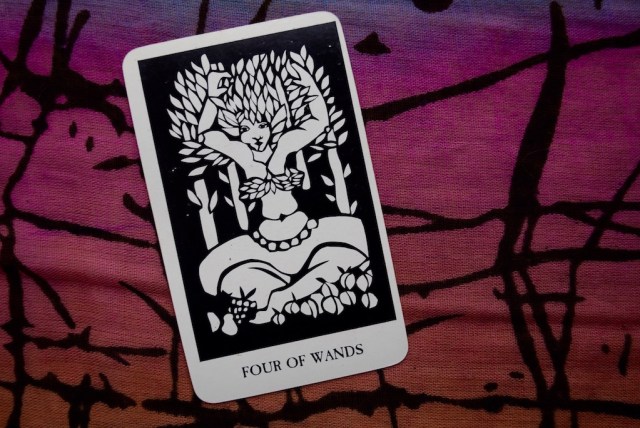
Thea’s Tarot
The Four of Wands represents that stage in a project that we most often forget: the bit where you get to stand back for a moment, realise how freakin’ brilliant it is that you made a start on this thing, and give yourself a massive pat on the back. It’s a card of celebration and letting your hair down, traditionally associated with weddings and other community celebrations. I often see this card appear to simply say “take a night off,” but it’s also about recognising the hard work you’ve put into something. Or, it could just mean a party.
By the time we reach the Five of Wands, we begin to encounter the darker stuff that comes from acting on your beliefs and principles. Like I said, so much of what drives us is ego, and the Five of Wands is where we see that ego bumping up against others.
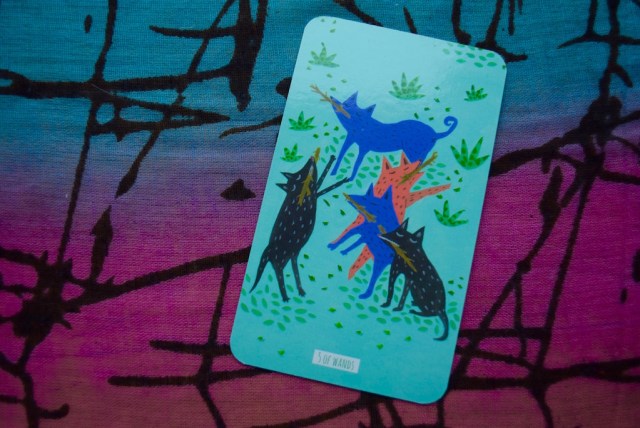
The Circo Tarot
I tend not to take this card too seriously in a reading (there are others for more serious conflicts, like the Five of Swords) — to me it signals a sort of ‘playground politics’ situation. That macho behaviour where everyone is shouting, just to find out who’s loudest, who’s at the top of the pecking order…and who’s at the bottom. We’re sussing out the hierarchies in our situation. So often, I feel like the Five of Wands is advising a person to rise above it and focus on what’s really important — but sometimes it can be fun, or actually helpful to engage in this heated energy.
The Six of Wands continues the ego theme, discussing pride and victory. It’s traditionally a card of success, showing a person riding home from battle having ‘conquered their enemy’, and you can definitely interpret it that way in your readings — I regularly see it popping up simply to say “that went well!” A more nuanced reading delves into the specifics of your situation, in particular this idea of having won the battle, but not necessarily the war. It’s so easy to get caught up in the little victories that satiate our ego, forgetting the bigger struggle at hand. In this way, the Six is a reminder to take a look at the bigger picture and make sure you’re focusing your energy on what actually matters.

Thea’s Tarot and the Wild Unknown Tarot
I think of the Seven of Wands as the activist’s card, as for me, it’s centred on themes of standing up for who you are and/or what you believe in, even if you are in a minority of one. It represents a dilemma to which all LGBTQ folks can relate — whether to be visibly out and proud, or hide or tone down your queerness so as not to cause others discomfort (or jeopardise your safety). I love the way Kim Krans illustrates this card in the Wild Unknown Tarot — a burning flame, perhaps just a little match, bright enough to cast all of its adversaries into the shadows. Where the pride in the Six of Wands often begs further exploration, I usually read the Seven as encouragement to be proud of who you are, or to stand up and fight for what matters to you.
The Eight of Wands is one for getting your message across. From writing concise emails to finding the courage to grab the mic, this card suggests communicating with clarity and efficiency. It’s a good card for community situations, advocating for the swift and objective conclusion of issues, encouraging you to speak up, be heard and be counted.
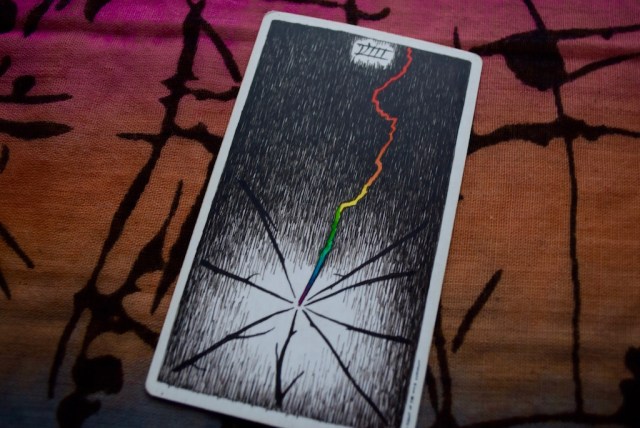
The Wild Unknown Tarot
The Nine and Ten are where we find the inevitable burnout in the suit of Wands, though they deal with it in different ways and advise different remedies. Both witness your tiredness, both let you know that you’ve taken on a lot, or worked hard, or are close to your limit, and that this is taking its toll. However, where the Ten of Wands just looks like flat out exhaustion — a person weighted down by all those projects and ideas, unable to do much of anything whilst carrying so much — the Nine of Wands is a more encouraging sight. “Don’t give up!” it urges, “you’re nearly there!” Again, I think of the Nine as an activist’s card — one that reminds you that this was never going to be easy, and that it’s worth pushing through when the going gets tough.
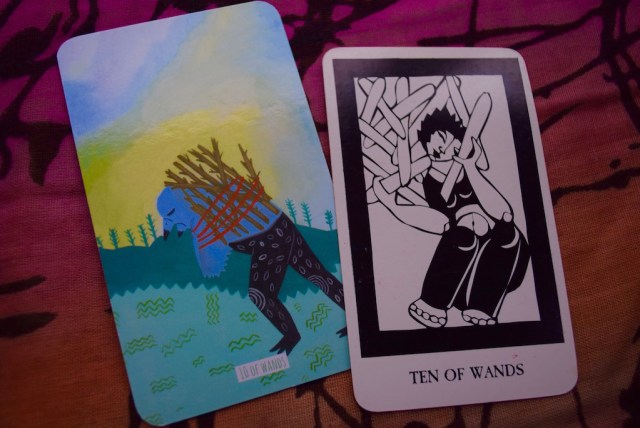
The Circo Tarot and Thea’s Tarot
This brings us to the ‘people cards’ of the wands suit — the Queen, King, Page and Knight, or whatever they may be called in your deck. These guys make a pretty rad bunch!
There’s the Queen of Wands — my favourite of all — confident, witty, unapologetic, unafraid to be 100% who they are. In the Rider Waite Smith version, Pamela Colman Smith seats her with knees spread wide, an image I adore. The attitude is like, ‘here I am and honestly, you can like it or lump it but I ain’t changing’. What a role model. A feminist and a champion of the freaks, the outcasts and the activists. The King of Wands, then, is a natural leader, someone who possesses that organiser know-how, who can gather the troops and get a thing done. Fearless and experienced, the King displays that awesome ability to get everyone on board with their cause, and who knows how to encourage people to work together, by demonstrating great leadership.
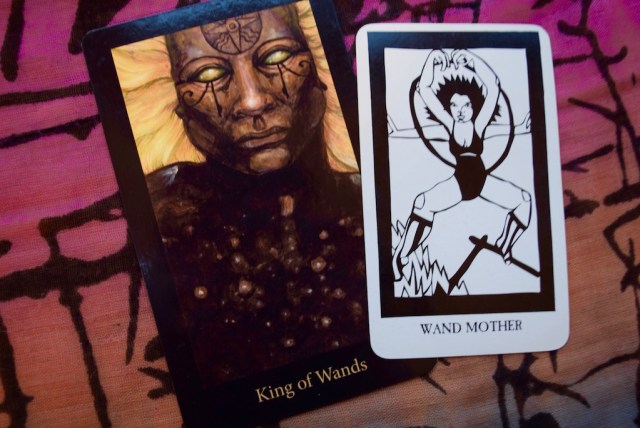
The Mary-el Tarot by Marie White, and Thea’s Tarot
The Knight of Wands is where we see a pumped-up ego at it’s loudest and boldest, trumping the idea itself. As the ‘teenager’ of the wands suit, this represents someone who is totally fired up about their awesome idea…but lacks the foresight to see it through. It’s not necessarily a negative card, though — often, this ‘don’t think just do’ energy is exactly what your situation needs! Just be aware that this is the kind of energy that burns out fast, and that to see your ideas through, you’ll need to ‘mature’ pretty quickly. Meanwhile the Page of Wands is a curious soul, someone who wants to explore their idea, travel, learn, look at it from many different angles. The Page represents that wonderful willingness to experiment — unlike the Knight, it’s almost ego-less, not caring what anyone thinks or the fame their actions may bring, but instead, fascinated by the idea itself, the spark. The Page tries stuff out, doesn’t care about failure, loves to push at their ideas and see which ways they can be bent.
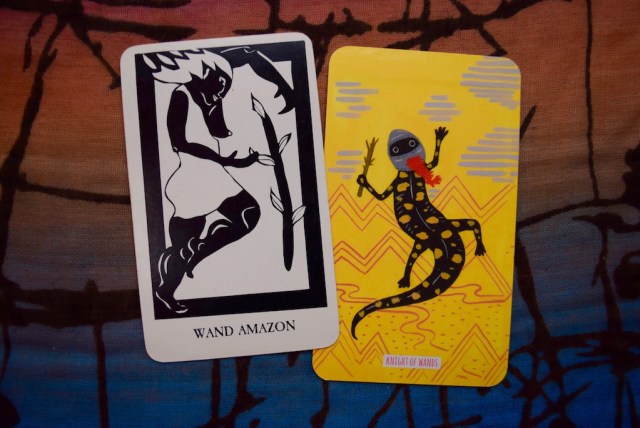
Thea’s Tarot and the Circo Tarot
Also! If you’re interested in exploring the tarot suits in this way, I’ve shared similar posts about the other three: Cups, Pentacles and Swords.
Follow Your Arrow: Mushroom Grower Marita Smith on Patience, Permaculture and Petri Dishes
Marita Smith has one of those jobs you never knew you wanted. That’s right: she’s a mushroom grower! Working at the fabulously fungal intersection of biology and what I can only describe as sheer magic, Marita spends her workdays in a converted caravan or out on the hillside encouraging the world’s weirdest not-actually-a-plant to grow, so she can harvest nutrient-dense mushrooms for happy customers in Milton, Australia.
In this interview, Marita tells the story of her three-year-old gourmet mushroom farm, from its beginnings as an experimental side-project to her now-daily routine as the sole trader running Milton Mushrooms. This is also a story of living frugally, and of the role of patience and flexibility in a business that relies so heavily on nature. If you’ve ever fantasised about making a living from farming, or wondered if it’s possible to turn that gardening side-gig into something more, Marita’s passion for shrooms and growing will inspire and encourage you.
Marita Smith, Mushroom grower, Milton Mushrooms
Age 27, Milton, NSW Australia
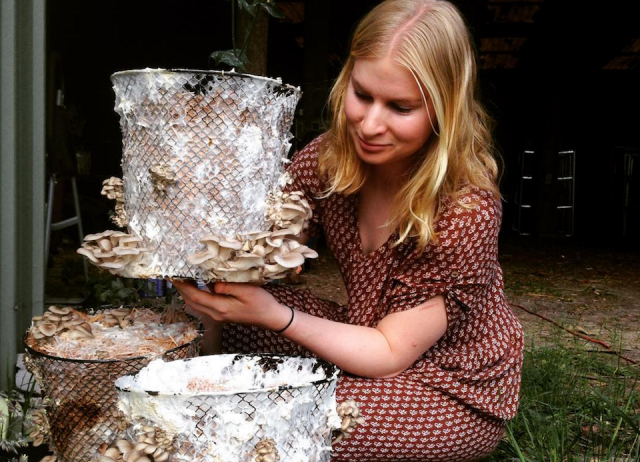
Experimenting with growing containers.
Hi Marita! Can you introduce your business? What’s your mission? Who do you serve?
I run a one-woman gourmet mushroom farm. My aim is to grow nutritious food for my local community and provide others with the means to do the same. I believe we should be growing as much of our own food as possible, and mushrooms fit neatly into any sustainable growing system.
I grow a variety of unusual mushrooms, mainly oyster mushrooms (pink, white, phoenix and king oyster), so my growing shed is always a riot of colour! I sell mixed bags of fresh mushrooms at two farmers markets per week and also sell petri dish cultures and grain spawn cultures online.
How would you describe your approach to business? What personal qualities inform your approach?
When I started, I was definitely winging it. I was just excited to be growing and trialing new methods, foraging and starting culture lines. As a result, I would have waaay too many mushrooms one week and none the next. It took time to work out how to get a consistent supply of fresh mushrooms.
I still feel like I’m winging it to some extent, but I think that’s part of primary production — a really hot week can reduce yields, while a nice cool, wet series of days will have the mushrooms going ballistic. Now that it’s a proper business, I’m definitely more of a planner. I’m an INFJ, so I like to feel like I have control over the process. I sit down and calculate how many cultures I need to create, how much substrate to pasteurize, and approximate yields based on previous seasons. Probably the biggest lesson has been learning to be adaptable week to week.

What does a typical day look like for you? What is your workspace like?
I have a pretty unusual work space. My laboratory is a converted caravan annex and the growing shed is a simple structure built into the side of a hill, which provides great thermal mass.
On a typical day, I get up around 6am. I have two semi-industrial pressure cookers that I use to sterilize growing media (both home-made nutrient agar for culturing and soaked grain for mature cultures). I typically run both pressure cookers twice a day, once in the morning and once in the afternoon. I’ll spend a few hours in the lab working on new cultures and then move outside to prepare 200 – 400 litres of growing substrate, mix through spawn and bag up for fruiting in the growing shed. I tend to prioritize this sort of work before checking emails and mailing customer orders, which I do later in the afternoon. I always make time for a run or a walk, whether first thing in the morning (typically in the summer) or in the afternoon (winter).
During the growing season (about 6-8 months of the year), my working week is full-on. I do all the physical and technical labour, but I always try to ‘knock off’ by dinner to chill out. I really enjoy the production process (it still feels like magic to see an entire shed filled with mushrooms), so it doesn’t really feel like ‘work.’ Plus, homegrown mushroom breakfasts are pretty kickass.
When did you know that this was what you wanted to do? And what were your early goals, your first steps?
I studied science at university, and after my honours year I decided to take a gap year before starting my PhD. That gap year turned into three. I worked on organic farms and farm-sat overseas before returning back to my hometown, where I worked on the family farm for a few months and decided to re-train in horticulture. I love how growing is both a way to commune with nature but also a way to apply tenets of biochemistry and microbiology. It just makes sense to me.
I was lucky enough to get a job as a market gardener/waitress at an incredible local restaurant, St Isidore. The proprietors, Jo and Alex, knew I was a science nerd and sent me to do a mushroom growing course. I loved it. For me, growing mushrooms is the perfect intersection of science and permaculture. I started experimenting and gradually scaled up, leaving St Isidore in the process. Now I’ve been growing for nearly three years.

What’s the best thing about the work you do?
I love that I’m in control of my work day, that I’m feeding my local community with nutrient-dense produce, and that I have a real place in the fabric of our town. I’m always coming up with crazy ideas, whether that’s creating bioluminescent t-shirts with a native glow-in-the-dark mushroom I’ve cultured or altering the nutrient profiles in my nutrient agar (malted milk powder is the bomb). It’s genuinely exciting work that feels like play.
And the worst?
Weather extremes. Last summer we had a series of crazy hot weeks and I lost successive crops. When each fruiting bag of mushrooms represents six weeks of labour, it’s a punch in the gut.
What are the key challenges you face in your work? What are your tactics for overcoming these?
Probably the fact that I work solo. I am really lucky to be leasing some land from my parents, so there are always people around on the farm. Market days are brilliant for catching up with farming friends, and I make an effort to lure friends down for visits (Home-grown food! Beaches! Mountain hikes!). There’s a great network of small farmers in Australia and we typically meet up every year in ‘Deep Winter’ for an unconference of ideas, stories, and feasting.
At the same time, I’m a bit of a hermit and hate it when people drop in unexpectedly! It’s a balancing act that I’m still working on perfecting.
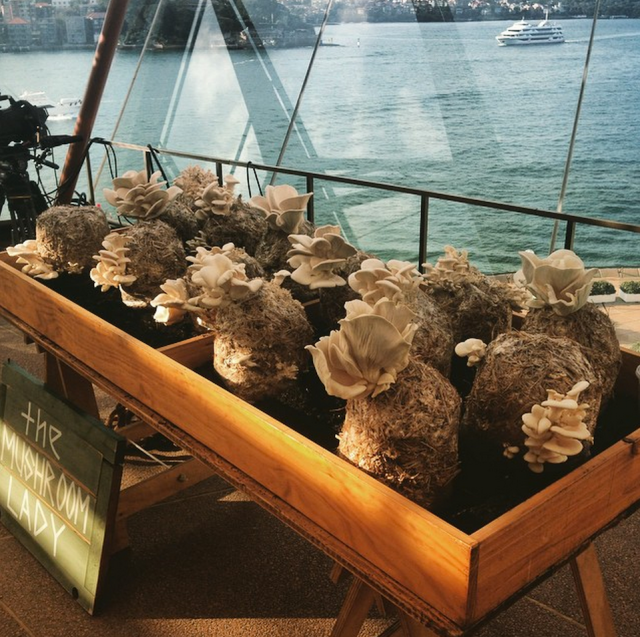
Marita’s mushrooms at a TedX event.
How do you approach time management?
I always aim to get a good chunk of my actual work done before I even think about checking emails and orders. I let my phone ring to voicemail while I’m working in the lab or outside. I also love getting started early. My Dad always says that ‘half the day’s gone by 9am’.
Let’s talk money. Can you tell us about your financial situation when you started out?
Growing mushrooms is definitely not a get-rich-quick scheme, but can luckily be done on a shoestring budget with some ingenuity. Large commercial operations import spawn from the Netherlands and employ dozens of professional pickers. I’m just one woman! When I started out, people knew me as the ‘girl growing mushrooms in her caravan,’ which was perhaps not the most flattering anecdote to have attached to your name. I grew sporadic buckets of mushrooms and gleefully shared them with friends. I expanded slowly, investing in movable infrastructure (shelving, my pressure cookers, a HEPA flow hood) from my savings. My first year, I made a pittance. My second, I covered all my costs. Now I’m making a bit on top of covering my costs.
Is your business sustainable now? How do you feel about the money side of ‘following your arrow’?
I cover all my costs and make enough to live on, so I count that as sustainable. I’m still learning how to make production more viable and streamlined. I never want to reach a point where I’m not assessing and tweaking my methods.
I also have a side-hustle, a small academic editing business, which helps cover any lean times. I live on about $15,000 a year, so I’m yet to pay tax. For me, it’s about finding a way to live simply, support myself, and contribute to my community. I feel really blessed to be able to live a self-directed life. A perk of my business, with its 6-8 month growing season, is the down-time over the winter, which I wouldn’t trade for any money. I get to spend time on my writing, exercise and exploring.
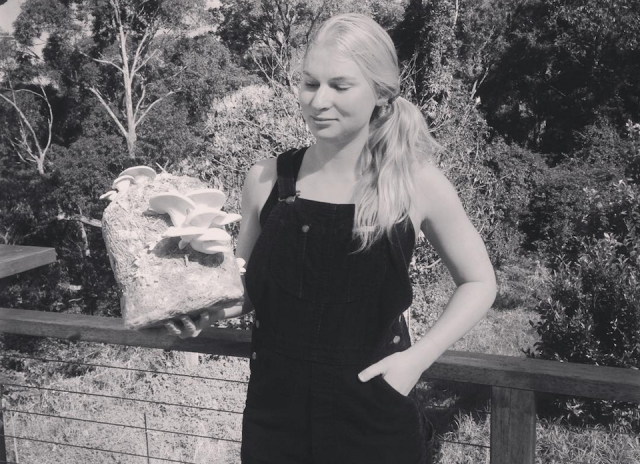
Where would you like to see yourself in five, ten years’ time?
I’ll be living in my tiny house (I’m still half in the caravan, half inside the main farmhouse right now) and ideally be supplying even more mushrooms to my local community. I’d also like to be producing medicinal mushrooms and extracts (two of my sisters have Crohn’s disease and it’s a passion of mine to grow some immune system-boosting mushrooms). Hopefully I’ll have perfected my bioluminescent mushroom experiments too!
How do you market your business?
I rely on direct farmer-customer contact both at market and via instagram. Instagram is great for communicating about growing successes and failures, and I’ve grown specific species based on insta feedback!
What’s the most valuable tool in your kit?
Oooh, that’s a tricky one. I think it’s my ability to find the zen in repetitive tasks like culturing.

Culturing mushrooms in petri dishes.
How does being LGBTQ impact on your business (if at all)?
I don’t make a big deal of being a total gay-mo, but most people in my community know I’m gay and are cool with it (which is awesome in itself because I live in a regional area).
What three websites, blogs, books or people do you rate for business advice or ideas about your work?
The mushroom grower’s bible is Growing Gourmet and Medicinal Mushrooms by Paul Stamets. It’s my go-to for questions about species-specific growing conditions, trouble-shooting, and beautiful, inspiring photos.
My living ethos is pretty well captured in The Art of Frugal Hedonism by Annie Raser-Rowland and Adam Grubb, which I recommend if you’re into simple living and skirting scary things like Mortgages and Big Debts.
For a general kick in the pants to start your business, check out The $100 Startup by Chris Guillebeau. You definitely don’t need lots of coin to get your idea off the ground.
What’s your hot tip for queer women who want to start their own business?
Do it. I’m so glad I had the guts to do it. I’m the happiest and most empowered I’ve ever been in my life. Associate with people conducive to your business idea and your way of life and your days will be more vibrant, exciting, and rewarding. We’ve only got, what, eighty or ninety years of life? Why not spend them doing things we truly believe in? I think Seneca, in his treatise ‘On the Shortness of Life’, sums it up: “So it is: we are not given a short life but we make it short, and we are not ill-supplied but wasteful of it.”
Don’t waste it. Don’t be ninety five and wishing you’d grown root vegetables, met a hot lady farmer in overalls and raised dairy goats together; started your lunar cycle consulting business; converted a bus to a retro diner on wheels; taught people how to survive in the wilderness; or written that book.
Just Freaking Do it.

Marita with her neighbour, Mindy.
If you wanna do it (I do!) you can find inspiration and information at Milton Mushrooms. For more shrooms, head to @miltonmushrooms on Instagram, or hang out with Marita herself @marita_smith.
Fool’s Journey: The Slow Holler Tarot, First Impressions and Favourite Cards

Header by Rory Midhani
Happy new year, tarot lovers! If you’re new year’s resolutions involve something along the lines of ‘do more tarot’, I’ve dug out a few posts which might help. Here are some neat, simple ways to make tarot a part of your daily routine this year. Where to start if you’re a tarot newbie has some tips for getting started with tarot. Did you get a new deck for Christmas? Get to know it with this tarot deck interview spread. And this creativity and courage tarot spread can help you manifest your new year’s goals. Have fun!
In my little queer tarot bubble, the most hotly-anticipated tarot deck of 2016 was the Slow Holler Tarot. A collaboration between over 30 artists and writers with queer and/or Southern ties/identities, Slow Holler crowdfunded back in April 2015 and took a painstaking 19 months to come into being.
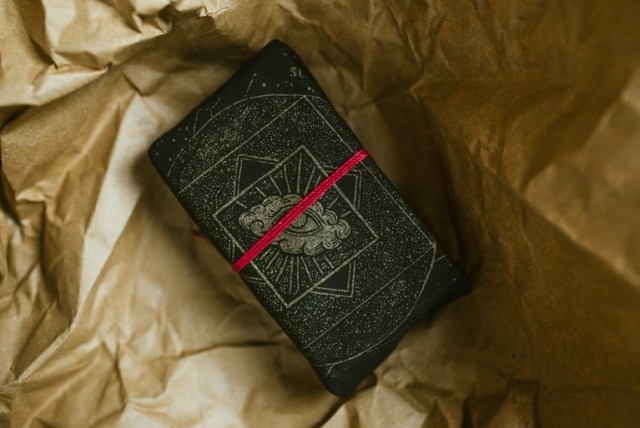
Photograph by Elisabeth Waller
It’s finally here! Those of us who pre-ordered during or after the project’s phenomenally successful Kickstarter should already have their decks (and if you didn’t, you can pick one up direct from the makers). Mine arrived a few weeks ago and since then I’ve been slowly getting to know these beautiful cards.
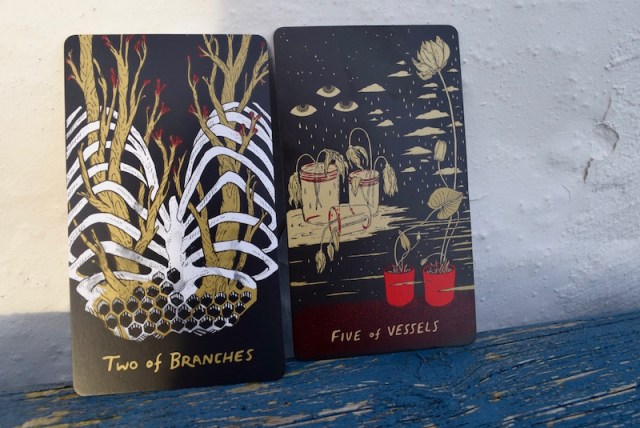
Like all tarot decks, Slow Holler reinvents the tropes and traditions of tarot, offering its own take on the archetypes and experiences that make up tarot’s structure. In this case, that means through the lens created by those queer and Southern ties. What does it mean for a deck to explore ‘Southern identities’? As a white, middle-class lass from the UK, it’s hard for me to know (hence this not being a review as such, but more a sharing of impressions.) When I spoke to the project’s founder E Henderson back at the beginning, they talked of storytelling, marginalisation, and a rootedness in place that may feel alien to those from elsewhere:
Across the US and in popular culture, the South and its people are often portrayed as cruel, stupid, backwards, one-dimensional. But really, Southerners have varied and complex identities. We tell stories to stay awake. We tell stories to communicate. It is how we come to know each other. It is a part of our culture. We may be black, brown, white, queer, undocumented. We come from swamps, foothills, and sandy pines. We have different histories and experiences, but we came from this place and we shape this place.
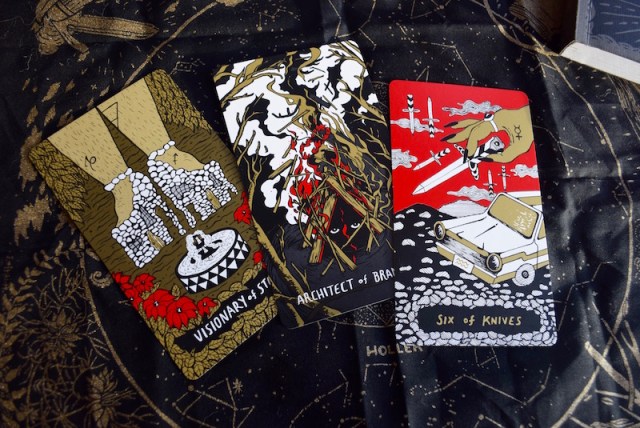
That ‘storyteller’ vibe is deeply present in the finished deck — I think for me it’s the quality that stands out the most, and that draws me in the most. From the way it comes tied in a printed handkerchief, to the common threads of red, black and gold that run through each card, there’s a timelessness here that evokes oral traditions, fables retold around campfires, the handing down of wisdom through generations. Some cards depict everyday scenes, people going about their lives, struggling, dreaming, doing. These cards give us stories we might relate to easily. Others are heavily symbolic, conveying their messages through animals, plants and objects (the plants, in particular, I adore.) Still others, like the greatest stories of all, are obscure and mysterious, leaving you wondering ‘what actually happened, in the end?’
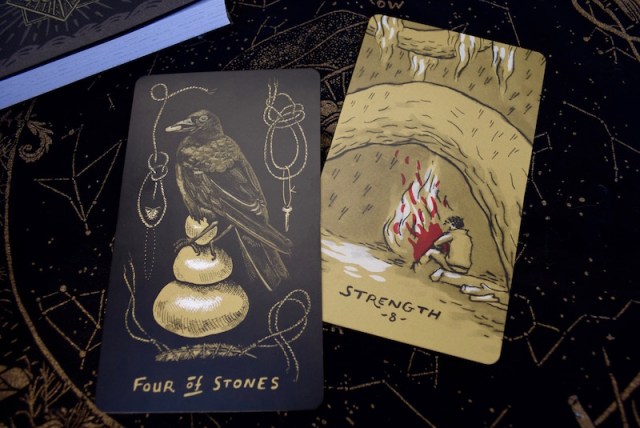
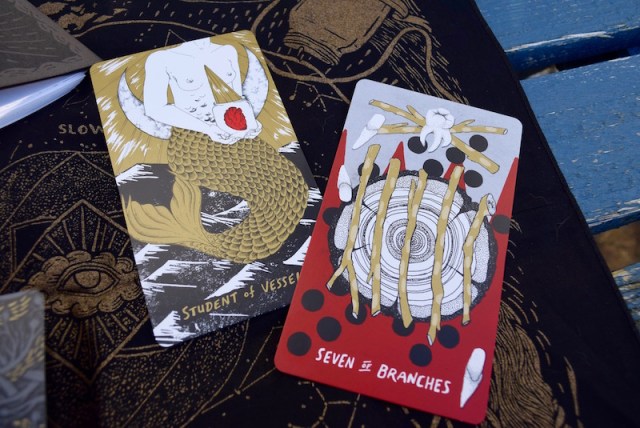
One element of Slow Holler that makes it feel outstandingly queer is the space it creates for diverse gender identities. Not a single opportunity has been passed over to question the traditional/mainstream gendering of tarot cards, and card by card and as a complete work, the deck reclaims the whole of tarot from those tired and unnecessary binaries. In their heartfelt review of the deck, Elisabeth Waller found this inclusive and welcoming:
I do see my gender queerness represented a lot. I also see lots of other folks which is so refreshing and feels so real. I see representation to so much more than that—trauma that can come from being othered, boundary issues and what is needed to heal, the need for community, and visibility of the fact that so many in the LGBT+ community have had to find and create our own families.

Some of the most heavily-gendered cards in a traditional tarot deck include the Emperor (usually portrayed as an authoritative, decidedly male figure), the High Priestess (a representation of the ‘passive feminine’…whatever that means) and the Empress (a nurturing, earth-mama type who is often pregnant and invariably characterised as female). Here, along with countless other cards, they have been lifted from these reductive constraints, freed from binary pronouns, renamed and reimagined. Yet rather than completely reinventing each card, it feels more like the creators have dug their way back to the card’s root, to that archetypal essence that existed before anyone felt the need to impose ‘hes’ and ‘shes’. The result is a a clarity and openness of meaning — it suddenly feels so much easier to get to the root of the card’s energy. This is supported beautifully by the small yet detailed guidebook, which helps make this deck one that anyone can pick up and use, regardless of their experience with tarot.
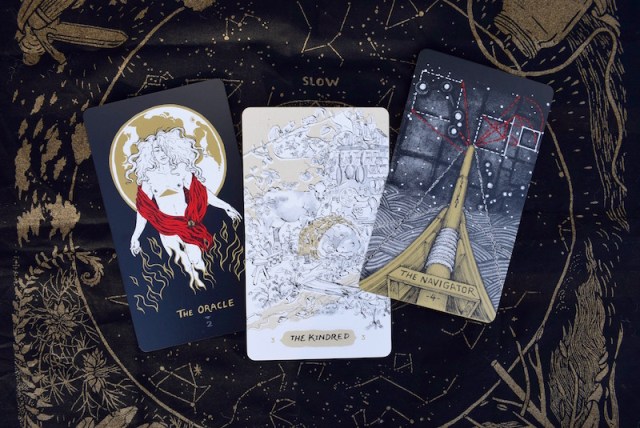
The High Priestess is now the Oracle, the Empress is the Kindred, and the Emperor is reimagined as the Navigator (one of my favourites in the deck).
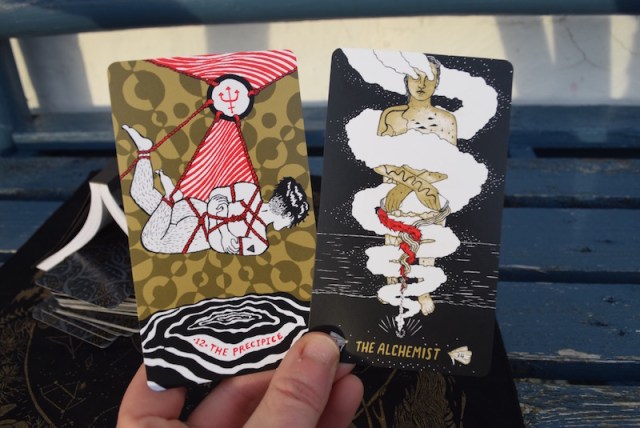
The Precipice appears in place of the Hanged Man, and the Alchemist takes the place of Temperance.
Minor cards too, the four suits and the court cards, have been renamed in a way that really resonates for me. Cups are now vessels, wands are branches (beautiful!), pentacles are stones, and swords are, brilliantly, knives. Rather than the standard hierarchy of Page, Knight, Queen, King, here the four ‘people’ of each suit are Student, Traveller, Visionary and Architect. As a self-taught tarot reader who has, like many others, struggled with the traditional court, the renaming of these cards again makes space for their essence and true energy to come through. Typically, I find tarot learners struggle with knowing the difference between a King and a Queen in a tarot reading, but here, the terms ‘Architect’ and the ‘Visionary’ really convey the underlying idea of each card.
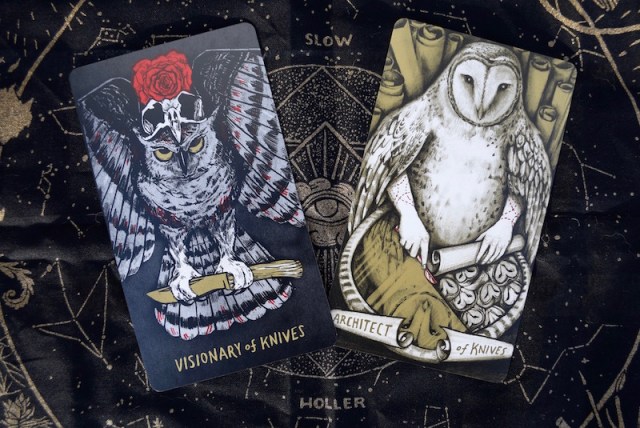
Tarot blogger Asali (who identifies as an immigrant southern queer black femme) had her own take on representations of both ‘queer’ and ‘Southern’ in her recent review, describing the agonising wait for a deck that promised so much, and her searching through the cards for depictions of her own self (I recommend you read the whole thing):
Whose queer is this? Whose South is this? It doesn’t feel like enough to me. And I am asking for a lot. I won’t stop asking for more boldly and compassionately rendered southern, black, brown, and indigenous queer bodies living out both our material realities caught up in and imagined fantasies free of webs of power. Even as I acknowledge that we are more than our bodies- we are these stories told, passed down throughout our lineages black and/or brown and/or indigenous and/or queer. I am asking for a lot.
For some, judging by the emails I’m receiving, Slow Holler will be ‘the perfect deck’. For others, of course, it will fall short – especially in terms of diversity. Even a project created by different people from varied yet linked backgrounds can’t hope to represent every experience, every facet of queer and/or Southern culture.

The cards themselves are slightly thinner than I had hoped, but not flimsy, and they shuffle beautifully. The print quality is outstanding, the matt laminate feels light yet sturdy, and the golds and reds really seem to glow from within. I adore the design on the back of the cards, of dark, interweaving branches repeated over and over — for those of you who read reversals, this design has a ‘right-way-up’, but still makes sense upside down.
The deck comes with a lovely hand-printed black and gold kerchief, and a small yet detailed guidebook aid interpretation and use. The book itself warrants its own review — its interpretations of the cards are some of the best I’ve ever read, encouraging, comprehensive, an example of what tarot really can be when it is given space.
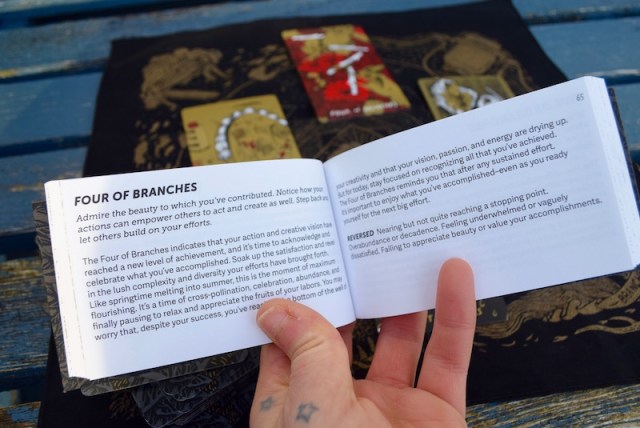

The design on the back of each card.
This is not a cheap deck by any means. At $46 is will be out of the reach of some of the folks who need it the most. This is a heavy and difficult topic for tarot deck creators who want to reach marginalised communities with their work, but also don’t want to compromise on ethics and quality, a conversation I’ve been having with E over recent months. Slow Holler has been printed locally in small quantities (cheaper tarot decks are usually mass-produced in China) and there have been many artists to compensate for their work; small batch projects like this one take a heck of a lot of resources to get off the ground, and the price has come out where it has. I have a lot of feelings about expensive tarot decks and the gentrification of spiritual practices and tools as a whole, but this is not a profiteering kind of a deck.
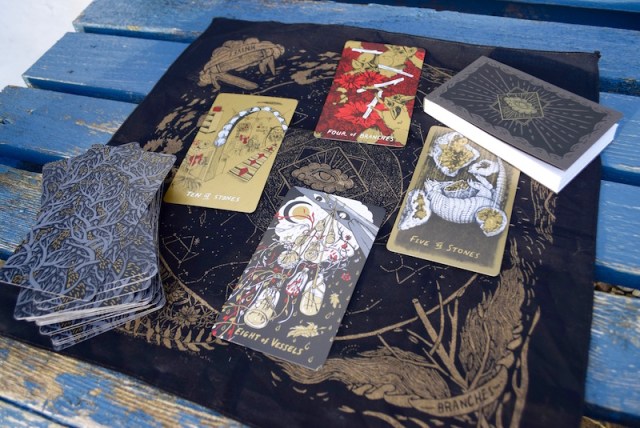
What really amazes me about this deck is how wide-ranging the artwork is, and at the same time, how intimately connected all of the cards feel. I’m not sure yet if this is simply the effect of the sparse yet sumptuous colour scheme, or it’s more the result of those common threads of identity, but as someone who struggles with collaborative decks (even the much-beloved Collective Tarot I find a challenge — the divergence in styles makes if very difficult for me to read and I tend to use it mainly for single-card draws and meditations) Slow Holler feels cohesive, whole, both a collection of 78 stories and a unified collection of stories that in turn, tells its own.
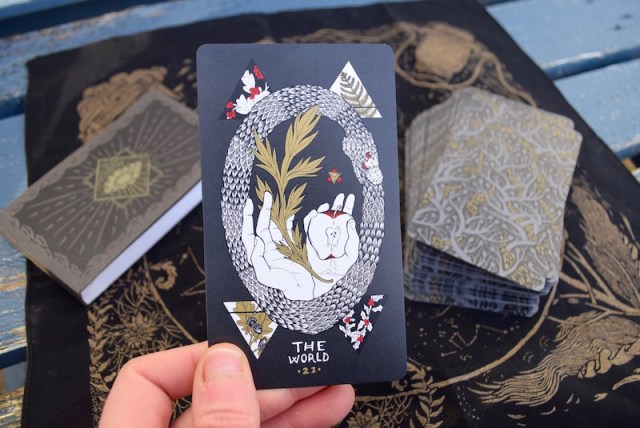
Follow Your Arrow: How LGBTQ Youth Activist Tabby Besley Built a Sustainable Non-Profit
When Tabby Besley started InsideOUT — a voluntary organisation that works to make New Zealand a safer place for queer and trans youth — she was 19 years old, unemployed, and had just moved to a new city. Fuelled by an understanding that things urgently needed to be improved for young people of all sexualities and genders, she began running workshops in schools focused on LGBTQ inclusivity, officially forming InsideOUT after a year. Four more years and a heck of a lot of blood, sweat and tears later, InsideOUT is a much-loved national charity, campaigning for inclusivity in schools, running annual festivals for queer and trans youth, and working tirelessly to educate and advocate across sectors…and Tabby’s passion shows no signs of waning.
Last summer, InsideOUT received further more recognition when Tabby was awarded a Queen’s Young Leaders award. The latest fantastic news is that the charity has received a development grant, meaning that Tabby will finally be paid for the full-time hours she works. As InsideOUT goes from strength to strength, I spoke to Tabby about just what it takes to build an idea like hers into a sustainable non-profit organisation. In the interview below she shares what keeps her going in the face of real frustration, how she’s learning to manage her time, and the astrological make-up she credits for her relaxed approach to all that hard work.
Tabby Besley, Founder/National Coordinator, InsideOUT
Age 24, Wellington, Aotearoa New Zealand

Hi Tabby! Can you describe your organisation? What’s your mission? Who do you serve?
InsideOUT is a national charity in Aotearoa New Zealand that supports young people of minority sexualities, sexes and genders to have a sense of belonging and safety in their schools and communities.
Our mission is:
1. To work with youth, families, schools, community groups, youth services, government agencies and other relevant organisations to provide safer schools and communities for young people of minority sexualities, sexes and genders.
2. To foster the building and provision of resources, education, information, hui and relevant tools which work to improve the health, wellbeing and safety of young people of minority sexualities, sexes and genders.
One of our key projects is Shift Hui – a national youth hui (the Māori word for meeting/gathering) which is kind of like our version of an A-Camp, but for younger people. It’s about creating a space for people to come together and make connections, learn about different issues facing our communities, take part in workshops and activities, and build on skills and knowledge that they can take back to their own communities to make change. It’s about wanting to see a shift in the dominant culture and making Aotearoa New Zealand a safer place for everyone, regardless of their sex, sexuality or gender.
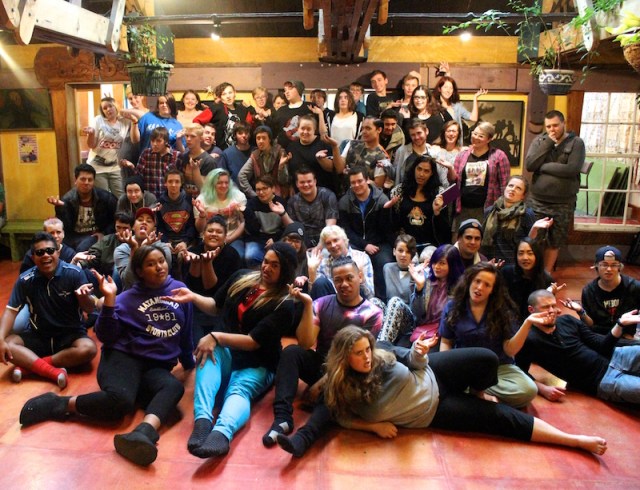
2015’s Shift Hui
We also coordinate the international Day of Silence campaign here in New Zealand and do a huge amount of work with schools, supporting young people and school staff to set up and sustain queer straight alliances/rainbow diversity groups and take other actions to make their schools safer and more inclusive environments — like implementing gender neutral uniforms and toilets. This year we launched a resource on Making Schools Safer For Trans and Gender Diverse Youth which as far as we know is a bit of a first even internationally, in the unique way that it was written and created by young people and walks schools through all the things they might need to be thinking about. While it’s often things like uniforms and toilets that are the visible issues, there are so many other areas schools need to think about, such as where trans and gender minority young people fit into school choir and sports teams, or how to update their name and gender markers on the school roll.
InsideOUT also does a lot of education and advocacy on sexuality and gender diversity for schools, youth workers, health professionals and organisations that work with young people. These are a few of the key things we work on amongst a whole range of other stuff — like a radio show/podcast, an arts competition, outreach work to rural communities and lots more!
What’s your role at InsideOUT?
Basically my role is being the CEO/director/manager/whatever you want to call it (!) of a national charity, but it started as a voluntary thing while I worked in other community jobs. Because we’re a small team, I still get to do lots of project delivery etc despite being in this kind of role where you hold oversight of everything.
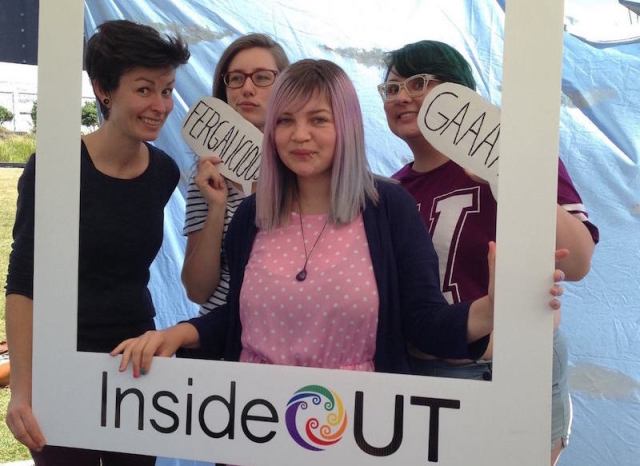
How would you describe your approach to this work? What personal qualities inform your approach?
Relaxed but organised, determined, coming from the heart. I think my astrological make-up explains my approach pretty well. I’m a Taurus Sun with an Aries Moon and a Cancer Rising. I am very grateful for this combination of earth, fire and water and I contribute it to my success in some ways! I don’t know that I’d be in the same position as I am now if I didn’t have these qualities.
My Aries energy gives me strong initiative, big dreams and determination to fight against the oppressive systems we deal with, my Taurus energy helps keep me grounded, focused and able to steadily work away at things over time and my Cancer Rising and Mars in Pisces brings compassion and a deep need to be doing work that is about caring for others, that means something, leading me to do work that is very personal. My Sun, Moon, Mercury and Venus all sit in the 10th House which rules stuff like life purpose, career, being in the public eye and our role in communities, which is very fitting for me. My work is a huge focus for me and I’ve always wanted to be doing things that I’m passionate about, things that make a difference.
What does a typical day look like for you? Do you have a routine? What is your workspace like?
I’m kind of in a transition period at the moment, as we got our first office space a couple of months ago! I’ve primarily worked from my bedroom for the last five years, so it feels like such a relief to finally have a physical space that belongs to InsideOUT and will hopefully enable me to set up some stronger boundaries around my work. I also kind of like being able to wake up and get stuck into work, snuggled up in bed, though, so I think I’ll still have some days like that!
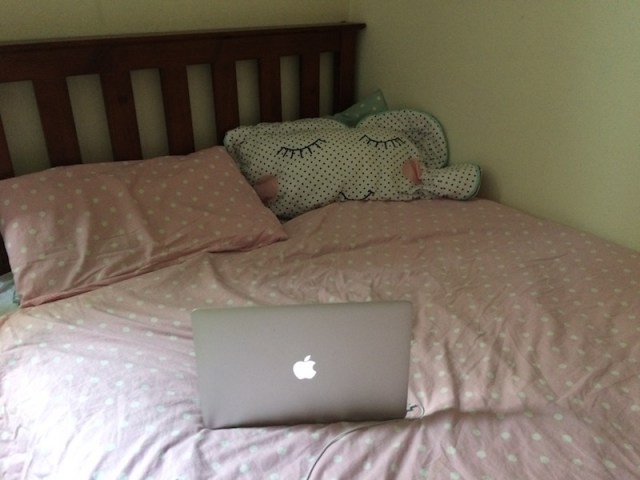
My work is pretty varied — there’s always lot and lots of e-mails! Social media, report writing, grant writing and fundraising, accounts, scheduling and administrative tasks. Lots of meetings which vary a lot — planning projects, providing advice to more mainstream organisations, catching up with other people working in the ‘rainbow’ space, working with our volunteers. Then the most exciting stuff is delivering our work — things like running our youth hui, visiting different parts of the country and running professional development training, facilitating workshops with young people, visiting schools, presenting at conferences. Every week is quite different which I enjoy!
My role requires a lot of self-motivation (luckily I’m a bit of a workaholic and very passionate about what I’m doing!) and at times can be quite isolating, but the days where you get to really see the impact you’re having make it so worthwhile.
When did you know that this was what you wanted to do? And what were your early goals, your first steps?
I spoke at a conference once about how nobody told me in high-school that changing the world was an option. You don’t hear about any kind of community or political work being a valid contribution to society! So no, it’s not something I always knew I would do.

I was lucky to go to the first high-school in NZ (and probably the entire Asia-Pacific region) to have a queer straight alliance/rainbow diversity group. I got involved leading the group and went on to work with others to set up a local community support group for LGBTQIA+ young people and their friends called Q-Youth. I volunteered a lot of my time towards the group and did a certificate in youth work, and when I finished high-school, was employed part time to coordinate the drop-in centre and facilitate our youth groups. I have always been anti the huge pressure there is on young people to go straight to university out of high-school, and at the time wasn’t able to study in NZ without paying international fees anyway, as I moved here from the UK. I was lucky that things fell into place and I was able to go straight into something I wanted to be doing.
During my time at Q-Youth we used to receive a lot of requests from people in other parts of the country who wanted support to set up groups in their schools and it become clear to me that there was a real need for an organisation to be focused on working to make schools more inclusive. When I first had that idea, it was definitely more of a ‘oh wouldn’t it be nice if someone did that’, rather than ‘I’m going to do this thing!’ One day I shared the idea with a colleague who was really encouraging and from there things kind of escalated. I moved to Wellington and decided to give it a go. I was 19 at the time and didn’t really know what I was doing, so it still surprises me now to see that we are actually a recognised national charity, doing important stuff, seeing change happen!
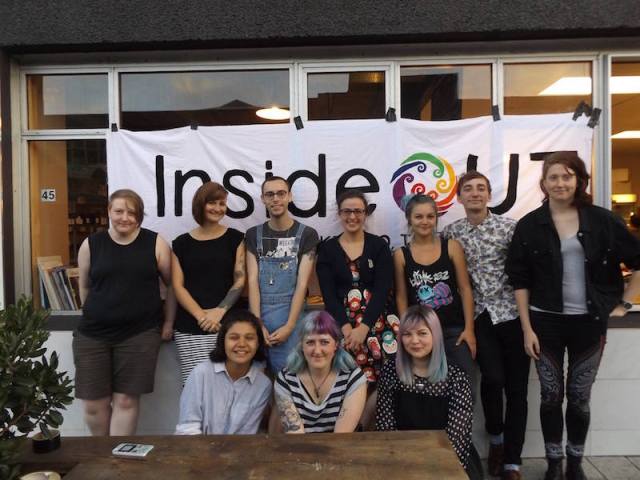
Tabby with some of InsideOUT’s volunteer team
It has taken time and a lot of hard work to get to where we are now. All my work with InsideOUT was voluntary for the first few years. I was working other jobs in the community sector and just got to a point where it was becoming really hard to manage my voluntary work on top of paid work, but it was impossible for InsideOUT to grow and do what it needed to do without someone dedicating a lot of time to it. At the same time I wasn’t feeling fulfilled in the job I was doing. I made a decision to resign before I knew whether InsideOUT had been successful in receiving salary funding, which was a bit of a risk, but luckily things worked out. So for the last two years I’ve been paid part-time hours to work for InsideOUT while making up full-time hours voluntary, as largely that’s been necessary for us to be able to deliver our projects and continue to grow. Just last week I was honoured to receive an award which comes with a grant for InsideOUT to be able to pay me for full-time hours next year. That feels pretty exciting, scary and relieving after five years of dedication to the organisation!
Why do you do this? What makes you spring out of bed in the morning? What’s the best thing about the work you do?
Because it needs to be done. Our schools and communities need to be safer for our young people, we are losing too many of them. I’m not going to sit and wait with naivety that our government or schools are going to lead that. I care about my community and I want things to change, so I’m passionate about doing what I can to be part of making those changes happen.
The best thing about the work I do is when we can see the impact it has on young people. Hearing what it means for them to be in an environment that we’ve provided — I’ve heard comments like ‘I’ve always felt like an alien in society, but now I know who I am is okay’ and ‘before today I didn’t think I’d make it out of high-school alive’. Seeing people discover their community, their identity, being free to express themselves. Working with people who provide services to young people and seeing them click, seeing their own fires light up and leaving knowing that they care about queer and trans youth and are going to fight to make things better too. Watching young people creating change in their own schools and communities and the strength they have. Seeing our volunteers grow and give back. The people, the stories, the realness of what we’re doing.

…and the worst?
The huge amount of frustration that comes when you’re fighting so often against systems that don’t support what you’re trying to do. Sometimes you are just faced with a brick wall. The lack of funding and resourcing for our communities — thinking about how much we do with so little and imagining what we could do being properly resourced. Knowing the impact young people are facing when our schools and communities aren’t safe. Seeing young people in really unsupportive spaces, feeling powerless even when you’ve done all you can, losing young people.
What are the key challenges you face in your work? And what are your tactics for overcoming these?
Frustration and powerlessness. To overcome this I would recommend complaining, crying, looking after yourself, finding solidarity with others doing this work, remembering the good things, celebrating the small things, holding onto hope and carrying on.
Along with those feelings, one of the biggest challenges is dealing with people who aren’t supportive of what you’re doing. Whether that’s, for example, a school that won’t acknowledge they have any queer students, or even people within your own community who aren’t backing you. I think grounding and holding onto belief in the importance of the work you are doing and your ability to do it is so important, as well as having others alongside you that also believe that and can remind you of it when things are tough. I think often in queer communities we are highly critical of ourselves and each other, when the rest of the world is already doing that for us. It’s so important to continuously be reflective, open to feedback and growth, but sometimes you just have to remember that you know who you are, how you got here, what you’re doing and why it matters. Sometimes that needs to be enough.
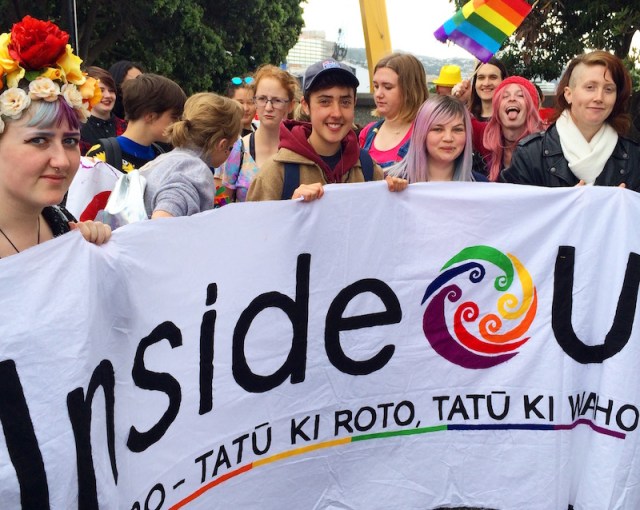
How do you approach time management?
Google Calendar is my saviour! I am one of those annoying people who is often late to meet you, will write her speech the night before, get the funding application in with minutes to spare. So time management probably isn’t my strength! But at the same time I am pretty good at remembering dates and having an awareness of when things need to be done by, so I think that’s still managing it? Generally things still get done on time and to a high standard I reckon! I also use to-do lists and when I start the day I try to go over that and prioritise what needs to be done that day before getting stuck into my inbox! The app Wunderlist is great for simple to-do lists and makes the most satisfying noise when you tick something off!
And what about work-life balance? Has your social or family life been impacted?
Work-life balance is such an ongoing lesson for me and many of us I think! Especially when you’re doing work that is personal, that you’re really passionate about, when it’s something you’ve created and you have a lot invested in. As a polyamorous person, a partner, a friend, a sister and an aunt sometimes it does feel really hard to make time for everything and you feel like you’re constantly apologising for being busy.
My job doesn’t have set hours — often I have to attend events or work in the evenings and weekends as well as during the day. A small thing I’m trying to do at the moment is to plan all my meetings for the week over a set couple of days, trying to make some time that’s free for social things or me-time. I’ve also started scheduling social hangouts into my calendar a lot more than I used to, to make sure they happen and that that time isn’t automatically taken up by work just because it’s ‘free’.
Let’s talk money for a moment. Can you tell us about your financial situation when you started out? Did you have start up costs and how did you handle this?
When InsideOUT started I was unemployed and had just moved to a new city. Initially we were umbrella-ed by another charity, the wonderful Intersex Trust Aotearoa New Zealand to apply for funding to run our first project (a youth hui). Later that year we became our own legal entity and managed to obtain a small grant and did some fundraisers to cover essential costs.
Everything we did was entirely voluntary for a long time. As time went on we had some more successful grants for projects where we were able to cover some volunteer expenses. Our first funding application for salary funding was turned down because we didn’t have reviewed accounts (though we’d barely had any money to review!), but when we tried again the following year we were successful. At the end of 2014 I was employed for 10 hours a week and then a year later we were able to double that.
Is InsideOUT financially sustainable now? How do you feel about the money side of ‘following your arrow’?
Currently I’m paid for 22 hours but am often working 40-60 hours. Luckily I’m a frugal person and I was able to save a bit from a previous job, so I can just about live off this. Over the last four years I’ve also done some contract work for an org called Wellington Rape Crisis, coordinating their fundraising street appeal, and other community jobs to help get by. Next year I’m going to be paid for full-time hours in my role for the first time and I’m feeling a bit scared by that and how it might feel to have my time valued and supported properly. How to feel okay about that when most people doing work in this area aren’t paid. How to be careful not to put too much weight on that, because the funding we’re getting is a one-off and there’s no guarantees how we’ll fund my position the following year. How being paid for the hours you work is just most people’s normal, but having always worked in the NFP sector, it feels uncomfortable. What responsibility comes with having money? How do I use it to take care of myself and the people and communities I care about? Lots of questions! I’m interested in the learning ahead around that.
In terms of sustainability for InsideOUT, that’s a really hard thing for a charity to attain, especially in the context we work within and when your primary income is grants which are never guaranteed. I hope that over the next year that we’ll be able to look at how we can gain more long-term sustainability and increase different income streams.
Where would you like to see yourself in five, ten years’ time?
I find it really hard to answer questions like this! I take quite a ‘go with the flow’ approach, I don’t have a plan beyond this. I think (hope!) I would still love to be doing work that I am passionate about, that makes a difference and combats some of the harm and inequalities in the world. I think as well as working in rainbow communities I’m curious about doing further work in the sexual violence sector and of course seeing where astrology takes me!
I often feel this tension between being in a role like I am currently that is hugely diverse in what I get to do, but at times can be heavily administrative/overseeing versus being in a more crisis support, youth work or counselling role where I could work more one-on-one and support people through change over time. That’s probably a reflection of my Taurus/Aries/Cancer challenges too!
How do you promote your organisation?
Things are slightly different for marketing in the charity world I think. We use social media a lot, in ways that appeal to both the young people we work with and those supporting them in various ways — parents, youth workers, teachers, etc. We speak at lots of conferences and events and try to educate people working in the mainstream youth sector about how they need to be caring and supporting LGBTQIA+ youth.
How does being LGBTQ impact on your organisation (if at all)?
Well evidently in my area of work it’s pretty obvious that I’m queer and it can often be useful to bring your personal experiences into your advocacy. I think an interesting thing about working for an LGBTQIA+ organisation is that your work can often out you before you choose to do that yourself! Sometimes that’s really useful, especially as a femme, but other times I will tip-toe around it for safety reasons when people ask what I do, and try to answer very vaguely.
What’s your hot tip for queer women who want to start their own organisation or business?
Give it a go, believe in your dreams, follow your passions and be persistent… find people who will support you — whether that’s practically with the business or just on a personal level. It’s so important to have other people on the journey with you, in one way or another.
Be patient — I know what it’s like to just want everything to magically fall into place overnight but that rarely happens. Work hard but don’t let it take over, take time for you and the people you love and make sure you don’t lose sight of why it is you’re doing this/the thing you’re passionate about.
twitter: @tabbybesley or @insideoutnz
instagram: @queerindigo or @insideoutaotearoa
Fool’s Journey: The Dark Days Tarot is Your Queer Lunar Oracle

Header by Rory Midhani
The Dark Days Tarot slipped almost unnoticed into my Twitter feed a few weeks back. At first, I paid it little attention, because when you make it your business to try and know about every new tarot deck that comes out, off, that fatigue can be very real. But. This was one of those magical decks that drew me back for another peek, over and over, until I was well and truly under its spell.
It’s overarching theme is the moon, its cycles and phases, it’s push and pull. These cards follow the up and down energy of the moon, growing bolder as it waxes, retreating introspectively as it wanes, and I love how you can feel this tidal effect as you move through the cards. Black and white, with small, square cards, the Dark Days Tarot is quiet, subtle, rather humble. It doesn’t force itself upon you like some decks do, or tell you what to make of it. Instead, it presents a set of mystical yet somehow familiar-feeling scenes, blurring the lines between everyday life and fantasy and creating a world I’d really love to visit.
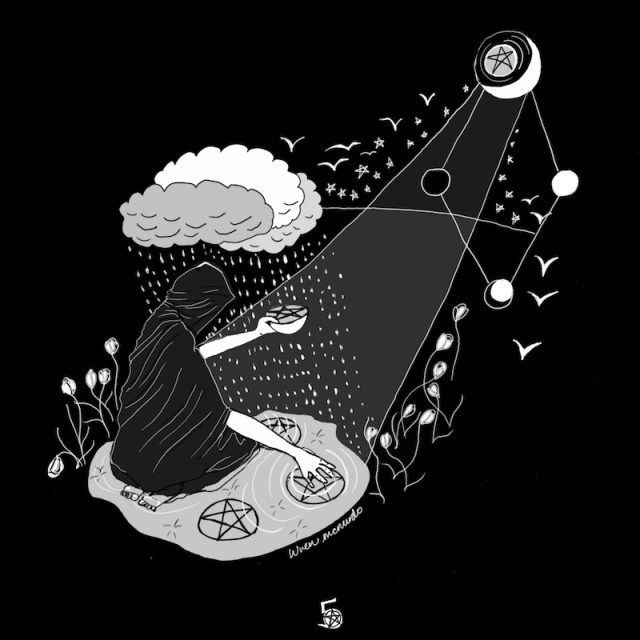
Of course, I’m saying all of this without having yet physically encountered the Dark Days Tarot — it’s currently fundraising on Kickstarter (and it’s so close to its goal, if you like it, go push it to the top!) In anticipation of the real thing, I got in touch with Wren to chat about about the lunar influences behind this deck, and how she feels it reflects her queerness.
A quick note: at the start of this interview Wren speaks candidly about the relationship between her own menstrual cycle and the moon, and the impact this relationship has had on her understanding of cycles in life, and the creation of this deck. Personally, having spent some time gazing at these images, and as a person who has some pretty strong feelings about the association of menstruation, lunar cycles and ‘witchy/womanliness’, I don’t feel that having periods is in any way a prerequisite for enjoying or working with this deck.
Hi Wren! The Dark Days Tarot is just beautiful — I’m excited for its publication! Can you tell us a little about the ideas behind the deck, what has guided you in creating these images and interpretations?
Hi Beth! This deck was inspired, like a lot of things in my life, by premenstrual musings. In my late teens I was bludgeoned to discover that periods have historically followed the moon’s rhythm and that due to modern lifestyle, we no longer typically do. I was also completely stymied to learn that premenstrual “syndrome” is linked to the dark moon days of the lunar cycle, and can evoke the expression of our greatest desires, reflectively. When a person is upset or angry while premenstrual, it is cause to listen, because that is literally their body telling the world what that person truly needs in their life. This cycle exists in all beings. This deck is named Dark Days after lunar connection, and the inherent communication in darkness.
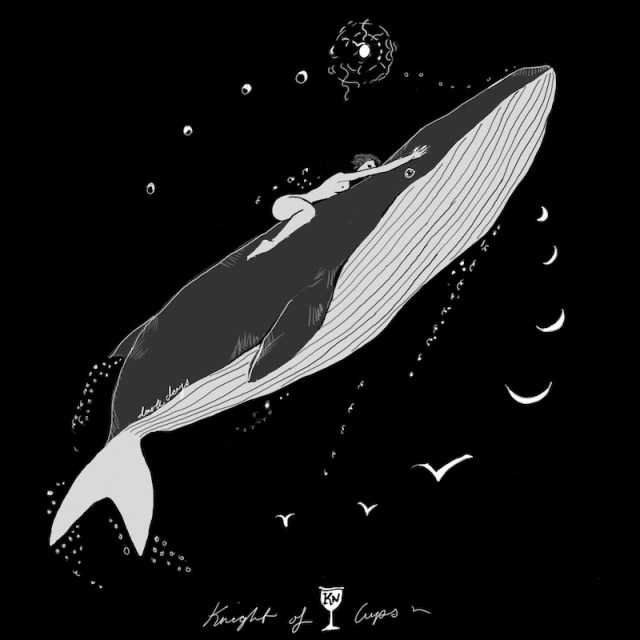
To me, the deck feels hella-queer. Maybe that’s the awesome haircuts and the way the characters in this deck seem to exude that kind of confidence that comes from being truly comfortable on the margins, or maybe it’s something else that you’ve imbued in these drawings. What do you think? Have you consciously conveyed your own queerness in these cards?
I have definitely consciously included some queer vibes while creating these cards. Being queer is a part of everything I do. I can’t help it. My fiancée, Schquay is my ultimate muse, and she is very androgynous. Her gorgeous features and style appear in a lot of my drawings. I’m surrounded by awesome queers in my daily life, so of course they appear as characters in my artwork. Who wouldn’t be inspired by a bunch of bad-asses who live their truth? I consider queerness to be a genre of love and enlightenment superpowers. The world desperately needs us to take that kind of responsibility.
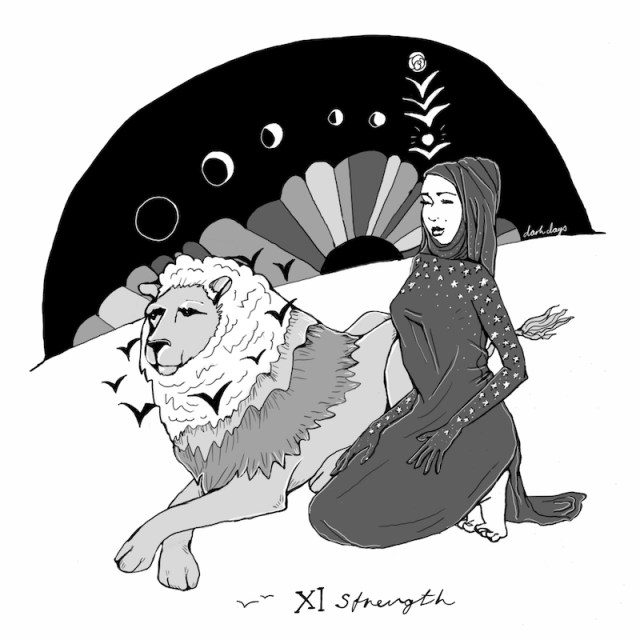
Can you tell us a little more about the role of the moon in this deck?
The moon is my other muse and ruler. I love her many faces. I love being her daughter, her sister, her boyfriend, her girlfriend, her theyfriend, her lover, her handmaiden, her houseboy — you name it and I’ve dreamed such things. I’m a Cancer, so I love to be alone with her. She is my maker. I’m a fool-in-love of an explorer charting my connection and devotion to the universe via her guidance. I pulled and illustrated one new card every quarter moon phase, to learn the cards and develop this deck, and also to be intentionally in harmony with her. I am in step with the moon via this practice of working with cards.

I love the square card shapes — their symmetry, strength and uniformity are deeply satisfying to me! I love that these cards can be read upright and reversed, but also in two other positions. Can you tell us a little about that?
I chose square because I wanted to the cards to have four directions. In my study as a solitary witch, I’ve found sets of four to be repeatedly relevant: the four directions, four moon phases, four seasons, etc. I wanted Dark Days Tarot to have this same kind of mechanism. As is explained in the guidebook that comes with the deck, a card facing right is “progressing” and facing left is “regressing.” The card’s clockwise motion mirrors progress of character. The cards can also be laid out in accordance with the seasons or lunar cycle. For example facing left is first quarter or spring, upright is the full moon or summer, right is last quarter or fall, and reversed is the new moon or winter. My intention is that this deck may open up a whole new level of intuition, and aid any reading to feel more fluid and moving, just as our fate may be.
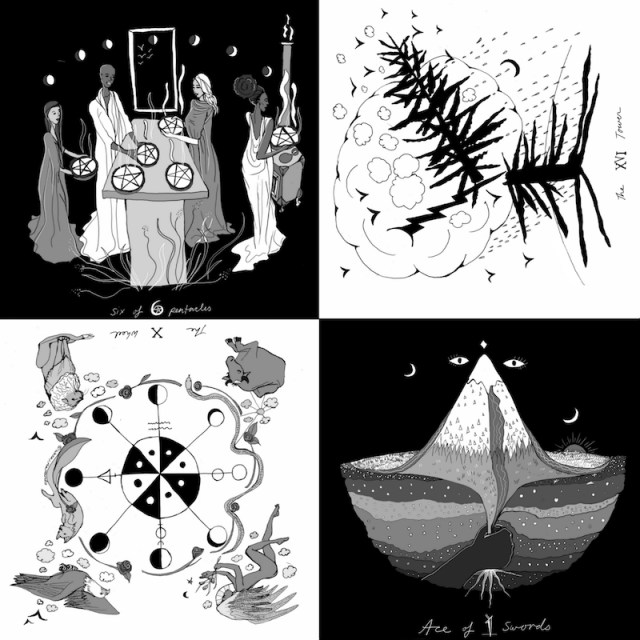
How about your own personal journey with tarot?
My favorite deck is the Osho Zen Tarot deck. It was my first learning deck. Osho always leads the reader back to Zen, which is nice, because sometimes I need a safe space to go to when I read Tarot. Each card feels like a tiny universe that I could stare at forever. It helped me to see the creative potential in creating my own deck. I also love the Dark Grimoire Tarot — that deck is super spooky and the drawings are wild. My first deck was a miniature tarot deck in my Christmas stocking years back, given to me by my Pops. It’s the deck I pulled from to dictate the progression of the Dark Days deck.
My practice is pulling a daily card or a three card cut, usually before bed or when I’m doing my makeup. I like to keep my cards near mirrors, because they are my little psyche mirrors. I also love to do longer readings with family and friends. I’m interested in reading professionally.
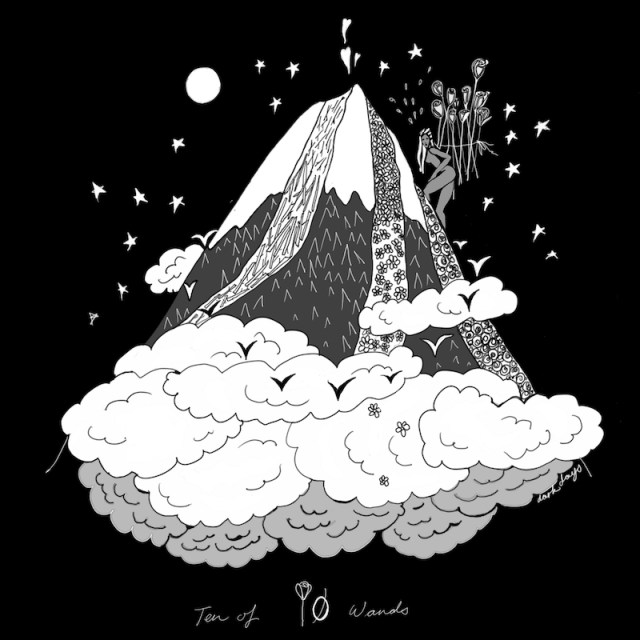
Do you have a favourite card in this deck? If so, can you tell us about it?
The Lovers – VI card (below) stands out to me. I felt the most amazing sense of expression while illustrating this card. I imagined the sky opening up and seeing a writhing pair of bodies bursting with loving celestial explosion. No heads, just extensions of their bodies, muscled and emotional — hence the mermaid tails. A garden of flowers grows from their lovemaking. The stark white background against their night sky bodies is alluring and spellbinding. This card communicates a revelation in love.
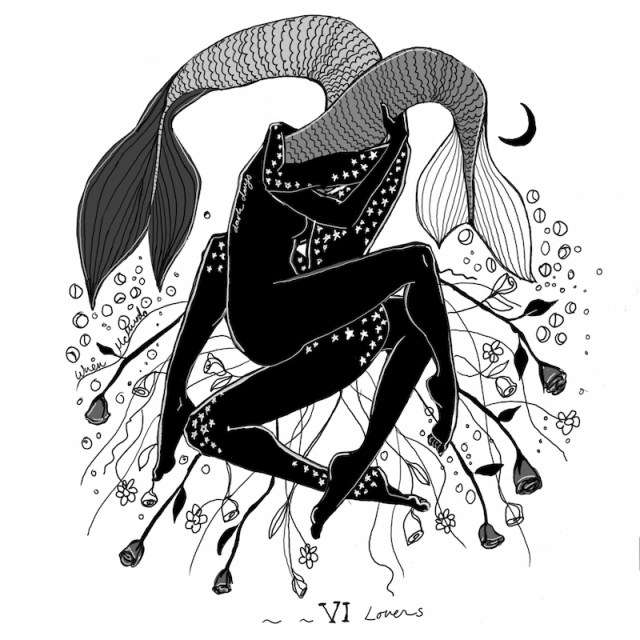
What are your hopes and dreams for the Dark Days Tarot?
I see an opportunity for armor and enlightenment, and I imagine this deck in the proverbial tool belt of all of the superhero bad-ass babes, queers, and witches. Considering the current state of things, now is not the time to be complacent. Tarot can lay a path to success and warn of self-defeat in times of deep confusion. I also plan to donate a percentage of sales of this first printed edition to Black Lives Matter, Planned Parenthood, and/or the ACLU.
I also see this deck as an opportunity for connection. I love looking at the moon, the celeb in the sky we all crush on, knowing that a bunch of other people and animals and plants are gazing up at her, too. That we all sway with her pushing and pulling. My intention is that this deck may evoke a spirit of connectedness in all who explore its depths.
You can follow the creation of the Dark Days Tarot via Wren’s Instagram or on Facebook, and of course, you can check it out – and add your support – on Kickstarter!
Fool’s Journey: A Tarot Spread For The Revolution

Header by Rory Midhani
Like many people, over the past week I have found myself wondering many things. Things like, how can I step up and serve my community? What is my role in the revolution? What skills can I offer to the world right now? Where should I focus my energy when to be honest everything feels just completely fucked? In times like this, I find tarot is an amazing way to kick-start my explorations and my mind-mapping so I can find ways to make myself useful.
I truly believe that tarot is a valid tool for the revolution. This is partly because I believe self-awareness, self-love and self-care are revolutionary, and tarot is one of many rad tools that enables us to achieve — or at least work towards — these things. I also believe that tarot can encourage us to face up to messages we find hard to hear. It can point out ways we are fooling ourselves and call bullshit on our masks. It can show us skills and qualities we might be too afraid to accept, and point to situations where we are needed.
Last Thursday, I offered free, short tarot readings for folks who were deeply affected by the US election result and who needed words of encouragement and hope. These were not cards of the ‘canned hope’ variety with sweet slushy reminders that you’re awesome and everything is gonna be okay. No, that would be too easy for the tarot. We got cards about facing up to truths and walking away from mainstreamed lies. If you need that kind of message yourself, I shared some of the most common cards on my blog.
Taking this further, this week I put together a tarot spread to help me figure out how I — or you — could ‘be the change’. Though I don’t live in the US, Trump’s election (along with Brexit and the UK re-election of the Conservatives a couple of years ago) has been a wake-up call in terms of realising that I need to be doing more to fight the right wing. Tarot cards are one of a whole range of tools we can use to explore this.
This tarot spread looks not only at practical skills, roles, and ways to help out, but also prompts self-enquiry. The fight for social justice begins within ourselves, with deep questioning. These cards want to look at your fears as well as your resources, your complicity as well as your ideals.
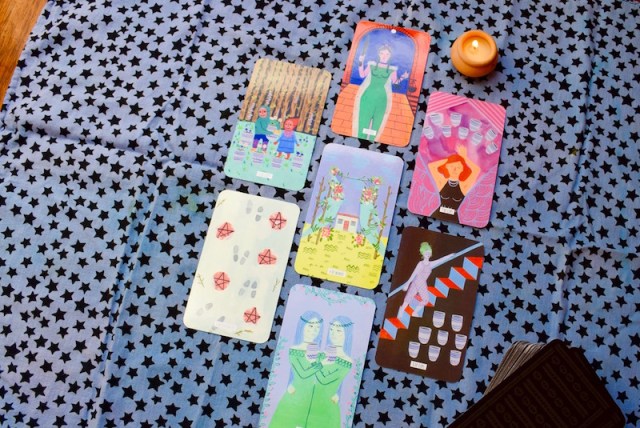
We begin with hope, of course. The first card, which represents a goal, an ideal, is chosen consciously. Begin by working through your cards and find one that seems to answer this question best:
1. What does a beautiful society look like to me?
Then shuffle and lay the following cards as normal, or alternatively, continue to choose the cards consciously — whichever feels better for you. Lay the cards in a circle around the first.
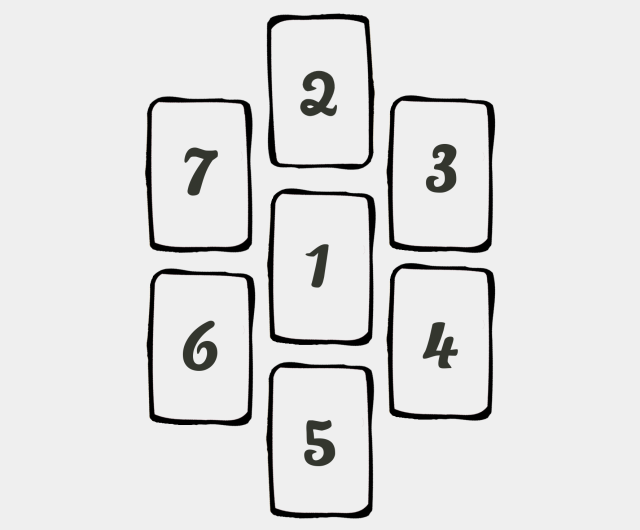
2. What am I most afraid of right now? This card probes at the stuff we’re usually too afraid to talk about when we’re discussing social justice. I chose Justice to represent my fears, because for me this card shows me the inescapability of cause and effect, which is intimately tied to my inaction and my willingness to live in a middle-class white girl bubble.
3. In what ways am I complicit in injustice? Nobody exists in a vacuum; our actions and, crucially, our inactions affect others.
4. How can I approach my fear/complicity? This card is about being willing to challenge yourself. How can you call yourself out in a compassionate and productive way? How can you turn things around?
5. What practical skills or resources do I have available right now?
6. How can I take care of my community?
7. How can I take care of myself? Don’t you ever forget self-care, you guys!
I chose my cards consciously — for me that feels more appropriate for a spread like this. I won’t go into detail about my own reading, but these cards and questions for me touched on topics of collective hard work (Four of Wands) and breaking out of my comfortable bubble (Nine and then Eight of Cups), creating safe spaces by demonstrating my own vulnerability and holding space of others’ (Two of Cups and Five of Pentacles), and remembering to reach out, that I want my life to be a partnership, governed by kindness (Six of Cups).
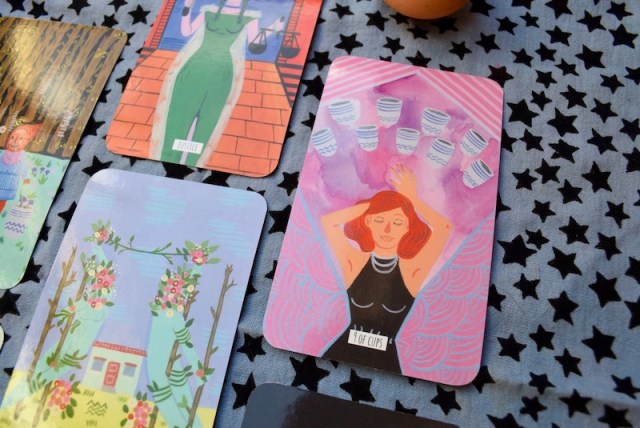
Also: If this kind of tarot practice interests you, you might also want to check out Siobhan Rene’s 7 Questions for Earnest Allies. Siobhan is posing important questions aimed at white folks who are serious about allyship with people of colour, and they probe into subtler shadows of racism. You can work though these questions ‘straight’, or use them as a tarot spread, as I did.
50 Blogs and Books and Podcasts That Inspire Queer Entrepreneurs
Feature image via Molly Adams
One of the things I love the most about being a solo entrepreneur is mining the internet for glittering gems of business advice. With more and more people — women especially — quitting their jobs and setting up shop on their own, there is a growing and diversifying range of blogs, podcasts, books and courses out there, which promise to inspire you, focus you, stop you procrastinating (is that really possible?) and provide practical advice for those new to business or struggling with specific blocks.
Of course, the solopreneur web is as much a time-sucking vortex as any other online space, so I’ve pulled together some of my favourite sources of business advice, along with the recommendations of some of the many awesome folks I’ve interviewed for this column. Enjoy!
Riese’s column, This Business of Art, is always a mine of useful information for folks who make a living being creative online.
Alexandra Franzen’s blog functions as a heartfelt and practical guide to keeping the heart and soul in my business and especially in my writing. (Happily, I got to interview Alex for this very column – you can check out her own recommendations below!)
XO Sarah is an invaluable source of information if blogging is a key part of your business. Sarah has spent years figuring out how a business blog works, and she shares a continual stream of no-nonsense, practical advice covering topics like finding blogging inspiration, leveraging social media platforms, building an email list and so on. There are a lot of people out there promising the same thing (all with matching shiny, coral-and-gold websites, Mac keyboards and manicured nails) but for me, Sarah Morgan’s blog is the most useful and comprehensive. I also like Sarah Von Bargen (she’s hilarious), Hiro Boga, and Maya Elouis.
I loved Seth Godin’s book,What to Do When it’s Your Turn (And it’s Always Your Turn). It’s presented in a magazine-style and it is punchy and inspiring, leaving you with nowhere to turn except to show up and do your work..whatever that may be.
A few folks below have recommended Tim Ferris’ ubiquitous The Four-Hour Workweek. Though I get why this book inspires many solopreneurs, I’m not the book’s biggest fan.
Most of all, though, I’m inspired by other entrepreneurs, especially women and most especially queer women. I use Feedly to pull all of my favourite blogs through into one place and dip in on a daily basis to see what people have to share. Watching my awesome friends and colleagues in the queer business community sharing their journeys, their ideas, and their offerings with the world keeps me going and reminds me that I’m not alone, that I can do this, that it’s worth the blood, the sweat, and the tears.
Here are the favourite books, blogs and podcasts of some of our Follow Your Arrow interviewees!
Emilie Wapnick, founder of Puttylike.com
The Art of Asking by Amanda Palmer
The Four-Hour Workweek by Tim Ferriss
The War of Art by Steven Pressfield
Alexandra Franzen, writer
I love the book Die Empty by Todd Henry. I talk about it obsessively and recommend it to anyone. It will light a fire in your heart. I won’t reveal any more. Just read it.
I always feel inspired by my friend and client Melissa Cassera. She’s a former publicist who now works as a small business strategist and she’s pursuing a career in Hollywood as a TV writer. I love how she’s balancing her business, her personal life, and her passion projects, all so gracefully! She’s brilliant and hysterically funny.
I highly recommend listening to RuPaul being interviewed by podcaster Marc Maron. It is insightful and full of fascinating advice on how to live a courageous, creative life. The episode is not free (you have to buy it) but it’s well worth the investment.
Lizzy Goddard, virtual assistant
Marie Forleo is basically the queen of the online business world I live in. Every Tuesday she publishes an episode of MarieTV, full of fantastic business advice on pretty much every topic/issue imaginable. She also runs B-School, an 8 week comprehensive online business course.
Rebecca Tracey of The Uncaged Life is a no-nonsense business coach, helping people particularly in the startup/foundation laying stage of their business. I took her signature month long group programme (Uncage Your Business) early on in my entrepreneurial journey and it changed everything for me in terms of the clarity and direction I got out of it.
Denise Duffield-Thomas of Lucky Bitch is a money mindset coach. I know that sounds totally weird and irrelevant, but sorting out my mindset towards money has been absolutely essential in growing a successful business. She’s got loads of free content on her website to get you started with this side of things, plus a full course which is hands down my favourite online community of fabulous business women.
Tieara Myers, spiritual coach
I do not have much time to read lately, only the occasional article, but I do enjoy listening to podcasts and streams!
The School of Self-Mastery Podcast on business, money, and life.
Entrepreneur on Fire Podcast a podcast featuring entrepreneurs from all fields.
Abraham Hicks talking about alignment, spirituality, and the law of attraction.
Tara Brown, coffee roaster
I really like Riese’s This Business of Art column. I look up to the Autostraddle editorial team a lot.
I’ve also been able to learn from some of the best people in specialty coffee, especially the guys at the Juan Ana Coffee Program and the fantastic team at Sustainable Harvest.
Sarah Gottesdiener, designer
The writer and teacher Esme Wang is amazing, she offers advice for those ambitious souls who have chronic, debilitating illnesses. Before her, I hadn’t really found a creative who so bravely discussed creating through limitations. Its been heartening to read her journals and be reminded I’m not alone in my struggles with chronic illness.
Paul Jarvis has good topics and helpful tips. I appreciate his transparency about his business, his process, and his habits.
Barbara Jones, eco builder
Martin Brown is a very dedicated environmentalist and thinker who is bringing the Living Building Challenge into the UK, doing more good instead of less bad.
This Changes Everything by Naomi Klein
The John Lewis Partnership is a superb example of the way I’d like to do business. A successful company with cooperative and egalitarian principles that has survived the cut-throat market for decades and is still going strong, powered by its workforce.
Sean Desiree, musician
I read the blog posts that Sonicbids puts out that give tips to musicians and I find it helpful.
I read the bios of artists I appreciate to learn how they established a successful music career.
I constantly bug my partner for advice on flyers, music and everything really. Because it’s a solo project I don’t have anyone to bounce ideas off of most of the time. For that I am really grateful she tolerates my questions and is honest in her critique.
Elizabeth Cooper, body-love coach
The Body is Not an Apology is an amazing movement and incredibly rich website about body-based intersectional liberation on both the personal and collective level that inspires me in terms of the content of the work I do.
Many Buddhist and meditation books really inspire my work. One in particular that I read recently that felt like a guide to how I want to approach my life and business: Loving Kindness by Sharon Salzberg.
In terms of business strategy, I’ve been getting a lot of nourishment recently from a Facebook group, “How To Sell to Women Without Selling Them Out,” moderated by Kelly Diehls, which supports entrepreneurs who seek to not replicate systems of oppression in business. I’ve been seeking to do business in a way that is actually feminist and empowering, and while I’ve only just found this group, it feels like a glimmer that it’s possible.
Nathalie Huerta, gym owner
I always go back to re-read The 4 Hour Work Week by Tim Ferris when I’m feeling a burnout coming on.
The Law of Attraction keeps me positive when I’m feeling down or defeated.
My twin sisters, they’re down to roll up their sleeves and help me with anything. Same for my girl, she’s a rider!
Rebekah Erev, artist and priestess
Queer small business owners have also been a huge inspiration. Like everything in my life, the people I actually know and have relationships with are my biggest influence. Nicolas Weinstein of Homestead Apothecary has been an awesome support person for my business. I love his ethics around community and business.
I also have been hugely inspired by Jen Lorang of Alchemilla. Along with a handful of other queers here in the bay area, she started a craft fair called Magic Makers. I sold my stuff there this year and it was completely wonderful to fill an old grange hall with queers selling locally made beauty to other queers.
Chella Quint, #periodpositive activist
I love Tina Roth Eisenberg’s Swiss Miss blog , and her projects Teux Deux (as above), Tattly, and Creative Mornings. Her aesthetic and her work ethic really resonate with what I like, how I am and how I’d like to be.
Pace Smith, pathfinder and coach
Heart of Business taught me everything I know about doing business in a heart-centered way.
Finding Your Own North Star by Martha Beck is a great book about following your heart. It’s the best book on Pathfinding I know of until I write my own.
Big Magic by Elizabeth Gilbert is about fanning the flames of your creative spirit, and about what to watch out for when trying to make a living from creative work.
Jane Bradley, founder of For Books’ Sake
The Aspire Foundation have a free mentorship scheme for women, along with events aimed at developing women’s leadership skills.
Ogunte do brilliant work supporting women starting social enterprises, and have loads of useful advice and resources, as well as an incredible, worldwide community of women leading all sorts of exciting projects.
I also love Michelle Tea’s latest book, How to Grow Up. It’s not strictly about business, but you get the picture of how she developed her non-profit RADAR and the world-renowned touring Sister Spit roadshow, as well as loads of other insights around what it means to be weird, working-class and queer, and all the associated baggage that might involve.
Hattie Hasan, plumber
The Joy of Plumbing, a Guide to Having The Life You Really, Really Want by Hattie Hasan.
Become a Key Person of Influence by Daniel Priestley, on branding and becoming key in your own industry
Lynn Serafinn on blogging, Twitter and use of Social media for ethical (and effective) business marketing.
Jeanna Kadlec, founder of Bluestockings Boutique
For entrepreneurs and creatives, I cannot recommend Skillshare highly enough. So fucking helpful. Skillshare classes have helped me avoid so many headaches.
Similarly: Periscope. Seriously, y’all, Periscope is like live TV for folks hustling their asses off. So many awesome Millennial entrepreneurs talking about how to hustle and giving solid, half hour talks for free that you can learn from. Also, some industries are very into Periscope so it’s a great place to network (for example: spiritual entrepreneurs, which is my other business).
Specifically, one person I’d send folks to right now, immediately, is Regina Anaejionu of byRegina. Her work is geared to the online infopreneur business, but it is 100% relevant and helpful for anyone starting a business that will have an online presence. She also has a ton of really affordable resources available in her store (I’m talking $3 and $9 e-books and workbooks on branding and social media). Plus, she focuses on self-paced e-courses, so you don’t have to worry about her saying that you can only get X advice if you pay four figures for a coaching package.
Caroline Elenowitz, fashion designer
Business of Fashion is good for fashion stuff— their roundups on other articles on the fashion business are also excellent.
Fashion is Spinach by Elizabeth Hawes was a very interesting read with surprising insight into the challenges of the fashion business even though it was published in 1938.
Inc Magazine also sometimes has some good general business tips.
Brittani Nichols, screenwriter and performer
I don’t have anything specific but I think everyone should have a book for their heart, a game for their mind, and an activity for their body.
Over to you guys! What blogs, books, podcasts and courses do you recommend? Add your hot tips in the comments!
Fool’s Journey: How to Get the Most from a Tarot Reading

Header by Rory Midhani
You’ve heard the saying ‘ask a silly question, you’ll get a silly answer’? So it is with tarot. Asking the right question, or rather, figuring out your intentions before you approach those cards, can really make the difference when it comes to the quality of your reading.
As someone who reads tarot for a living, I’ve gotten used to returning the occasional reading request, asking the querent if they would mind rephrasing. I don’t do this to be awkward or annoying, but because I want to give them the best possible reading, and the quality of the reading begins with the phrasing of the question being asked and the place where this question is coming from. A combination of both the angle and wording of the question, and the intention behind it, are key to receiving tarot readings that are empowering, informative and truly helpful.
Here are a few things to bear in mind when you’re preparing for your next reading.
1. You don’t actually have to have a question
Sometimes you just don’t know what to ask, and that’s totally okay. When reading for myself, sometimes I have a specific question, and sometimes I don’t. When I don’t, it’s usually that I’m looking for a sign, a clue, a word of encouragement or perhaps a warning when I’m too scared to give one to myself. Sometimes it’s more that I know what I want to ask, but I’m afraid of voicing it. That’s okay too: the cards can work with that fear and still provide the answers I need. Usually in these times, I find that the act of bringing this issue silently to my cards provides the encouragement I need to finally address it.
2. Yes/no questions don’t usually lead to simple answers
Let’s say you’re sick of your boss and you’re wondering if it’s time to quit your job and start that business you’ve always dreamed of. You could ask a straightforward ‘should I quit?’, but that’s likely to lead to a convoluted answer. Rather than telling you ‘yes you should totally leave your job’, the cards will want to help you unpick the whys and wherefores of your work situation and present you with the info you need to make your own decision.
Tarot is a great way to get a yes/no answer — if you’re prepared to go all around the houses to get there and then, ultimately, to decide yes or no for yourself. I’ve never known a genuine tarot reading take away a querent’s decision-making power. The cards might tell you that it’s time to start that cake-making business, but that you’re gonna need some savings in the bank in order to do that, so it’s up to you if you feel you have the resources or you want to stay and build up a safety net. Or they might discuss your toxic boss and show you how she is grinding you down, presenting you with the option of confronting her or walking away. The yes or the no is always going to end up coming from you in the end.
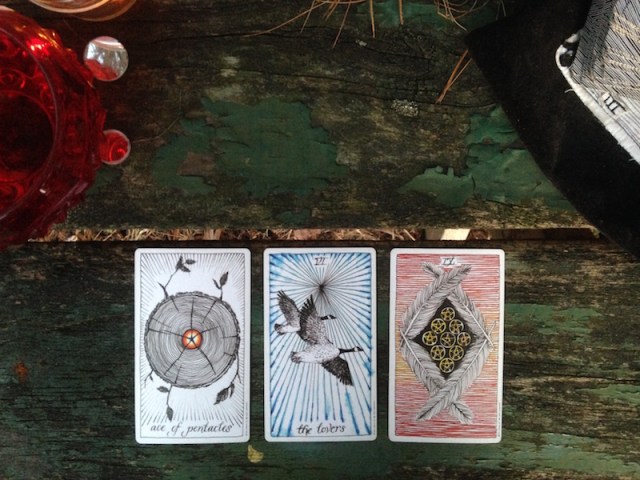
3. Tarot is all about you
If you want to ask a question about someone else’s feelings, go ahead and ask them, but I’d strongly advise that you keep it away from the cards. As far as I’m concerned, that’s just not what tarot is for. And readers who answer the ‘does she love me?’ types of questions are, in my opinion, reading unethically. Tarot is a tool for self empowerment, not for noseying into other people’s hearts and minds.
Example: Instead of asking ‘Does she love me?’ try asking ‘What can I do to improve this relationship?’
An exception would be when two or more people get a joint reading. Relationship readings are fun! Just make sure everyone is consenting to the reading before you start delving into other peoples’ thoughts and feelings.
4. Take responsibility and ask a positive question
Asking a positive question— and by this I mean the ‘What can I do?’ type of question — is deeply empowering and ensures that you end up with a proactive answer. Take responsibility for yourself! Make it clear that you intend to do something with the information you get from the cards, rather than being passive and/or expecting other people or things to change without you. If you’re serious about finding real answers, you’ll get a much better response from the cards if you’re putting a positive ‘can do’ kinda energy into your reading and telling the cards and the reader that you’re up it.
Example: Try ‘How can do to move [XYZ situation] forward?’ or ‘What are my possible options right now?’ If you’re really feeling stuck, you could try ‘What would it look like if I had/did XYZ?’
5. Be intentional
By ‘intentional’, I mean understanding the place where your request is coming from; the attitude with which you approach your cards. Following on from the above point, intentionality is to me the most import element of any tarot reading, whether you’re doing it for yourself or have a friend or stranger reading your cards.
Like spellwork, prayer, meditation or any other spiritual practice, what you put in and how you come to the tarot is going to define what you come away with. Are you consulting the cards in order to avoid the answer that’s staring you in the face (perhaps hoping the cards will tell you something different)? Are you getting yet another reading in lieu of taking the sound actions suggested by the last reading (or the one before that)? Tarot has an uncanny way of calling you out no matter what tale you’re spinning, but being honest about your needs, your feelings and your intentions before the reading really sets a tone for truth and heartfelt, empowering advice you can really use.
Try to set an intention before you begin. Even if you don’t have a specific question, be clear on what you want to get out of the reading. This might be ‘I want to get out of this rut and move forward’ or ‘I want to be honest about my feelings for XYZ’. Setting your intention can be incorporated into a simple ritual if you’re reading for yourself, by taking a moment to pause and speak it aloud before you begin. If you’re getting a reading from someone else, you could perhaps tell them your intention, affirm it before entering the room, or speak it before hitting ‘send’ on the email.

6. Be honest, and don’t dumb down your question
Meaning don’t cover up what you really want to ask with what you think you should ask, or what is ‘safe’ to ask. Tarot is about confronting stuff, and sometimes this is uncomfortable or difficult. If you want to know how to deal with your drinking problem, for example, say so; don’t make it wishy-washy and dance around the issue.
Example: Instead of ‘Umm…someone said I drink too much, but I don’t think I do. Do you think they’re right?’ ask ‘What do I need to know about my drinking?’
This is not to contradict my first point about not having a question. As I said, it may be that you’re truly not ready to voice this issue yet. As much as possible, tune in to your intuition here. You probably do know deep down what it is you’re asking about. Ask silently, ask obscurely, let the issue be present rather than suppressed as you shuffle your cards or request your reading.
7. Less is more
Obscure questions usually (though not always!) get obscure answers. If possible, be concise. You can provide as much or as little background info as you like, but sum it up succinctly with one simple question so that the cards and/or the reader know what they’re actually looking for and can bring you the answers you’re really seeking.
Example: You’ve talked all around your break-up, given the reader lots of details about who said what and how it’s hurting you. Sum up by asking ‘What can I do to move on?’ or ‘What do I need to know right now?’
Essentially, all of these tips are encouraging you to be responsible and intentional with your reading. You may not know exactly what your question is. You may not know how to boil down your situation into a specific request. What’s important is that you’re approaching your cards with a genuine desire to learn and grow. To my mind, that’s how the whole thing works.
Follow Your Arrow: Designer Sarah Gottesdiener On Creating Feminist Propaganda
Can you make a living as an artist? Sarah Faith Gottesdiener is determined to find out. A lifelong creative and the person behind feminist apparel brand Modern Women, Sarah decided a few years ago that her artistic talents were put to better use making functional, saleable items that challenge the patriarchal paradigm on the street, than hanging in galleries. Four years back she became fully self-employed, and she now earns a sustainable living via several different streams: freelance design work, writing, her online store, and by offering tarot readings and workshops…yet as she says, she looks forward to the days she will be able to paint and create art freely once again, a dilemma I think many creative freelancers face.
In this frank and insightful interview, Sarah explains the ideological motivations that lie behind her work, and discusses the huge leap of faith and perspective that it takes to begin working for yourself, with all of the financial risks involved. She tells us about her personal goals, her philosophy around staying small despite the pressures of capitalism, and how ‘work-life balance’ is pretty much a unicorn. She also shares with us some of the biggest challenges she faces both as an artist and a person with a chronic illness. As a fellow creative entrepreneur, I found Sarah’s story to be motivating, inspiring and encouraging. I hope you will too.
Sarah Faith Gottesdiener, freelance designer, artist, writer, and Tarot reader
Los Angeles, CA

Photo by Nancy Neil Photography
Hi Sarah! Can you introduce your business in a paragraph? What’s your mission? Who do you serve?
Hi! I’m a solo freelancer. I started out as a freelancer designer and adjunct professor four years ago, determined to make a living on my own. After two years teaching at three different colleges I quit, as I was barely making ends meet teaching at very expensive universities for pennies. My focus became one part working for others, one part working for myself. For all of my entire twenties I had various amazing and not so amazing roles in the creative industry, but always fantasized about working for myself. Now my old fantasy has become my current reality, and is both incredibly dreamy at times and way more challenging than working for others ever was!
My apparel serves awesome people fed up with the dominant patriarchal paradigm. I offer products that strive to act as feminist propaganda, as a reality disruption. They also serve as identity markers to those wearing them, it ends up being a common story people tell. Others stop them and say “I love your top!” A friend wearing a top of mine texted me the other day thanking me as when she wears the shirt she gets less street harassment. Small victories!
My mission with my spiritual work is to empower others, to inspire people to live deeply, take risks, and transform in the spirit of service to one’s higher path. I offer different tools in that realm: my intuitive Tarot readings, my Many Moons Workbook, Tarot and manifesting workshops, and blog posts. As investing in my own spiritual life and practices have helped me overcome trauma, anxiety, depression, self-destructive behaviors, I feel the drive to help others, particularly those who are queer, femme, women-identified, trans or gender-nonconforming. I believe that when you help others, you help yourself. When you live your life in an authentic fashion, you inspire others as well.
How would you describe your approach to business? What personal qualities inform your approach?
I’m an artist who got an MFA in design. I decided to become a designer so I could make money. As someone who has worked since I was 13 and must support myself, I often feel like I don’t have the luxury to be an artist, even though I can’t wait to introduce painting back into my life. I have never taken a business class in my life. Math gives me hives. My goals have always been small: make x amount an hour, then x amount a month. To pay my gargantuan monthly student loan debt by selling weird feminist gear? It seemed like an awesome joke on the universe.
Having exceeded all my old goals and manifestations, I’m currently in a stage of figuring out what my next steps are. It involves giving myself the time and space to recalibrate and reconfigure. I don’t have a map, there aren’t a lot of trustworthy people in my life I can talk to about business, so things always feel a bit unnatural.
Working in very competitive, prominent, fast-paced offices and agencies in my twenties offered the incredible opportunity to see how ‘successful’ and ‘ambitious’ people operate. This was invaluable: what I learned about time-management, project management, communicating with clients all stems from that almost decade of working internally for companies. I have a very professional manner when working with clients. My role, the quality, and deadlines are taken very seriously. I never forget – whether I’m designing a logo, mailing out a T-shirt, or giving a Tarot reading – that wonderful people trust me with something precious.

Some of Sarah’s personal design work
What does a typical day look like for you? Do you have a routine?
I wish I had a typical day! In general, my weeks work around my clients’ needs and on various deadlines. For example, today I designed client work in the morning from home for a few hours, then spent about fur hours mailing out orders, then finished out the day with a client call/brief for another project.
I’m trying to get better at setting boundaries with myself and my work, as well as batching days, for example, having just one day be for writing, one day for designing. Obviously life doesn’t always work like that, but it is something to strive for. It is one of my current goals.
What kind of things do you actually do?
Here’s a probably-impartial list of my tasks: I design for all types of clients (mostly in beauty, lifestyle, and fashion/apparel sectors), I project-manage, do concepting and research as well, create invoices (do my own accounting/billing – FUN), I design things for my own products (mostly posters, tees, and totes), I write both for my books and my own blog. I create content for my site and my Instagram account. I market, process, and ship out all orders for my online shop and work with other stores that my goods wholesale at, I read Tarot cards for clients, and I design, conceptualize, and teach original content for workshops on spiritual/metaphysical topics, such as working with the cycles of the Moon, and all sorts of Tarot topics. And, of course, I spend way too much time emailing!
How many hours a week do you spend working on your business?
An average week is between 35 and 70 hours of work. Sometimes I work six days a week, sometimes less. This is not counting all the time I am talking and thinking about my various projects.
What is your workspace like?
I work from home in my kitchen most of the time, and spend a couple days a week in a studio. I’ll be moving everything to my studio soon. I’ve been reticent to leave my elderly dog and access to food anytime I want: I’m snacking all the time! Also I like to take breaks and walk my dog. I rent space out of the Women’s Center for Creative Work, that’s where I keep my products and do my shipping.
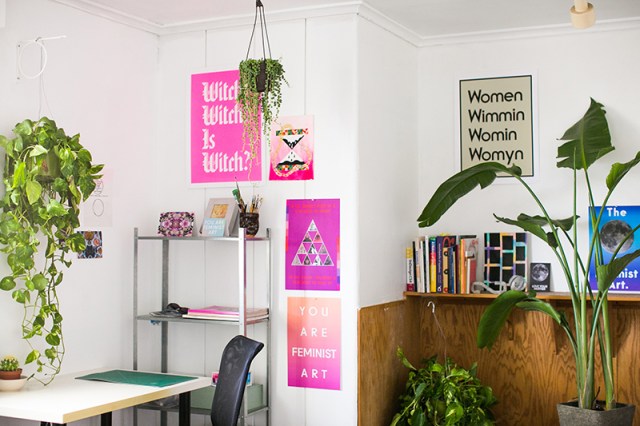
Sarah’s studio
When did you know that this was what you wanted to do? And what were your early goals, your first steps?
After working in the creative industry as a project manager and art-director and seeing what designers made and did, I figured out that’s what I wanted to do. (This was on top of working 40 hours a week, then going home and making art until midnight, and being in various bands, sometimes DJing, yet making barely anything off of my creative pursuits.)
My answer was to take out a huge amount of debt and get an MFA in design at a fancy, yet completely nightmarish graduate program. After graduating I decided to dive right in and instead of getting a ‘job’ as before, to start trying to get my own clients. A big dream was teaching; that was where the MFA came in. (I had a childhood dream of being a college professor, teaching students about art and design.) I taught for two years before realizing it was most likely not going to go anywhere.
It was hard to quit teaching, as I truly love it and am a very good professor, but it didn’t make dollars or sense. Teaching three-four classes at three different colleges only just covered my basic expenses, so I had to freelance on top of it to be able to save anything, or pay for a pet surgery or car emergency. All aspects of my health were suffering from this, so I quit teaching at the college level and focused more on working for clients and myself. Teaching workshops gives me the same kind of joy as being a professor did, so I try to teach those frequently.
I’ve always been attracted to the sort of blue-collar, functional aspect to design. Multiples are inexpensive (as compared to say, a painting) and as design is work out in the world, it can make much more of an impact than work in a gallery, only seen potentially by a few privileged folks. There’s a specific sort of pride I get when I see my work in the world, even if it’s not exactly the most chic. A shampoo bottle I designed years ago was randomly in a friend’s bathroom, and I got all excited like the nerd I am!
Ideally I’d be an artist just doing what I like some of the time, and some of the time taking on dreamy design clients that are a good fit. I always have an itch to design really awesome things, and I really like working with interesting, intelligent, and open people.

One of Sarah’s iconic sweatshirts
The tees and sweatshirts I make started really organically and small and then really exploded for a while. I’m scaling back a bit on that realm; I’m trying to figure out what to do with that. Capitalism really pushes us to like, MAKE MORE, DO MORE, SELL SELL SELL etc. It teaches us that if something is going really well aka generating money, to keep doing it and make it bigger etc. And I’m questioning that. Staying small has benefits, so I’m currently trying to define what exactly that means for me. Creativity is really important to me, and I’ve not had as much time to just be creative for pleasure or fun. I literally have like 100 different ideas that I’ve not been able to do anything with because I haven’t really had any time to sketch them through.
This fall has been about questioning my motives big-picture. Other people were really telling me to push my goods but I’m thinking about what will make me happiest on the daily. Ultimately I’m happiest when I am creative and connected, when I’m exploring, flexing my brain, being challenged and growing. I need to scale back on the things that aren’t allowing for that creativity to come forth, or reconfigure it. If I was making hand over fist obviously I’d hire someone to do all my shipping, but sales are very up and down. People see I sell stuff, because my stuff is out in the world, and they think I’m like, on a boat eating sushi every night but there’s great months and dry months. I don’t make my sole living selling products.
I’m really asking myself to narrow in and define ‘success’ for myself, what that looks like, feels like, and resembles. It has a lot to do with overall health, flow, ease, and joy. For a long time I postponed joy, and didn’t value ease. Hard work and sacrifice had been ingrained in me, it’s in my DNA. That anxious, survival mode, totally drained adrenals, totally rough on myself. Trying to feel my way through that into love, into a higher mission statement with my work is one of my priorities currently.
I have worked long enough to get to a place where I have the income stream in order to do that. For years it was just nose to the grindstone, hustle for my bills style. Like, are we having lentils and rice for dinner, or beans with rice? It is a true blessing to be able to breathe a little bit, to have the luxury of pause that some savings gives us.
Tarot reading started as a hobby and became a partial income stream fairly effortlessly. It is truly something I enjoy, it is a wonderful place to harness my intuition into. It is my vessel for my intuition, from messages from spirit, from guides and the universe. My empathic abilities previously would hinder me in the world. Anyone who is intuitive, or who is clairsentient or empathic knows what I am talking about. When you take on or feel the emotions of those around you, parties sometimes aren’t just parties and a trip to the grocery store is sometimes not just a trip to the grocery store! In Tarot, I have a beautiful place to put my channelling, to invite in my guides in the service of another alongside spirit.
Word of mouth spreads over time, lots of my clients are from referrals. I do a monthly Tarot day at Otherwild. I owe a lot to Rachel and Brandon from Otherwild, they have been unwaveringly supportive of my work. Rachel encouraged me to make more stuff and told me she’d carry what I make. She’s really a pleasure to work with and an inspiration.
So its been a bit of a journey. Nothing happens overnight.
What’s the best thing about the work you do?
Seeing total inspirational babes wear my stuff, getting to meet incredible and interesting people as a result of my work, knowing that my guidance and insights are helping people, getting to give money away to social justice organizations as a direct result of my work, and having the flexibility of schedule are a mere few of the perks.
And the worst?
It can be incredibly unpredictable. Not having steady income to rely on can certainly ramp up stress levels. Not having a “map” of where to go, because you are drawing it up as you go along, can feel disorientating. Lots of questioning, lots of goals, not enough time.
What are the key challenges you face in your work? What are your tactics for overcoming these?
Challenges? Running three separate businesses with a capitalist-critical mindset, as someone with unmedicated ADD, with absolutely no business experience or acumen has presented me with no challenges.
Just kidding!
The greatest challenge I’ve faced in the past year has also been my biggest gift. Almost a year ago, I was diagnosed with a very rare myeloproliferative disease called Myelofibrosis. In layman’s terms, I have a genetic mutation in the chronic leukemia pool that causes all my blood levels to be off, that is slowly making the insides of my bone marrow scar. When the scarring gets to a certain level, I’ll die. The only known cure is a bone marrow transplant, that has about a 50% success rate. The symptoms are exhaustion, weakness, fatigue, physical pain and inflammation, blood clots, and incurable anemia. I’m on a chemo medication to help slow the disease which adds to my exhaustion levels.
This came after almost a decade of going to various doctors and other practitioners, getting all kinds of tests, spending thousands of dollars on panels. My disease is incredibly rare and almost unheard of in someone as young as me. For ages I couldn’t explain to people how I felt, I just felt like “something very scary is wrong with me”. It was very difficult and isolating trying to explain to medical professionals or friends or family that you are exhausted, and having them think you are hysterical, or a drama queen, because you don’t ‘look’ sick. Getting my diagnosis was the ultimate blessing. It also was scary, depressing, and sobering.
Most of us abstractly think about our demise, but it stays in the back of the mind. In that ‘someday’ territory. To have someone sitting across from you telling you that there is a good chance that you are going to die young, or unexpectedly, or anytime in the near future slowly and painfully…it was the ultimate game changer for me.
My focus has changed completely: anything that brought me undue stress had to go, I could not afford to hold it in my body. Any relationships that were negative or draining, anyone unsupportive of me, any activities that were not supporting my physical health had to be eradicated. A ton of stuff in the past year has been getting cleared out. People will peace out really fast when something like this pops up. It is easier to let go of patterns, habits, objects, when you tangibly accept our impermanence. So of course the amount that I work, and the focus of my work is changing in proportion to my diagnosis.
Its also a bit of a mindfuck to live like I’m going to be around for a long time, because I have hope and faith that I will, that either the disease will progress very slowly, or that the bone marrow transplant will cure me, but also be aware that yes, there is the possibility that my life is going to be cut much shorter than the average span. It is a balancing act between not putting off things I want to do like travel, be more creative, achieve my goals, and live in the present, yet still build my life and make goals as if I’ve got decades to live.
Ultimately it is positive: I’m much more present, I’m much more engaged, I’m a better partner, friend, and worker as a result of this health condition. I don’t feel guilty if I can only physically work for 4 or 5 hours in one day instead of 10 or 12 like I used to. I listen to my body and rest more. But also it is my greatest challenge: how to fit in all my goals, how to leave an intentional legacy?

Sarah in her studio. Photo by Nancy Neil Photography
What about work-life balance? Has your social or family life been impacted by starting your own business?
There’s a lot of sacrifices being made when you work for yourself. I also think the idea of ‘work-life balance’ is kind of a unicorn. In my mind it doesn’t really exist. It is more about keeping yourself healthy, keeping yourself sane, keeping yourself away from burn out.
Years of working 6-7 days a week, missing parties and social time has left me with a permanent case of FOMO (fear of missing out). It is a choice I’ve made – and I need to accept it and hold myself accountable for it, instead of whining or feeling lonely. A lot of my friends work for themselves too, so there’s an understanding there.
I’ve certainly had romantic relationships be impacted or fail as a result of this. One of the reasons why my current partnership is so successful is his inherent understanding that part of my happiness involves working. I enjoy working; it gives me purpose and a sense of well-being besides money in the bank. My partner is also really clear about voicing his needs and concerns: hey, you are working too much, let’s hang out, date night etc. Prioritizing those around you is imperative.
Due to my medical condition, I’ve been putting my health (working out, eating well, meditating, getting a lot of sleep) and my friendships first. For hang-outs, I have to schedule them ahead or they will not happen. For health, I need to prioritize this, make them non-negotiable in my schedule or they will not happen.
Can you tell us about your financial side of your business, how you started out and where you are now?
My first year, I made so little I qualified for social services (food stamps, MediCal, etc.). My second year I made what I had earned at an agency 5 years prior. My third year I made a smidge more than I had made working my highest paying, most wonderful, cushiest design job. My fourth year I made more money than I have ever made in my life, actually exceeding my manifestation goals. I’m not sure what this current year holds just yet, as I’ve been working less and I rarely look at my numbers until tax time is upon me.
I don’t believe in taking out debt for your business, after taking out so much debt for my undergrad education and grad school. I call my credit card my trust fund, and I try not to go over a $2k balance!
As a freelancer, my goal is to have about 3-6 months’ living in savings, and I almost have that. Not going into panic mode over rent money is truly priceless! Feeling like a there’s bit of breathing room is one of my main goals as a freelancer.
How do you feel about the money side of ‘following your arrow’?
These are such good, complicated questions! It would take a book to answer them. I had no idea starting out how much ‘work’ would actually be encompassed by ‘working for yourself’. Romanticizing a freelancer’s lifestyle was a ridiculous mistake that I made. However, had I not had such high expectations I may not have worked so hard in the beginning.
Not realizing how long it would take to be financially ok was a big mistake. I would tell anyone now to have six to nine month’s worth of savings before deciding to work for themselves (I had three months of savings.)
‘Following your arrow’, especially if you are someone like me, who does so many different things to make money, can feel pretty disjointed at times. If you are a true artist, the minute you try to make your art/creativity your living, things start feeling a little bit strange. There’s way less separation than clocking into a job…but now it has become a job. There’s also more blocks, knowing more than two people (my partner and my dog) are looking at my stuff. I am the most creative when I psychically, physically, and mentally feel like no one is watching me and I am all alone. Unblocking and moving ahead is a constant struggle of mine.
It is such an incredible feeling doing your taxes, seeing what you made and knowing: “Every penny of this I earned myself, through my own hard work.” It is a very cool feeling.
One thing that’s really nice as well is having a lot of my limiting beliefs about money change. Generating income feels much more elastic, less rigid, filled with potential and possibility now that I’ve worked for myself. For example, if at some point I want to take a ‘job job’ again (as I do sometimes think about), or if I need to take a serving or catering job, like I did for years, I feel fine with that. Because I’ve done so many things for work, because I know things are always changing and turning around, a lot of shame or guilt about the type of work I do has dissipated from when I was younger.

More of Sarah’s art
And the future? Where would you like to see yourself in five, ten years’ time?
From a creative side, I want to work with creative clients making beautiful design work and campaigns. My best feels yet to come, I’m itching to produce stunning design work.
Ideally, I want to help more people through my work and my teachings. I’m interested in addressing larger questions of recontextualizing queerness/intersectional feminism within spirituality, in creating and engaging in dialogues around capitalism and commodification in and around art/design/spirituality, and I want to continue to empower and help as many people as possible.
Giving more money away is a big goal as well. Currently I give hundreds of dollars away (from selling my products) to organizations such as Black Lives Matter LA, the NAACP legal defense fund, and the Sylvia Rivera Law Project. Real talk: in even the next year I’d love to up that amount to thousands.
And, duh, I want my mountain of student loan debt paid off ASAP!
How do you market your business?
I network authentically; if I have a real connection with someone I’ll reach out to them. Oftentimes I’ll get introduced or referred to a potential client. It is important to enjoy who you work with, to believe in them and wish to support them on all levels. There’s no use being sketchy or trying to push anything too hard, just form meaningful relationships with people you value and down the line opportunities may come.
When hired, I do the best job I possibly can. That’s honestly probably the most important focus of mine. Do the work well, deliver something you and the client is excited by and happy with.
I’m on Instagram. I write a blog, and once a month or so I send out a newsletter to a small group of readers. That stuff feels more fun than marketing type work though. Sometimes people contact me for interviews, or I try to get interviewed, but there’s not much time for that. It is all word of mouth right now. I’ve not spent a penny on advertising, but often think about it.
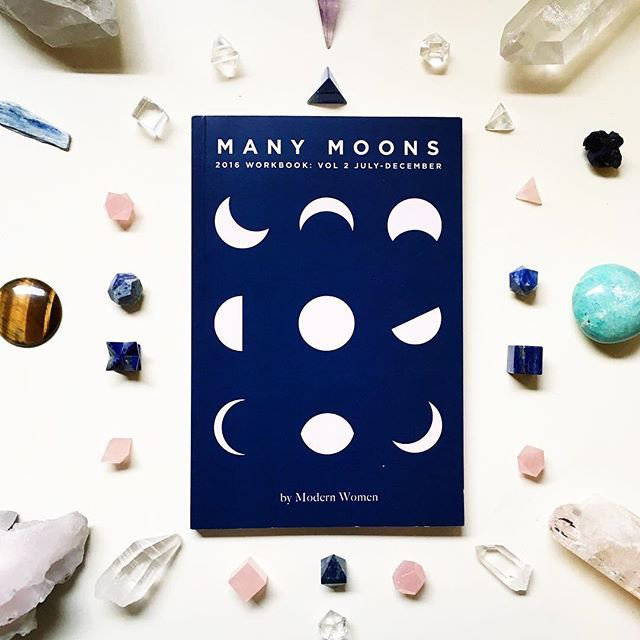
Sarah’s Many Moons Workbook is a best-seller. Photo via The Radder.
How does being LGBTQ impact on your business (if at all)?
Being queer has of course impacted my philosophies, my priorities, my empathy, compassion-levels and my world-view. Obviously it’s shaped the personal/political design and art I create.
As a Tarot reader, it’s widened my scope and range. Assumptions don’t help anyone, and I think being a passing self-identified lesbian with a passing trans partner has sure taught me about the ins and outs of all that. I try to widen that lack of judgement to all humans in my spiritual work. Personally, I’m not catering to a specific sexuality or gender. You could be purple or an alien or a bulldog, what do I care? (I’d love to work with a purple bulldog alien, actually, how cute would that be?) At the end of our lives we are all going to the same place, we all have the same feelings, just rearranged in different patterns at different times. I think most people that book Tarot readings with me know I’m a feminist and know I’m a queer.
There’s no reason for my freelance graphic design clients to know my sexuality. It is not like I’m hiding it, there’s just no reason for it to come up. In those cases it’s much more important that I’m talented, timely, professional, a clear communicator and trustworthy.
What three websites, blogs, books or people do you rate for business advice or ideas about your work?
My financial ‘advisor’ Paco is really great and has helped me so much. I’d recommend working with Paco to anyone in the greater LA area who wants to get a grip on their business.
The writer and teacher Esme Wang is amazing, she offers advice for those ambitious souls who have chronic, debilitating illnesses. Before her, I hadn’t really found a creative who so bravely discussed creating through limitations. Its been heartening to read her journals and be reminded I’m not alone in my struggles with chronic illness.
Paul Jarvis has good topics and helpful tips. I appreciate his transparency about his business, his process, and his habits.
What’s your hot tip for queer women who want to start their own business?
Be as kind as you can be to everyone. Don’t be afraid to stick to your boundaries. Make sure you have like 2-3 super tight or trustworthy friends or family that can be there for you emotionally while you deal with the highs and lows of working for yourself.
For goodness sake, be original. The plethora of copycats now has become almost too much to bear. Work through your own ideas, create your own authentic work that is unique. This world needs your special voice!
Define your key values early on (these will change). Is your top value getting better at your craft? Is it making as much bank as humanely possible? Shape your days accordingly. Annie Dillard wrote: “How we spend our days is, of course, how we spend our lives.” Examine how exactly you’d like to spend your days.
Find more of Sarah’s work at sarahgottesdiener.com, buy goodies from her online store, Modern Women, or check out her site on Tarot and the Moon cycles at Visual Magic. You can also keep up with Sarah on Instagram.
Are you following your arrow? Making a living doing what you love…or trying to? I’d love to hear about it! Drop a line to beth at autostraddle dot com with a description of your work and a link to your website.
I’m interested in entrepreneurs, side-hustlers, founders of charities, freelancers and all the other people who eschew employment to do their own thing. As always, I’d be especially excited to hear from women of colour, trans women and people who are working in the margins.
Fool’s Journey: Using Tarot Cards to Figure Out Timings

Header by Rory Midhani
I know, I know. I’m not a predictive tarot reader, and neither are many of you. But. There’s this whole fascinating school of thought around using tarot cards to predict roughly — or precisely —when a thing is going to happen, and today I want to take a look at some of the approaches you can use to do this.
If you’re not a predictive reader, don’t be too quick to write this stuff off. The suggestions below work not only for predictive work, but also to answer other kinds of ‘when’ questions, such as ‘when should I…?’ or ‘when is a good time for…?’ Even if you’re not into using tarot for prediction, you can incorporate these ideas into your planning work.
You can mix and match from the suggestions below, none of these are ‘rules’. Or you can come up with your own methods. You do you, folks!
The tarot deck featured is the Wildwood Tarot, a deck in which almost all cards are renamed (though it still follows the usual tarot system). The calendar and datebook are the Earth Pathways diaries.
Seasons and Suits
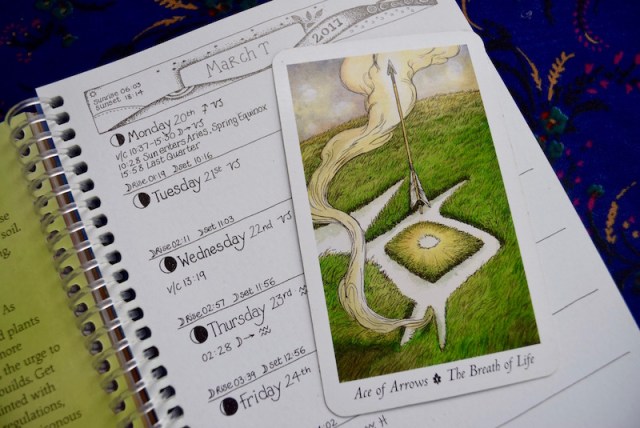
The four suits of tarot may correspond to the four seasons, giving you a very general idea when something is going to/should happen. You could remove all major cards so you’re left only with the minors, then shuffle and pick a card. Alternatively, you could use this as part of a bigger reading, looking to see which suit features the most heavily in the entire spread. (This applies to most of the techniques listed here.)
Here are the correspondences I work with:
Spring – Swords
Summer – Wands
Autumn – Cups
Winter – Pentacles
Note that other readers use different pairings of suits and seasons. These feel really right to me — the energy of each of these suits fits well with the feeling of each of the seasons. As always, it’s 100% okay to form your own correspondences, depending on what feels right to you.
You might decide that any card in this suit could represent the season. Another approach is to say that it is only the Ace (or some folks say the Page) of that suit.
Days of the Week
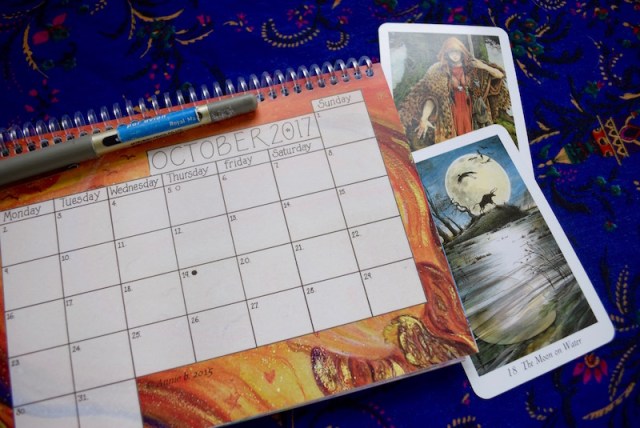
Each day of the week is associated with a Greek/Roman god, and thus also a planet. And guess what? Each planet has a corresponding tarot card!
Monday – Moon – The High Priestess / The Moon
Tuesday – Mars – The Tower
Wednesday – Mercury – The Magician
Thursday – Jupiter – The Wheel of Fortune
Friday – Venus – The Empress
Saturday – Saturn – The World
Sunday – Sun – The Sun
Q. Which day should I set aside for my tax return?
A. The World – Saturday (Saturday? Seriously, tarot cards?)
Again, you could pull just these seven cards from your deck, then pick one at random to find your answer, or you could do a bigger reading around your question, and look to see if one of these pops up in an auspicious position.
Visual clues
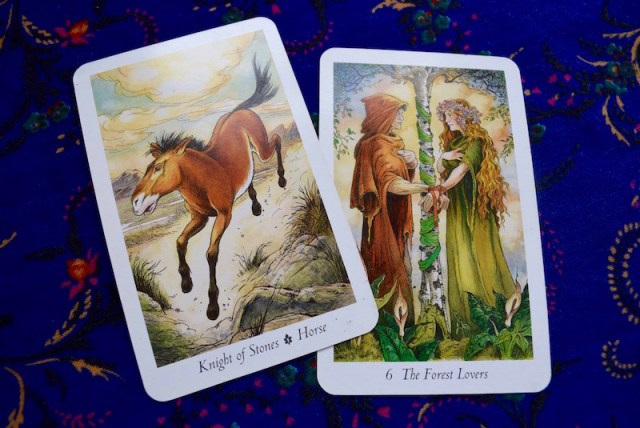
Look for symbols and other clues in the card images to tell you when to act. This has got to be my favourite method, as it’s much more interpretive, and less defined. You can go as simple or as nuanced as you like with this.
Q. When should I write a heartfelt letter to the friend I’ve fallen out with?
A. Knight of Stones: When you next see a horse, it’s time to write.
A. The Forest Lovers: When the birch tree has fresh green leaves and calla lilies are in flower.
Counting cards
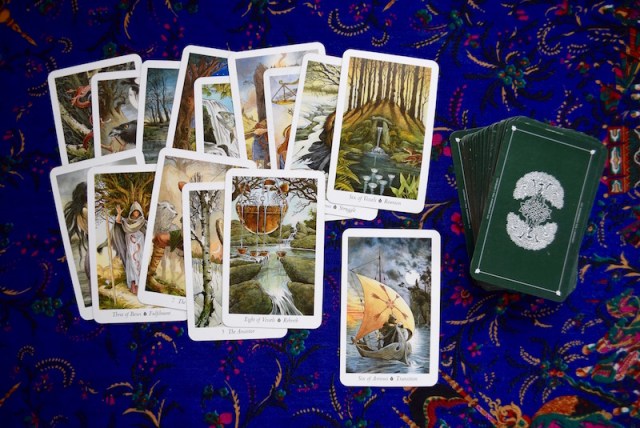
15 days til my trip to Orkney!
One fun practice for figuring out how many days (or weeks, months or years if you like) it will be until a certain event is to flip cards. Choose a card that represents the event you’re asking about — for example, the Six of Swords for a journey, the Four of Wands for a party, the Two of Cups for asking someone out, the Tower for quitting your job.
Shuffle your cards, whilst asking a clear question: ‘How many days should I wait until I ask for her number?’ or ‘How many days til she asks me out?’ Then turn them over one by one until your card appears! The number of cards you’ve turned over is your answer!
Card numbers
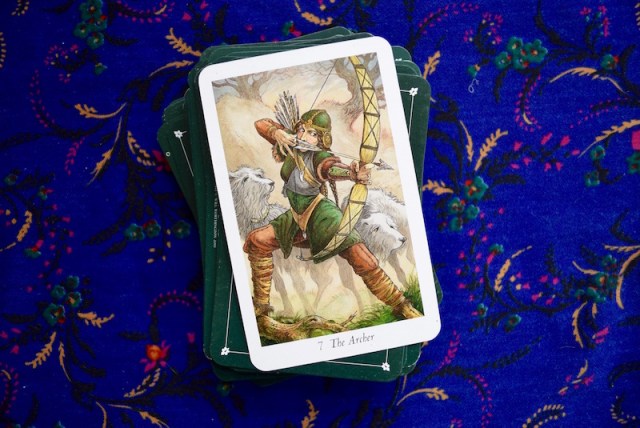
You can approach this with a ‘how many days/weeks/months…’ question like those above, but here, instead of counting cards, shuffle and pick one. The number on the card is your answer! Ace is one, Page, Knight, Queen and King are 11-14.
Astrological signs
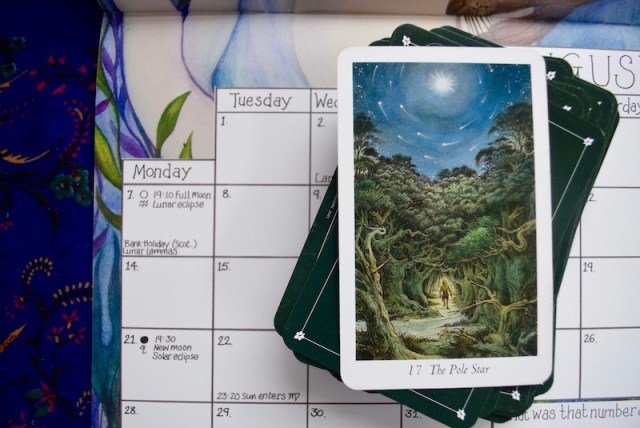
Each astrological sign has an associated major arcana tarot card:
Aries – The Emperor
Taurus – The Hierophant
Gemini – The Lovers
Cancer – The Chariot
Leo – Strength
Virgo – The Hermit
Libra – Justice
Scorpio – Death
Sagittarius – Temperance
Capricorn – The Devil
Aquarius – The Star
Pisces – The Moon
The most obvious answer derived using this question would be ‘when the Sun is in the sign of…’. (Here’s a quick guide to the dates of each sign.) You could decide that the answer is any time during this phase, or alternatively, the exact date (and even time) that the sun enters that sign.
You might prefer instead to go by the moon, as in ‘when the full moon is in Aries’ (which it was last weekend) or ‘when the new moon is Sagittarius’, again giving you an exact date.
I’d love to hear from other folks who use tarot for prediction, or to decide the best dates for doing things! If you’re a predictive reader, what methods do you prefer? Has anyone out there made up their own?
